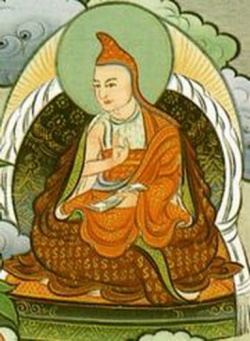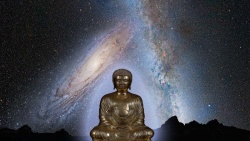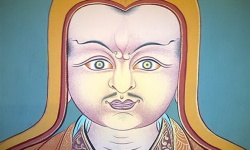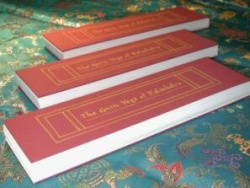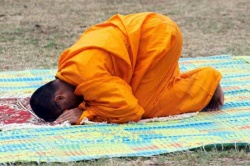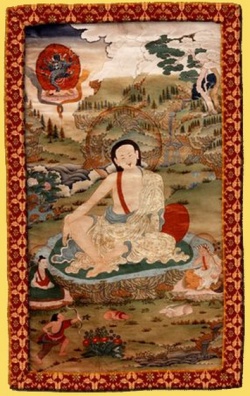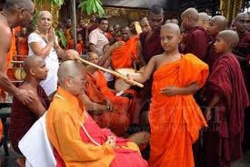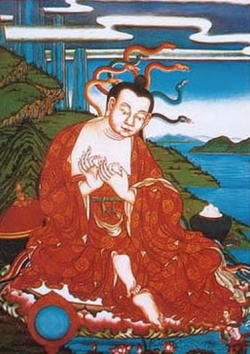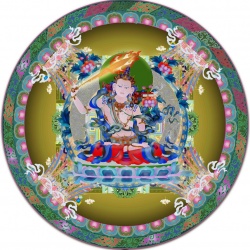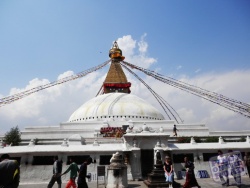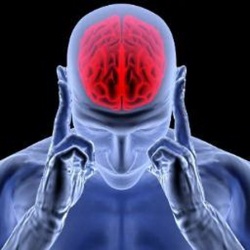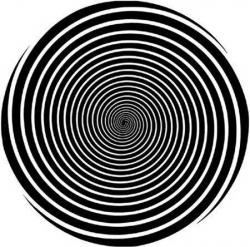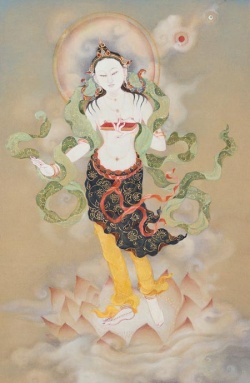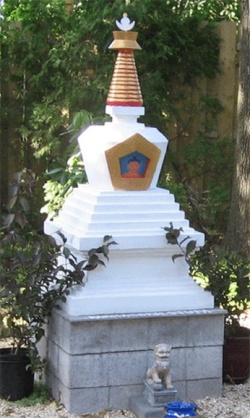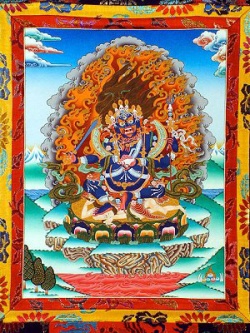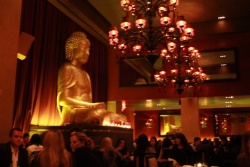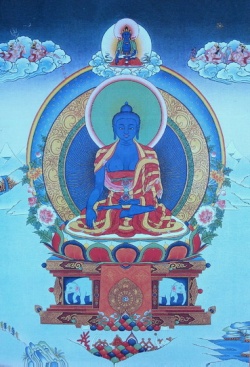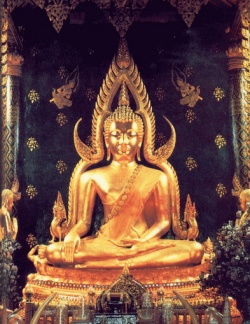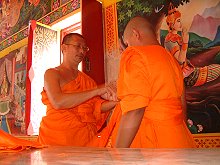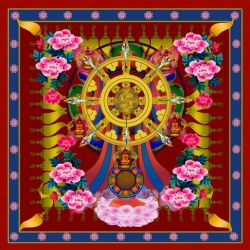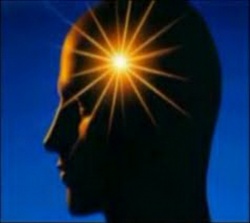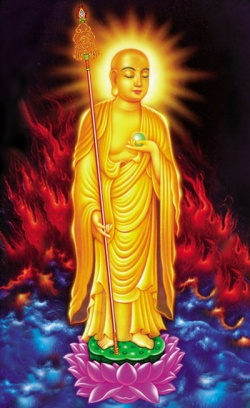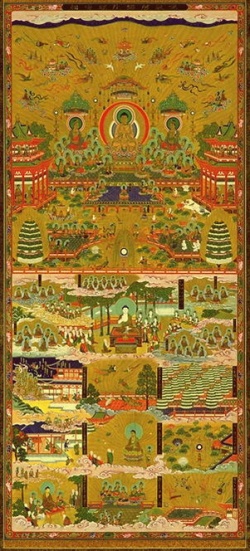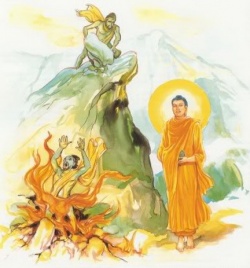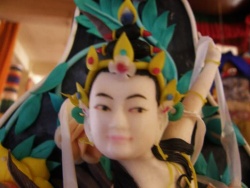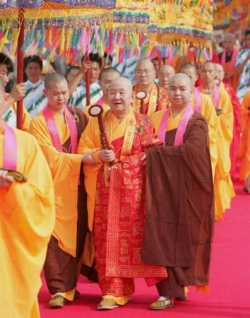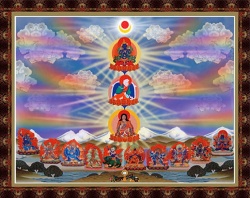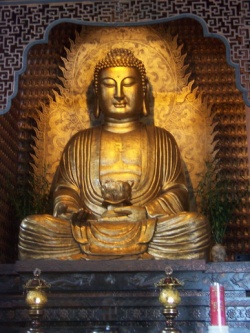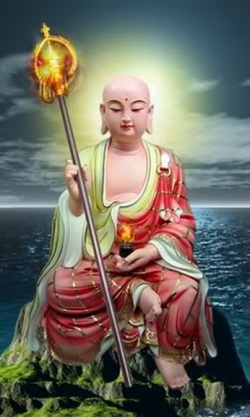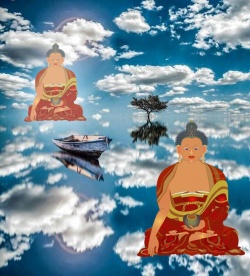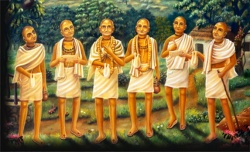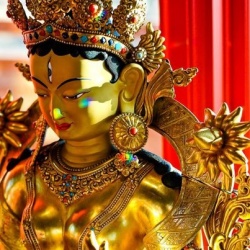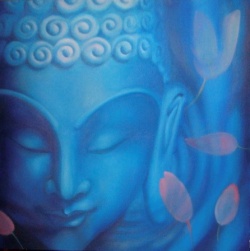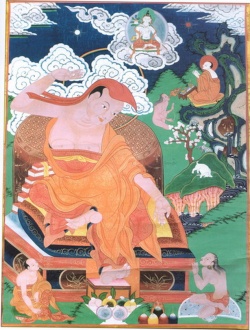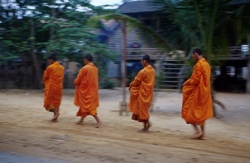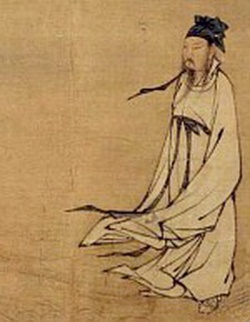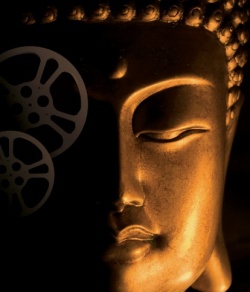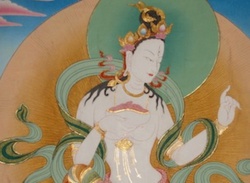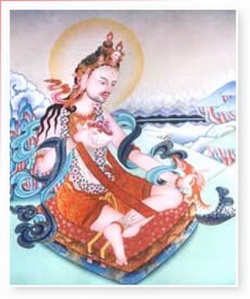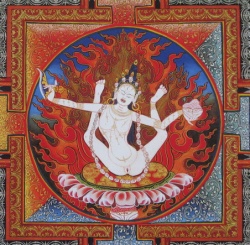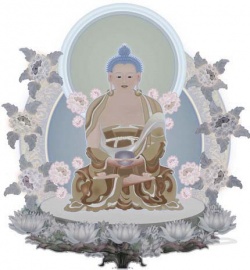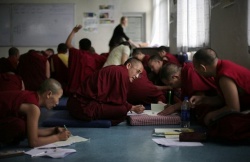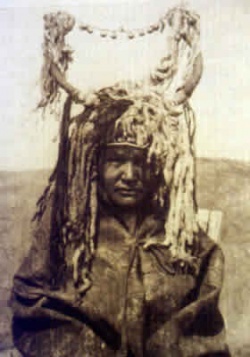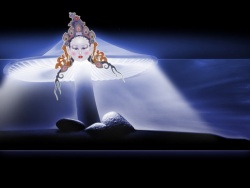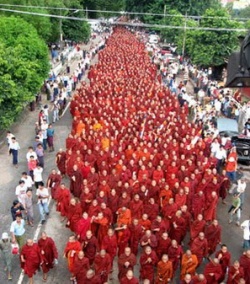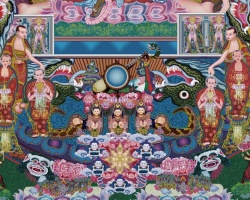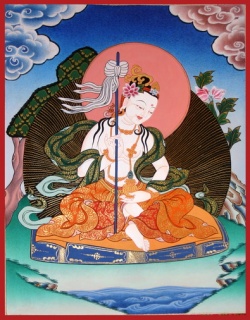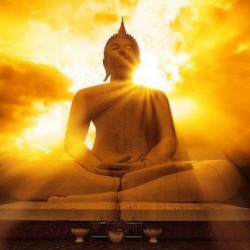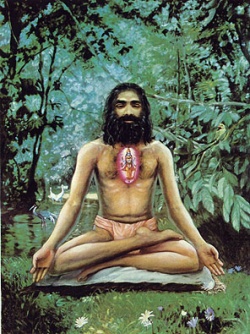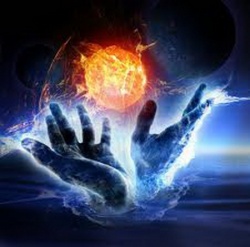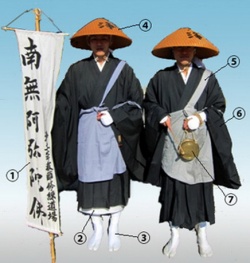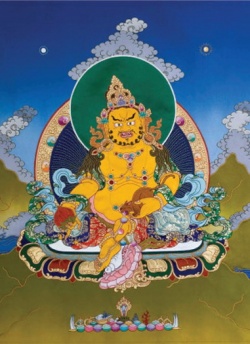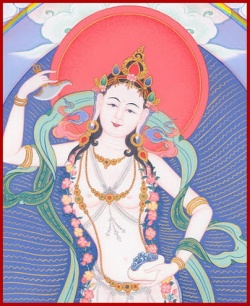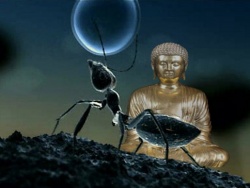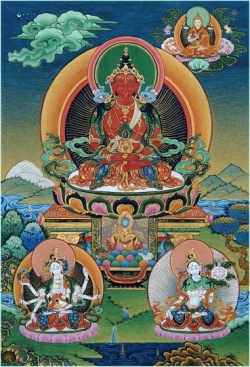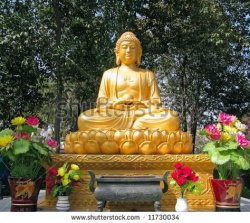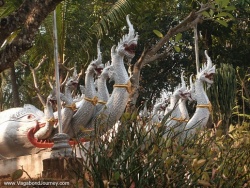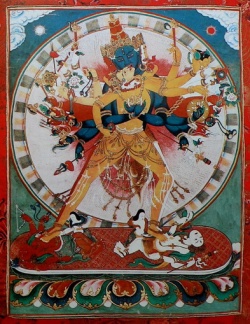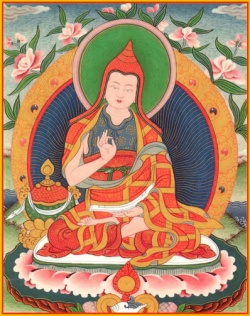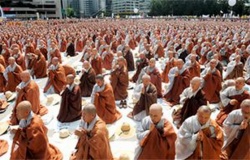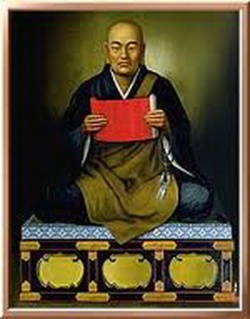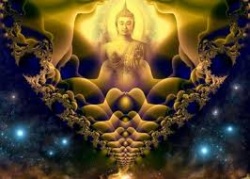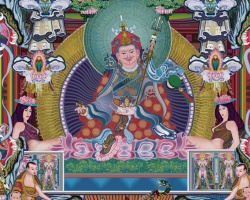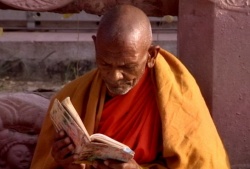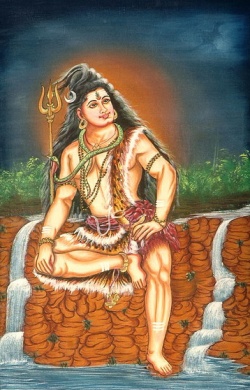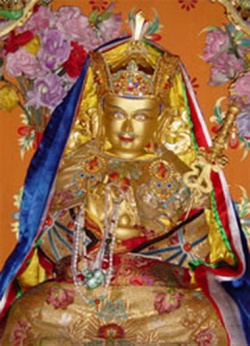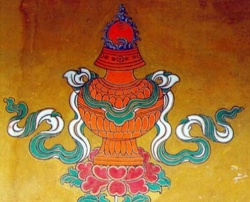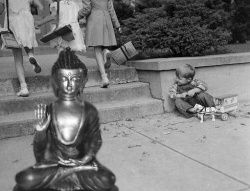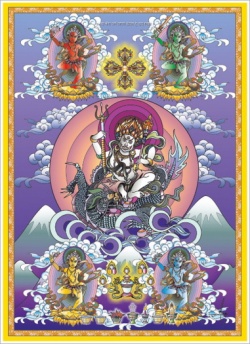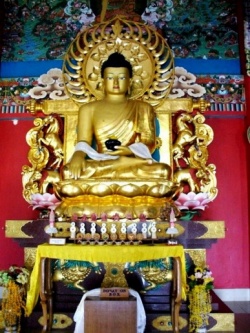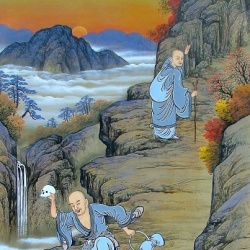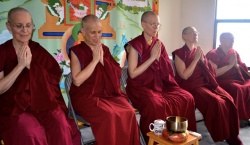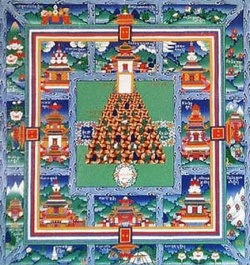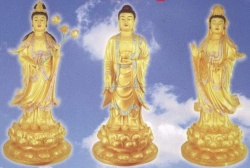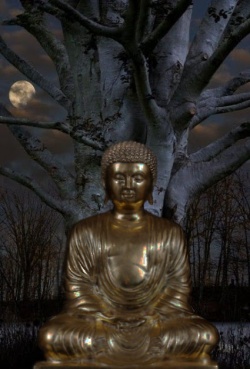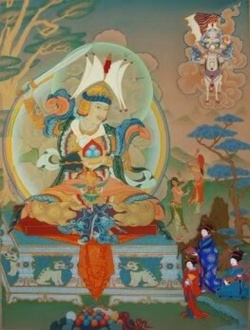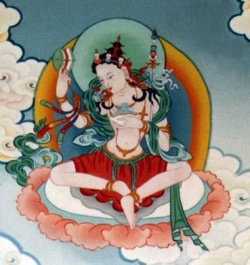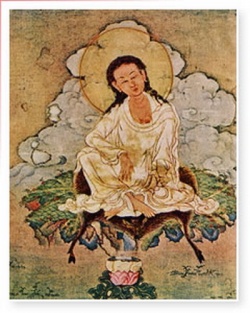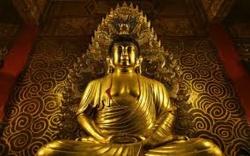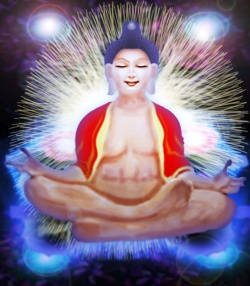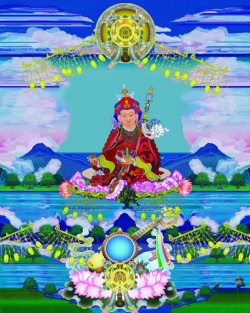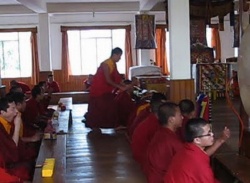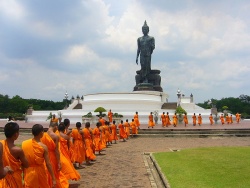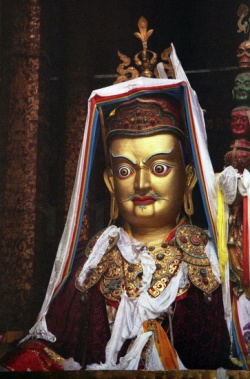The Nyāya-Vaiśeṣika Philosophy
Criticism of Buddhism and Sāṃkhya from the Nyāya standpoint.
The Buddhists had upset all common sense convictions of substance and attribute, cause and effect, and permanence of things, on the ground that all collocations are momentary; each group of collocations exhausts itself in giving rise to another group and that to another and so on. But if a collocation representing milk generates the collocation of curd it is said to be due to a joint action of the elements forming the cause-collocation and the modus operandi is unintelligible; the elements composing the cause-collocation cannot separately generate the elements composing the effect-collocation, for on such a supposition it becomes hard to maintain the doctrine of momentariness as the individual and separate exercise of influence on the part of the cause-elements and their coordination and manifestation as effect cannot but take more than one moment.
The supposition that the whole of the effect-collocation is the result of the joint action of the elements of cause-collocation is against our universal uncontradicted experience that specific elements constituting the cause (e.g. the whiteness of milk) are the cause of other corresponding elements of the effect (e.g. the whiteness of the curd); and we could not say that the hardness, blackness, and other properties of the atoms of iron in a lump state should not be regarded as the cause of similar qualities in the iron ball, for this is against the testimony of experience. Moreover there would be no difference between material (upādāna, e.g. clay of the jug), instrumental and concomitant causes (nimitta and saJiakāri, such as the potter, and the wheel, the stick etc. in forming the jug), for the causes jointly produce the effect, and there was no room for distinguishing the material and the instrumental causes, as such.
Again at the very moment in which a cause-collocation is brought into being, it cannot exert its influence to produce its [Page 275] effect-collocation. Thus after coming into being it would take the cause-collocation at least another moment to exercise its influence to produce the effect. How can the thing which is destroyed the moment after it is born produce any effect ? The truth is that causal elements remain and when they are properly collocated the effect is produced. Ordinary experience also shows that we perceive things as existing from a past time. The past time is perceived by us as past, the present as present and the future as future and things are perceived as existing from a past time onwards.
The Sāṃkhya assumption that effects are but the actualized states of the potential cause, and that the causal entity holds within it all the future series of effects, and that thus the effect is already existent even before the causal movement for the production of the effect, is also baseless. Sāṃkhya says that the oil was already existent in the sesamum and not in the stone, and that it is thus that oil can be got from sesamum and not from the stone. The action of the instrumental cause with them consists only in actualizing or manifesting what was already existent in a potential form in the cause. This is all nonsense. A lump of clay is called the cause and the jug the effect; of what good is it to say that the jug exists in the clay since with clay we can never carry water? A jug is made out of clay, but clay is not a jug. What is meant by saying that the jug was unmanifested or was in a potential state before, and that it has now become manifest or actual ? What does potential state mean ? The potential state of the j ug is not the same as its actual state; thus the actual state of the jug must be admitted as non-existent before. If it is meant that the jug is made up of the same parts (the atoms) of which the clay is made up, of course we admit it, but this does not mean that the jug was existent in the atoms of the lump of clay. The potency inherent in the clay by virtue of which it can expose itself to the influence of other agents, such as the potter, for being transformed into a jug is not the same as the effect, the jug. Had it been so, then we should rather have said that the jug came out of the jug.
The assumption of Sāṃkhya that the substance and attribute have the same reality is also against all experience, for we all perceive that movement and attribute belong to substance and not to attribute. Again Sāṃkhya holds a preposterous doctrine that buddhi is different [Page 276] from intelligence. It is absolutely unmeaning to call buddhi non-intelligent. Again what is the good of all this fictitious fuss that the qualities of buddhi are reflected on puruṣa and then again on buddhi. Evidently in all our experience we find that the soul (ātman) knows, feels and wills, and it is difficult to understand why Sāṃkhya does not accept this patent fact and declare that knowledge, feeling, and willing, all belonged to buddhi. Then again in order to explain experience it brought forth a theory of double reflection.
Again Sāṃkhya prakṛti is non-intelligent, and where is the guarantee that she (prakṛti) will not bind the wise again and will emancipate him once for all ? Why did the puruṣa become bound down ? Prakṛti is being utilized for enjoyment by the infinite number of puruṣas, and she is no delicate girl (as Sāṃkhya supposes) who will leave the presence of the puruṣa ashamed as soon as her real nature is discovered. Again pleasure (sukha), sorrow (duhkha) and a blinding feeling through ignorance (moha) are but the feeling-experiences of the soul, and with what impudence could Sāṃkhya think of these as material substances? Again their cosmology of a mahat, ahaṃkāra, the tanmātras, is all a series of assumptions never testified by experience nor by reason. They are all a series of hopeless and foolish blunders. The phenomena of experience thus call for a new careful reconstruction in the light of reason and experience such as cannot be found in other systems. (See Nyāyamañjarī, pp. 452-466 and 490-496.)
Nyāya and Vaiśeṣika sūtras.
It is very probable that the earliest beginnings of Nyāya are to be found in the disputations and debates amongst scholars trying to find out the right meanings of the Vedic texts for use in sacrifices and also in those disputations which took place between the adherents of different schools of thought trying to defeat one another. I suppose that such disputations occurred in the days of the Upaniṣads, and the art of disputation was regarded even then as a subject of study, and it probably passed then by the name of vākovākya. Mr Bodas has pointed out that Apastamba who according to Biihler lived before the third century B.C. used the word Nyāya in the sense of Mīmāmsā1. The word Nyāya derived [Page 277] from the root nī is sometimes explained as that by which sentences and words could be interpreted as having one particular meaning and not another, and on the strength of this even Vedic accents of words (which indicate the meaning of compound words by pointing out the particular kind of compound in which the words entered into combination) w'ere called Nyāya2. Prof. Jacobi on the strength of Kautilya’s enumeration of the vidyā (sciences) as Anvīkṣikī (the science of testing the perceptual and scriptural knowledge by further scrutiny), trayī (the three Vedas), vārttā (the sciences of agriculture, cattle keeping etc.), and dandanīti (polity), and the enumeration of the philosophies as Sāṃkhya, Yoga, Lokāyata and Anvīkṣikī, supposes that the Nyāya sūtra was not in existence in Kautilya’s time 300 B.C.)3.
Kautilya’s reference to Nyāya as Anvīkṣikī only suggests that the word Nyāya was not a familiar name for Anvīkṣikī in Kautilya’s time. He seems to misunderstand Vātsyāyana in thinking that Vātsyāyana distinguishes Nyāya from the Anvīkṣikī in holding that while the latter only means the science of logic the former means logic as well as metaphysics. What appears from Vātsyāyana’s statement in Nyāya sūtra I. i. r is this that he points out that the science which was known in his time as Nyāya was the same as was referred to as Anvīkṣikī by Kautilya. He distinctly identifies Nyāyavidyā with Anvīkṣikī, but justifies the separate enumeration of certain logical categories such as saviśaya (doubt) etc., though these were already contained within the first two terms Pramāṇa (means of cognition) and prameya (objects of cognition), by holding that unless these its special and separate branches (pṛthakprasthāna) were treated, Nyāyavidyā would simply become metaphysics (adhyātmavidyā) like the Upaniṣads.
The old meaning of Nyāya as the means of determining the right meaning or the right thing is also agreed upon by Vātsyāyana and is sanctioned by Vācaspati in his Nyāyavārt-tikatātparyaṭīkā I. i. 1). He compares the meaning of the word Nyāya (Pramāṇairarthaparīkṣaṇam —to scrutinize an object by means of logical proof) with the etymological meaning of the word ānvīkṣikī (to scrutinize anything after it has been known by perception and scriptures). Vātsyāyana of course points out that so far as this logical side of Nyāya is concerned it has the widest scope for [Page 278] itself as it includes all beings, all their actions, and all the sciences4. He quotes Kautilya to show that in this capacity Nyāya is like light illumining all sciences and is the means of all works. In its capacity as dealing with the truths of metaphysics it may show the way to salvation.
I do not dispute Prof. Jacobi’s main point that the metaphysical portion of the work was a later addition, for this seems to me to be a very probable view. In fact Vātsyāyana himself designates the logical portion as a pṛthakprasthāna (separate branch). But I do not find that any statement of Vātsyāyana or Kautilya can justify us in concluding that this addition was made after Kautilya. Vātsyāyana has no doubt put more stress on the importance of the logical side of the work, but the reason of that seems to be quite obvious, for the importance of metaphysics or adhyātmavidyā was acknowledged by all. But the importance of the mere logical side would not appeal to most people. None of the dharmaśāstras (religious scriptures) or the Vedas would lend any support to it, and Vātsyāyana had to seek the support of Kautilya in the matter as the last resource. The fact that Kautilya was not satisfied by counting Anvīkṣikī as one of the four vidyās but also named it as one of the philosophies side by side with Sāṃkhya seems to lead to the presumption that probably even in Kautilya’s time Nyāya was composed of two branches, one as adhyātmavidyā and another as a science of logic or rather of debate.
This combination is on the face of it loose and external, and it is not improbable that the metaphysical portion was added to increase the popularity of the logical part, which by itself might not attract sufficient attention. Mahāmahopādhyāya Haraprasāda Śāstrī in an article in the Journal of the Bengal Asiatic Society 1905 says that as Vācaspati made two attempts to collect the Nyāya sūtras, one as Nyāyasūci and the other as Nyāyasūtroddhāra, it seems that even in Vācaspati’s time he was not certain as to the authenticity of many of the Nyāya sūtras. He further points out that there are unmistakable signs that many of the sūtras were interpolated, and relates the Buddhist tradition from China and Japan that Mirok mingled Nyāya and Yoga.
He also [Page 279] thinks that the sūtras underwent two additions, one at the hands of some Buddhists and another at the hands of some Hindu who put in Hindu arguments against the Buddhist ones. These suggestions of this learned scholar seem to be very probable, but we have no clue by which we can ascertain the time when such additions were made. The fact that there are unmistakable proofs of the interpolation of many of the sūtras makes the fixing of the date of the original part of the Nyāya sūtras still more difficult, for the Buddhist references can hardly be of any help, and Prof. Jacobi’s attempt to fix the date of the Nyāya sūtras on the basis of references to Sūṅyavāda naturally loses its value, except on the supposition that all references to Śūnyavāda must be later than Nāgārjuna, which is not correct, since the Mahāyāna sūtras written before Nāgārjuna also held the Sūṅyavāda doctrine.
The late Dr S. C. Vidyābhūṣaṇa in J.R.A.S. 1918 thinks that the earlier part of Nyāya was written by Gautama about 550 B.C. whereas the Nyāya sūtras of Akṣapāda were written about 150 A.D. and says that the use of the word Nyāya in the sense of logic in Mahābhārata I. I. 67, I. 70. 42-51, must be regarded as interpolations. He, however, does not give any reasons in support of his assumption. It appears from his treatment of the subject that the fixing of the date of Akṣapāda was made to fit in somehow with his idea that Akṣapāda wrote his Nyāya sūtras under the influence of Aristotle—a supposition which does not require serious refutation, at least so far as Dr Vidyābhūṣaṇa has proved it. Thus after all this discussion we have not advanced a step towards the ascertainment of the date of the original part of the Nyāya. Goldstūcker says that both Patañjali (140 B.C.) and Kātyāyana (fourth century B.C.) knew the Nyāya sūtras5. We know that Kautilya knew the Nyāya in some form as Anvīkṣikī in 300 B.C., and on the strength of this we may venture to say that the Nyāya existed in some form as early as the fourth century B.C. But there are other reasons which lead me to think that at least some of the present sūtras were written some time in the second century A.D. Bodas points out that Bādarāyaṇa s sūtras make allusions to the Vaiśeṣika doctrines and not to Nyāya.
On this ground he thinks that Vaiśeṣika sūtras were written before Bādarāyana’s Brahma-sūtras , whereas the Nyāya sūtras were written later. Candrakānta Tarkālaṃkāra also contends in his [Page 280] edition of Vaiśeṣika that the Vaiśeṣika sūtras were earlier than the Nyāya. It seems to me to be perfectly certain that the Vaiśeṣika sūtras were written before Caraka (80 A.D.); for he not only quotes one of the Vaiśeṣika sūtras , but the whole foundation of his medical physics is based on the Vaiśeṣika physics6. The Laṅkāvatāra sūtra (which as it was quoted . by Aśvaghoṣa is earlier than 80 A.D.) also makes allusions to the atomic doctrine. There are other weightier grounds, as we shall see later on, for supposing that the Vaiśeṣika sūtras are probably pre-Buddhistic7.
It is certain that even the logical part of the present Nyāya sūtras was preceded by previous speculations on the subject by thinkers of other schools. Thus in commenting on I. i. 32 in which the sūtra states that a syllogism consists of five premisses (avayava) Vātsyāyana says that this sūtra was written to refute the views of those who held that there should be ten premisses8. The Vaiśeṣika sūtras also give us some of the earliest types of inference, which do not show any acquaintance with the technic of the Nyāya doctrine of inference9.
Does Vaiśeṣika represent an Old School of Mīmāmsā ?
The Vaiśeṣika is so much associated with Nyāya by tradition that it seems at first sight quite unlikely that it could be supposed to represent an old school of Mīmāmsā, older than that represented in the Mīmāmsā sūtras. But a closer inspection of the Vaiśeṣika sūtras seems to confirm such a supposition in a very remarkable way. We have seen in the previous section that Caraka quotes a Vaiśeṣika sūtra. An examination of Caraka’s Sūtrasthāna (1. 35-38) leaves us convinced that the writer of the verses had some compendium of Vaiśeṣika such as that of the Bhāṣāpariccheda before him. Caraka sūtra or kārikā (i. i. 36) says that the guṇas are those which have been enumerated such as heaviness, etc., cognition, and those which begin with the guṇa “para” (universality) and end with “prayatna” (effort) together with the sense-qualities (sārthā). It seems that this is a reference to some well-known enumeration.
But this enumeration is not to be found in the Vaiśeṣika sūtra (I. i. 6) which leaves out the six guṇas,
[Page 281] heaviness (gurutva),
liquidity (dravatva),
oiliness (sneha),
elasticity (saṃskāra),
merit (dharma)
and demerit (adharma);
in one part of the sūtra the enumeration begins with “para” (universality) and ends in “prayatna,” but buddhi (cognition) comes within the enumeration beginning from para and ending in prayatna, whereas in Caraka buddhi does not form part of the list and is separately enumerated. This leads me to suppose that Caraka’s sūtra was written at a time when the six guṇas left out in the Vaiśeṣika enumeration had come to be counted as guṇas, and compendiums had been made in which these were enumerated.
Bhāṣāpariccheda (a later Vaiśeṣika compendium), is a compilation from some very old kārikās which are referred to by Viśvanātha as being collected from “atisaṃkṣiptacirantanoktibhiḥ”—(from very ancient aphorisms10); Caraka’s definition of sāmānya and viśeṣa shows that they had not then been counted as separate categories as in later Nyāya-Vaiśeṣika doctrines; but though slightly different it is quite in keeping with the sort of definition one finds in the Vaiśeṣika sūtra that sāmānya (generality) and viśeṣa are relative to each other11. Caraka’s sūtras were therefore probably written at a time when the Vaiśeṣika doctrines were undergoing changes, and well-known compendiums were beginning to be written on them.
The Vaiśeṣika sūtras seem to be ignorant of the Buddhist doctrines. In their discussions on the existence of soul, there is no reference to any view as to non-existence of soul, but the argument turned on the point as to whether the self is to be an object of inference or revealed to us by our notion of “I.” There is also no other reference to any other systems except to some Mīmāmsā doctrines and occasionally to Sāṃkhya. There is no reason to suppose that the Mīmāmsā doctrines referred to allude to the Mīmāmsā sūtras of Jaimini. The manner in which the nature of inference has been treated shows that the Nyāya phraseology of “pūrvavat” and “śesavat" was not known. Vaiśeṣika sūtras in more than one place refer to time as the ultimate cause12. We know that the Śvetāśvatara Upaniṣad refers to those who regard time as the cause of all things, but in none of the [Page 282] systems that we have can we trace any upholding of this ancient view13. These considerations as well as the general style of the work and the methods of discussion lead me to think that these sūtras are probably the oldest that we have and in all probability are pre-Buddhistic.
The Vaiśeṣika sūtra begins with the statement that its object is to explain virtue, “dharma.” This is we know the manifest duty of Mīmāmsā and we know that unlike any other system Jaimini begins his Mīmāmsā sūtras by defining “dharma.” This at first seems irrelevant to the main purpose of Vaiśeṣika, viz., the description of the nature of padārtha14. He then defines dharma as that which gives prosperity and ultimate good (nihśreyasa) and says that the Veda must be regarded as valid, since it can dictate this. He ends his book with the remarks that those injunctions (of Vedic deeds) which are performed for ordinary human motives bestow prosperity even though their efficacy is not known to us through our ordinary experience, and in this matter the Veda must be regarded as the authority which dictates those acts15.
The fact that the Vaiśeṣika begins with a promise to describe dharma and after describing the nature of substances, qualities and actions and also the adṛṣṭa (unknown virtue) due to dharma (merit accruing from the performance of Vedic deeds) by which many of our unexplained experiences may be explained, ends his book by saying that those Vedic works which are not seen to produce any direct effect, will produce prosperity through adṛṣṭa, shows that Kaṇāda’s method of explaining dharma has been by showing that physical phenomena involving substances, qualities, and actions can only be explained up to a certain extent while a good number cannot be explained at all except on the assumption of adṛṣṭa (unseen virtue) produced by dharma.
The [Page 283] description of the categories of substance is not irrelevant, but is the means of proving that our ordinary experience of these cannot explain many facts which are only to be explained on the supposition of adṛṣṭa proceeding out of the performance of Vedic deeds. In V. i. 15 the movement of needles towards magnets, in V. ii. 7 the circulation of water in plant bodies, v. ii. 13 and IV. ii. 7 the upward motion of fire, the side motion of air, the combining movement of atoms (by which all combinations have taken place), and the original movement of the mind are said to be due to adṛṣṭa. In v. ii. 17 the movement of the soul after death, its taking hold of other bodies, the assimilation of food and drink and other kinds of contact (the movement and development of the foetus as enumerated in Upciskāra) are said to be due to adṛṣṭa.
Salvation (mokṣa) is said to be produced by the annihilation of adṛṣṭa leading to the annihilation of all contacts and non-production of rebirths. Vaiśeṣika marks the distinction between the dṛṣṭa (experienced) and the adṛṣṭa. All the categories that he describes are founded on dṛṣṭa (experience) and those unexplained by known experience are due to adṛṣṭa.
These are the acts on which depend all life-process of animals and plants, the continuation of atoms or the construction of the worlds, natural motion of fire and air, death and rebirth (vi. ii. 15) and even the physical phenomena by which our fortunes are affected in some way or other (V. ii. 2), in fact all with which we are vitally interested in philosophy. Kaṇāda’s philosophy gives only some facts of experience regarding substances, qualities and actions, leaving all the graver issues of metaphysics to adṛṣṭa. But what leads to adṛṣṭa?
In answer to this, Kaṇāda does not speak of good or bad or virtuous or sinful deeds, but of Vedic works, such as
holy ablutions (snāna),
fasting,
holy student life (brahmacarya),
remaining at the house of the teacher (gurukulavāsa),
retired forest life (vānaprastha),
sacrifice (yajña),
gifts (dāna),
certain kinds of sacrificial sprinkling and rules of performing sacrificial works according to the prescribed time of the stars,
the prescribed hymns (mantras) (VI. ii. 2).
He described what is pure and what is impure food, pure food being that which is sacrificially purified (VI. ii. 5) the contrary being impure; and he says that the taking of pure food leads to prosperity through adṛṣṭa. He also described how [Page 284] feelings of attachment to things are also generated by adṛṣṭa. Throughout almost the whole of VI. i Kaṇāda is busy in showing the special conditions of making gifts and receiving them. A reference to our chapter on Mīmāmsā will show that the later Mīmāmsā writers agreed with the Nyāya-Vaiśeṣika doctrines in most of their views regarding substance, qualities, etc.
Some of the main points in which Mīmāmsā differs from Nyāya-Vaiśeṣika are
selfvalidity of the Vedas,
the eternality of the Vedas,
disbelief in any creator or god,
eternality of sound (śabda),
(according to Kumārila) direct perception of self in the notion of the ego.
Of these the first and the second points do not form any subject of discussion in the Vaiśeṣika. But as no Īśvara is mentioned, and as all adṛṣṭa depends upon the authority of the Vedas, we may assume that Vaiśeṣika had no dispute with Mīmāmsā. The fact that there is no reference to any dissension is probably due to the fact that really none had taken place at the time of the Vaiśeṣika sūtras. It is probable that Kaṇāda believed that the Vedas were written by some persons superior to us (II. i. 18, VI. i. 1-2). But the fact that there is no reference to any conflict with Mīmāmsā suggests that the doctrine that the Vedas were never written by anyone was formulated at a later period, whereas in the days of the Vaiśeṣika sūtras , the view was probably what is represented in the Vaiśeṣika sūtras.
As there is no reference to Īśvara and as adṛṣṭa proceeding out of the performance of actions in accordance with Vedic injunctions is made the cause of all atomic movements, we can very well assume that Vaiśeṣika was as atheistic or non-theistic as the later Mīmāmsā philosophers. As regards the eternality of sound, which in later days was one of the main points of quarrel between the Nyāya-Vaiśeṣika and the Mīmāmsā, we find that in II. ii. 25-32, Kaṇāda gives reasons in favour of the non-eternality of sound, but after that from II. ii. 33 till the end of the chapter he closes the argument in favour of the eternality of sound, which is the distinctive Mīmāmsā view as we know from the later Mīmāmsā writers16. Next comes the question of the proof of the existence of self. The traditional Nyāya view is [Page 285] that the self is supposed to exist because it must be inferred as the seat of the qualities of pleasure, pain, cognition, etc.
Traditionally this is regarded as the Vaiśeṣika view as well. But in Vaiśeṣika III. ii. 4 the existence of soul is first inferred by reason of its activity and the existence of pleasure, pain, etc., in III. ii. 6-7 this inference is challenged by saying that we do not perceive that the activity, etc. belongs to the soul and not to the body and so no certainty can be arrived at by inference, and in III. ii. 8 it is suggested that therefore the existence of soul is to be accepted on the authority of the scriptures (āgama). To this the final Vaiśeṣika conclusion is given that we can directly perceive the self in our feeling as “I” (ahavi), and we have therefore not to depend on the scriptures for the proof of the existence of the self, and thus the inference of the existence of the self is only an additional proof of what we already find in perception as “I” (aham) (ill. ii. 10-18, also IX. i. 11).
These considerations lead me to think that the Vaiśeṣika represented a school of Mīmāmsā thought which supplemented a metaphysics to strengthen the grounds of the Vedas.
Philosophy in the Vaiśeṣika sūtras.
The Vaiśeṣika sūtras begin with the ostensible purpose of explaining virtue (dharma) (I. i. 1) and dharma according to it is that by which prosperity (abhyudaya) and salvation (nihśreyasa) are attained. Then it goes on to say that the validity of the Vedas depends on the fact that it leads us to prosperity and salvation. Then it turns back to the second sūtra and says that salvation comes as the result of real knowledge, produced by special excellence of dharma, of the characteristic features of the categories of substance (dravya), quality (guna), class concept (sāmānya), particularity (viśeṣa), and inherence (samavāya)17. The dravyas are earth, water, fire, air, ether, time, space, soul, and mind.
The guṇas are colour, taste, odour, touch, number, measure, separations, contact, disjoining, quality of belonging to high genus or to species18. Action (karma) means upward movement [Page 286] , downward movement, contraction, expansion and horizontal movement. The three common qualities of dravya, guṇa and karma are that they are existent, non-eternal, substantive, effect, cause, and possess generality and particularity. Dravya produces other dravyas and the guṇas other guṇas. But karma is not necessarily produced by karma. Dravya does not destroy either its cause or its effect, but the guṇas are destroyed both by the cause and by the effect. Karma is destroyed by karma. Dravya possesses karma and guṇa and is regarded as the material (samavāyi) cause. Guṇas inhere in dravya, cannot possess further guṇas, and are not by themselves the cause of contact or disjoining.
Karma is devoid of guṇa, cannot remain at one time in more than one object, inheres in dravya alone, and is an independent cause of contact or disjoining. Dravya is the material cause (samavāyi) of (derivative) dravyas, guṇa, and karma; guṇa is also the nonmaterial cause (asamāvāyi) of dravya, guṇa and karma. Karma is the general cause of contact, disjoining, and inertia in motion (vega). Karma is not the cause of dravya. For dravya may be produced even without karma19. Dravya is the general effect of dravya. Karma is dissimilar to guṇa in this that it does not produce karma. The numbers two, three, etc., separateness, contact and disjoining are effected by more than one dravya. Each karma not being connected with more than one thing is not produced by more than one thing20. A dravya is the result of many contacts (of the atoms). One colour may be the result of many colours. Upward movement is the result of heaviness, effort and contact. Contact and disjoining are also the result of karma. In denying the causality of karma it is meant that karma is not the cause of dravya and karma21.
In the second chapter of the first book Kaṇāda first says that if there is no cause, there is no effect, but there may be the cause even though there may not be the effect. He next says that genus (sāmānya) and species (viśeṣa) are relative to the understanding; [Page 287] being (bhāva) indicates continuity only and is hence only a genus. The universals of substance, quality and action may be both genus and species, but viśeṣa as constituting the ultimate differences (of atoms) exists (independent of any percipient). In connection with this he says that the ultimate genus is being (sattā) in virtue of which things appear as existent; all other genera may only relatively be regarded as relative genera or species. Being must be regarded as a separate category, since it is different from dravya, guṇa and karma, and yet exists in them, and has no genus or species. It gives us the notion that something is and must be regarded as a category existing as one identical entity in all dravya, guṇa, and karma, for in its universal nature as being it has no special characteristics in the different objects in which it inheres. The specific universals of thingness (drcivyatva), qualitiness (guṇatva) or actionness (karmatva) are also categories which are separate from universal being (bhāva or sattā) for they also have no separate genus or species and yet may be distinguished from one another, but bhāva or being was the same in all.
In the first chapter of the second book Kaṇāda deals with substances. Earth possesses colour, taste, smell, and touch; water, colour, taste, touch, liquidity, and smoothness (snigdha); fire, colour and touch; air, touch; but none of these qualities can be found in ether (ākāśa). Liquidity is a special quality of water because butter, lac, wax, lead, iron, silver, gold, become liquids only when they are heated, while water is naturally liquid itself22. Though air cannot be seen, yet its existence can be inferred by touch, just as the existence of the genus of cows may be inferred from the characteristics of horns, tails, etc. Since this thing inferred from touch possesses motion and quality, and does not itself inhere in any other substance, it is a substance (dravya) and is eternal23. The inference of air is of the type of inference of imperceptible things from certain known characteristics called sāmānyato dṛṣṭa.
The name of air “vāyu” is derived from the scriptures. The existence of others different from us has (asmadviśiṣṭānām) to be admitted for accounting for the [Page 288] giving of names to things (saṃjñākarma). Because we find that the giving of names is already in usage (and not invented by us)24. On account of the fact that movements rest only in one thing, the phenomenon that a thing can enter into any unoccupied space, would not lead us to infer the existence of ākāśa (ether). Akāśa has to be admitted as the hypothetical substance in which the quality of sound inheres, because, since sound (a quality) is not the characteristic of things which can be touched, there must be some substance of which it is a quality. And this substance is ākāśa. It is a substance and eternal like air. As being is one so ākāśa is one25.
In the second chapter of the second book Kaṇāda tries to prove that smell is a special characteristic of earth, heat of fire, and coldness of water. Time is defined as that which gives the notion of youth in the young, simultaneity, and quickness. It is one like being. Time is the cause of all non-eternal things, because the notion of time is absent in eternal things. Space supplies the notion that this is so far away from this or so much nearer to this. Like being it is one. One space appears to have diverse inter-space relations in connection with the motion of the sun. As a preliminary to discussing the problem whether sound is eternal or not, he discusses the notion of doubt, which arises when a thing is seen in a general way, but the particular features coming under it are not seen, either when these are only remembered, or when some such attribute is seen which resembles some other attribute seen before, or when a thing is seen in one way but appears in another, or when what is seen is not definitely grasped, whether rightly seen or not. He then discusses the question whether sound is eternal or non-eternal and gives his reasons to show that it is non-eternal, but concludes the discussion with a number of other reasons proving that it is eternal.
The first chapter of the third book is entirely devoted to the inference of the existence of soul from the fact that there must be some substance in which knowledge produced by the contact of the senses and their object inheres.
The knowledge of sense-objects (indriyārtha) is the reason by [Page 289] which we can infer the existence of something different from the senses and the objects which appear in connection with them.
The types of inferences referred to are
inference of non-existence of some things from the existence of some things,
of the existence of some things from the non-existence of some things,
of the existence of some things from the existence of others.
In all these cases inference is possible only when the two are known to be connected with each other (prasiddhipūrvakatvāt apadeśasya)26. When such a connection does not exist or is doubtful, we have anapadeśa (fallacious middle) and sandigdha (doubtful middle);, thus, it is a horse because it has a horn, or it is a cow because it has a horn are examples of fallacious reason. The inference of soul from the cognition produced by the contact of soul, senses and objects is not fallacious in the above way. The inference of the existence of the soul in others may be made in a similar way in which the existence of one’s own soul is inferred27, i.e. by virtue of the existence of movement and cessation of movement. In the second chapter it is said that the fact that there is cognition only when there is contact between the self, the senses and the objects proves that there is manas (mind), and this manas is a substance and eternal, and this can be proved because there is no simultaneity of production of efforts and various kinds of cognition; it may also be inferred that this manas is one (with each person).
The soul may be inferred from inhalation, exhalation, twinkling of the eye, life, the movement of the mind, the sense-affections pleasure, pain, will, antipathy, and effort. That it is a substance and eternal can be proved after the manner of vāyu. An objector is supposed to say that since when I see a man I do not see his soul, the inference of the soul is of the type of sāmānycitodṛṣṭa inference, i.e., from the perceived signs of pleasure, pain, cognition to infer an unknown entity to which they belong, but that this was the self could not be affirmed. So the existence of soul has to be admitted on the strength of the scriptures. But the Vaiśeṣika reply is that since there is nothing else but self to which the expression “I” may be applied, there is no need of falling back on the scriptures for the existence of the soul. But [Page 290] then it is said that if the self is directly perceived in such experiences as “I am Yajñadatta” or “I am Devadatta,” what is the good of turning to inference? The reply to this is that inference lending its aid to the same existence only strengthens the conviction. When we say that Devadatta goes or Yajñadatta goes, there comes the doubt whether by Devadatta or Yajñadatta the body alone is meant; but the doubt is removed when we think that the notion of “I” refers to the self and not to anything else. As there is no difference regarding the production of pleasure, pain, and cognition, the soul is one in all. But yet it is many by special limitations as individuals and this is also proved on the strength of the scriptures28.
In the first chapter of the fourth book it is said that that which is existent, but yet has no cause, should be considered eternal (nityo). It can be inferred by its effect, for the effect can only take place because of the cause. When we speak of anything as non-eternal, it is only a negation of the eternal, so that also proves that there is something eternal. The non-eternal is ignorance (avidyā)29. Colour is visible in a thing which is great (mahat) and compounded. Air (vāyu) is not perceived to have colour, though it is great and made up of parts, because it has not the actuality of colour (rūpasamskūra —i.e. in air there is only colour in its unmanifested form) in it Colour is thus visible only when there is colour with special qualifications and conditions30. In this way the cognition of taste, smell, and touch is also explained. Number,measure, separateness,contact, and disjoining, the quality of belonging to a higher or lower class, action, all these as they abide in things possessing colour are visible to the eye. The number etc. of those which have no colour are not perceived by the eye. But the notion of being and also of genus of quality (guṇatva) [Page 291] are perceived by all the senses (just as colour, taste, smell, touch, and sound are perceived by one sense, cognition, pleasure, pain, etc. by the manas and number etc. by the visual and the tactile sense)31.
In the second chapter of the fourth book it is said that the earth, etc. exist in three forms, body, sense, and objects. There cannot be any compounding of the five elements or even of the three, but the atoms of different elements may combine when one of them acts as the central radicle (upaṣṭambhaka). Bodies are of two kinds, those produced from ovaries and those which are otherwise produced by the combination of the atoms in accordance with special kinds of dharma. All combinations of atoms are due to special kinds of dharmas. Such super-mundane bodies are to be admitted for explaining the fact that things must have been given names by beings having such super-mundane bodies, and also on account of the authority of the Vedas.
In the first chapter of the fifth book action (karma) is discussed. Taking the example of threshing the corn, it is said that the movement of the hand is due to its contact with the soul in a state of effort, and the movement of the flail is due to its contact with the hand. But in the case of the uprising of the flail in the threshing pot due to impact the movement is not due to contact with the hands, and so the uplifting of the hand in touch with the flail is not due to its contact with the soul; for it is due to the impact of the flail. On account of heaviness (gurutva) the flail will fall when not held by the hand. Things may have an upward or side motion by specially directed motions (nodanaviśeṣa) which are generated by special kinds of efforts. Even without effort the body may move during sleep. The movement of needles towards magnets is due to an unknown cause (adṛṣṭakūranaka). The arrow first acquires motion by specially directed movement, and then on account of its inertia (vegasaṃskāra) keeps on moving and when that ceases it falls down through heaviness.
The second chapter abounds with extremely crude explanations [Page 292] of certain physical phenomena which have no philosophical importance. All the special phenomena of nature are explained as being due to unknown cause (adrstakāritam) and no explanation is given as to the nature of this unknown (adṛṣṭa). It is however said that with the absence of adṛṣṭa there is no contact of body with soul, and thus there is no rebirth, and therefore mokṣa (salvation); pleasure and pain are due to contact of the self, manas, senses and objects. Yoga is that in which the mind is in contact with the self alone, by which the former becomes steady and there is no pain in the body. Time, space, ākāśa are regarded as inactive.
The whole of the sixth book is devoted to showing that gifts are made to proper persons not through sympathy but on account of the injunction of the scriptures, the enumeration of certain Vedic performances, which brings in adṛṣṭa, purification and impurities of things, how passions are often generated by adṛṣṭa, how dharma and adharma lead to birth and death and how mokṣa takes place as a result of the work of the soul.
In the seventh book it is said that the qualities in eternal things are eternal and in non-eternal things non-eternal. The change of qualities produced by heat in earth has its beginning in the cause (the atoms). Atomic size is invisible while great size is visible. Visibility is due to a thing’s being made up of many causes32, but the atom is therefore different from those that have great size. The same thing may be called great and small relatively at the same time. In accordance with aṇutva (atomic) and mahattva (great) there are also the notions of small and big. The eternal size of parimaṇḍala (round) belongs to the atoms. Akāśa and ātman are called mahān or paramamahān (the supremely great or all-pervasive); since manas is not of the great measure it is of atomic size. Space and time are also considered as being of the measure “supremely great” (paramamahat). Atomic size (parimaṇḍala) belonging to the atoms and the mind (manas) and the supremely great size belonging to space, time, soul and ether (ākāśa) are regarded as eternal.
In the second chapter of the seventh book it is said that unity and separateness are to be admitted as entities distinct from other qualities. There is no number in movement and quality; the appearance of number in them is false. Cause and effect are [Page 293] neither one, nor have they distinctive separateness (ekapṛthaktva). The notion of unity is the cause of the notion of duality, etc. Contact may be due to the action of one or two things, or the effect of another contact and so is disjoining. There is neither contact nor disjoining in cause and effect since they do not exist independently (yuiasiddhyabhāvāt). In the eighth book it is said that soul and manas are not perceptible, and that in the apprehension of qualities, action, generality, and particularity perception is due to their contact with the thing.
Earth is the cause of perception of smell, and water, fire, and air are the cause of taste, colour and touch33. In the ninth book negation is described; non-existence (asat) is defined as that to which neither action nor quality can be attributed. Even existent things may become non-existent and that which is existent in one way may be non-existent in another; but there is another kind of non-existence which is different from the above kinds of existence and non-existence34. All negation can be directly perceived through the help of the memory which keeps before the mind the thing to which the negation applies. Allusion is also made in this connection to the special perceptual powers of the yogins (sages attaining mystical powers through Yoga practices).
In the second chapter the nature of hetu (reason) or the middle term is described. It is said that anything connected with any other thing, as effect, cause, as in contact, or as contrary or as inseparably connected, will serve as liṅga (reason). The main point is the notion “this is associated with this,” or “these two are related as cause and effect,” and since this may also be produced through premisses, there may be a formal syllogism from propositions fulfilling the above condition. Verbal cognition comes without inference. False knowledge (avidyā) is due to the defect of the senses or non-observation and mal-observation due to wrong expectant impressions. The opposite of this is true knowledge (vidyā). In the tenth it is said that pleasure and pain are not cognitions, since they are not related to doubt and certainty.
[Page 294] A dravya may be caused by the inhering of the effect in it, for because of its contact with another thing the effect is produced. Karma (motion) is also a cause since it inheres in the cause. Contact is also a cause since it inheres in the cause. A contact which inheres in the cause of the cause and thereby helps the production of the effect is also a cause. The special quality of the heat of fire is also a cause.
Works according to the injunctions of the scriptures since they have no visible effect are the cause of prosperity, and because the Vedas direct them, they have validity.
Philosophy in the Nyāya sūtras.35
The Nyāya sūtras begin with an enumeration of the sixteen subjects, viz.
means of right knowledge (pramāṇa),
object of right knowledge (prameya),
doubt (saṃśaya),
purpose (prayojana),
illustrative instances (dṛṣṭānta),
accepted conclusions (siddhānta),
premisses (avayava),
argumentation (tarka),
ascertainment (nirnaya),
debates (vāda),
disputations (jalpa),
destructive criticisms (vitaṇḍā),
fallacy (hetvābhāsa),
quibble (chala),
refutations (jāti),
points of opponent’s defeat (nigrahasthāna),
and hold that by a thorough knowledge of these the highest good (nihśreyasa), is attained.
In the second sūtra it is said that salvation (apavarga) is attained by the successive disappearance of
false knowledge (mithyājñāna),
defects (doṣa),
endeavours (pravṛtti),
birth (janma),
and ultimately of sorrow.
Then the means of proof are said to be of four kinds,
perception (pratyakṣa),
inference (anumāna),
analogy (upamāna),
and testimony (śabda).
Perception is defined as uncontradicted determinate knowledge unassociated with names proceeding out of sense contact with objects.
Inference is of three kinds,
from cause to effect (pūrvavat),
effect to cause (śeṣavat),
and inference from common characteristics (sāmānyato dṛṣṭa).
Upamāna is the knowing of anything by similarity with any well-known thing.
Śabda is defined as the testimony of reliable authority (āpta)36. [Page 295] Such a testimony may tell us about things which may be experienced and which are beyond experience. Objects of knowledge are said to be self (ātman), body, senses, sense-objects, understanding (buddhi), mind (manas), endeavour (pravṛtti), rebirths, enjoyment of pleasure and suffering of pain, sorrow and salvation. Desire, antipathy, effort (prayatna), pleasure, pain, and knowledge indicate the existence of the self. Body is that which upholds movement, the senses and the rise of pleasure and pain as arising out of the contact of sense with sense-objects37; the five senses are derived from the five elements, such as pṛthivī, ap, tejas, vāyu and ākāśa; smell, taste, colour, touch, and sound are the qualities of the above five elements, and these are also the objects of the senses.
The fact that many cognitions cannot occur at any one moment indicates the existence of mind (manas). Endeavour means what is done by speech, understanding, and body. Dosas (attachment, antipathy, etc.) are those which lead men to virtue and vice. Pain is that which causes suffering38. Ultimate cessation from pain is called apavarga39. Doubt arises when through confusion of similar qualities or conflicting opinions etc., one wants to settle one of the two alternatives. That for attaining which, or for giving up which one sets himself to work is called prayojana.
Illustrative example (dṛṣṭānta) is that on which both the common man and the expert (parīkṣaka) hold the same opinion. Established texts or conclusions (siddhānta) are of four kinds, viz.
those which are accepted by all schools of thought called the sarvatantrasiddhānta;
those which are held by one school or similar schools but opposed by others called the pratitantra-siddhānta;
those which being accepted other conclusions will also naturally follow called adhikaraṇasiddhānta;
those of the opponent’s views which are uncritically granted by a debater, who proceeds then to refute the consequences that follow and thereby show his own special skill and bring the opponent’s intellect to disrepute (abhyupagamasiddhānta)40.
The premisses are five:
[Page 296] pratijñā (the first enunciation of the thing to be proved);
hetu (the reason which establishes the conclusion on the strength of the similarity of the case in hand with known examples or negative instances);
udāharana (positive or negative illustrative instances);
upanaya (corroboration by the instance);
nigamana (to reach the conclusion which has been proved).
Then come the definitions of
tarka,
nirṇaya,
vāda,
jalpa,
vitaṇḍā,
the fallacies (hetvābhāsa),
chala,
jāti,
and nigrahasthāna,
which have been enumerated in the first sūtra.
The second book deals with the refutations of objections against the means of right knowledge (pramāṇa). In refutation of certain objections against the possibility of the happening of doubt, which held that doubt could not happen, since there was always a difference between the two things regarding which doubt arose, it is held that doubt arises when the special differentiating characteristics between the two things are not noted. Certain objectors, probably the Buddhists, are supposed to object to the validity of the pramāṇa in general and particularly of perceptions on the ground that if they were generated before the sense-object contact, they could not be due to the latter, and if they are produced after the sense-object contact, they could not establish the nature of the objects, and if the two happened together then there would be no notion of succession in our cognitions.
To this the Nyāya reply is that if there were no means of right knowledge, then there would be no means of knowledge by means of which the objector would refute all means of right knowledge; if the objector presumes to have any means of valid knowledge then he cannot say that there are no means of valid knowledge at all. Just as from the diverse kinds of sounds of different musical instruments, one can infer the previous existence of those different kinds of musical instruments, so from our knowledge of objects we can infer the previous existence of those objects of knowledge41.
The same things (e.g. the senses, etc.) which are regarded as instruments of right knowledge with reference to the right cognition of other things may themselves be the objects of right [Page 297] knowledge. There are no hard and fast limits that those which are instruments of knowledge should always be treated as mere instruments, for they themselves may be objects of right knowledge. The means of right knowledge (pramāṇa) do not require other sets of means for revealing them, for they like the light of a lamp in revealing the objects of right knowledge reveal themselves as well.
Coming to the question of the correctness of the definition of perception, it is held that the definition includes the contact of the soul with the mind42. Then it is said that though we perceive only parts of things, yet since there is a whole, the perception of the part will naturally refer to the whole. Since we can pull and draw things wholes exist, and the whole is not merely the parts collected together, for were it so one could say that we perceived the ultimate parts or the atoms43. Some objectors hold that since there may be a plurality of causes it is wrong to infer particular causes from particular effects. To this the Nyāya answer is that there is always such a difference in the specific nature of each effect that if properly observed each particular effect will lead us to a correct inference of its own particular cause44. In refuting those who object to the existence of time on the ground of relativity, it is said that if the present time did not exist, then no perception of it would have been possible.
The past and future also exist, for otherwise we should not have perceived things as being done in the past or as going to be done in the future. The validity of analogy (upamāna) as a means of knowledge and the validity of the Vedas is then proved. The four pramāṇas of perception, inference, analogy, and scripture [Page 298] are quite sufficient and it is needless to accept arthāpatti (implication), aitihya (tradition), sambhava (when a thing is understood in terms of higher measure the lower measure contained in it is also understood—if we know that there is a bushel of corn anywhere we understand that the same contains eight gallons of corn as well) and abhāva (non-existence) as separate Pramāṇas for the tradition is included in verbal testimony and arthāpatti, sambhava and abhāva are included within inference.
The validity of these as Pramāṇas is recognized, but they are said to be included in the four pramāṇas mentioned before. The theory of the eternity of sound is then refuted and the noneternity proved in great detail. The meaning of words is said to refer to class-notions (jāti), individuals (vyakti), and the specific position of the limbs (ākṛti), by which the class notion is manifested. Class (jāti) is defined as that which produces the notion of sameness (samānaprasavātmikā jātiḥ).
The third book begins with the proofs for the existence of the self or ātman. It is said that each of the senses is associated with its own specific object, but there must exist some other entity in us which gathered together the different sense-cognitions and produced the perception of the total object as distinguished from the separate sense-perceptions. If there were no self then there would be no sin in injuring the bodies of men; again if there were no permanent self, no one would be able to recognize things as having seen them before; the two images produced by the eyes in visual perception could not also have been united together as one visual perception of the things45 ; moreover if there were no permanent cognizer then by the sight of a sour fruit one couta not be reminded of its sour taste. If consciousness belonged to the senses only, then there would be no recognition, for the experience of one could not be recognized by another.
If it is said that the unity of sensations could as well be effected by manas (mind), then the manas would serve the same purpose as self and it would only be a quarrel over a name, for this entity the knower would require some instrument by which it would co-ordinate the sensations and cognize; unless manas is admitted as a separate instrument of the soul, then though the sense perceptions could be explained as being the work of the [Page 299] senses, yet imagining, thinking, etc., could not be explained. Another argument for the admission of soul is this, that infants show signs of pleasure and pain in quite early stages of infancy and this could not be due to anything but similar experiences in previous lives. Moreover every creature is born with some desires, and no one is seen to be born without desires. All attachments and desires are due to previous experiences, and therefore it is argued that desires in infants are due to their experience in previous existences.
The body is made up of the kṣiti element. The visual sense is material and so also are all other senses46. Incidentally the view held by some that the skin is the only organ of sensation is also refuted. The earth possesses four qualities, water three, fire two, air one, and ether one, but the sense of smell, taste, eye, and touch which are made respectively by the four elements of earth, etc., can only grasp the distinctive features of the elements of which they are made. Thus though the organ of smell is made by earth which contains four qualities, it can only grasp the distinctive quality of earth, viz. smell.
Against the Sāṃkhya distinction of buddhi (cognition) and cit (pure intelligence) it is said that there is no difference between the buddhi and cit. We do not find in our consciousness two elements of a phenomenal and a non-phenomenal consciousness, but only one, by whichever name it may be called. The Sāṃkhya epistemology that the antahkaraṇa assumes diverse forms in cognitive acts is also denied, and these are explained on the supposition of contacts of manas with the senses, ātman and external objects. The Buddhist objection against the Sāṃkhya explanation that the antahkaraṇas catch reflection from the external world just as a crystal does from the coloured objects that may lie near it, that there were really momentary productions of crystals and no permanent crystal catching different reflections at different times is refuted by Nyāya; for it says that it cannot be said that all creations are momentary, but it can only be agreed to in those cases where momentariness was actually experienced.
In the case of the transformation of milk into curd there is no coming in of new qualities and disappearance of old ones, but [Page 300] the old milk is destroyed and the curd originates anew. The contact of manas with soul (ātman) takes place within the body and not in that part of ātman which is outside the body; knowledge belongs to the self and not to the senses or the object for even when they are destroyed knowledge remains. New cognitions destroy the old ones. No two recollections can be simultaneous. Desire and antipathy also belong to the soul. None of these can belong either to the body or to the mind (manas). Manas cannot be conscious for it is dependent upon self. Again if it was conscious then the actions done by it would have to be borne by the self and one cannot reap the fruits of the actions of another.
The causes of recollection on the part of self are given as follows:
attention,
context,
repetition,
sign,
association,
likeness,
association of the possessor and the possessed or master and servant, or things which are generally seen to follow each other,
separation (as of husband and wife),
simpler employment,
opposition,
excess,
that from which anything can be got,
cover and covered,
pleasure and pain causing memory of that which caused them,
fear,
entreaty,
action such as that of the chariot reminding the charioteer,
affection,
merit and demerit47.
It is said that knowledge does not belong to body, and then the question of the production of the body as due to adṛṣṭa is described. Salvation (apavarga) is effected by the manas being permanenly separated from the soul (ātman) through the destruction of karma.
In the fourth book in course of the examination of doṣa (defects), it is said that moha (ignorance), is at the root of all other defects such as rāga (attachment) and dveṣa (antipathy). As against the Buddhist view that a thing could be produced by destruction, it is said that destruction is only a stage in the process of origination. Īśvara is regarded as the cause of the production of effects of deeds performed by men’s efforts, for man is not always found to attain success according to his efforts. A reference is made to the doctrine of those who say that all things have come into being by no-cause (animitta), for then no-cause would be the cause, which is impossible.
The doctrine of some that all things are eternal is next refuted on the ground that we always see things produced and destroyed. [Page 301] The doctrine of the nihilistic Buddhists (śūnyavādin Bauddhas) that all things are what they are by virtue of their relations to other things, and that of other Buddhists who hold that there are merely the qualities and parts but no substances or wholes, are then refuted. The fruits of karmas are regarded as being like the fruits of trees which take some time before they can ripen. Even though there may be pleasures here and there, birth means sorrow for men, for even the man who enjoys pleasure is tormented by many sorrow's, and sometimes one mistakes pains for pleasures. As there is no sorrow in the man who is in deep dreamless sleep, so there is no affliction (kleśa) in the man who attains apavarga (salvation)48.
When once this state is attained all efforts (pravṛtti) cease for ever, for though efforts were beginningless with us they were all due to attachment, antipathy, etc. Then there are short discussions regarding the way in which egoism (ahaṃkārā) ceases with the knowledge of the true causes of defects (do sa); about the nature of whole and parts and about the nature of atoms (anus) which cannot further be divided. A discussion is then introduced against the doctrine of the Vijñānavādins that nothing can be regarded as having any reality when separated from thoughts. Incidentally Yoga is mentioned as leading to right knowledge.
The whole of the fifth book which seems to be a later addition is devoted to the enumeration of different kinds of refutations (nigrahasthāna) and futilities (jāti).
Caraka, Nyāya sūtras and Vaiśeṣika sūtras.
When we compare the Nyāya sūtras with the Vaiśeṣika sūtras we find that in the former two or three different streams of purposes have met, whereas the latter is much more homogeneous. The large amount of materials relating to debates treated as a practical art for defeating an opponent would lead one to suppose that it was probably originally compiled from some other existing treatises which were used by Hindus and Buddhists alike for rendering themselves fit to hold their own in debates with their opponents49. This assumption is justified when [Page 302] we compare the futilities (jāti) quibbles (chala), etc., relating to disputations as found in the Nyāya sūtra with those that are found in the medical work of Caraka (78 A.D.), III. viii. There are no other works in early Sanskrit literature, excepting the Nyāya sūtra and Caraka-samhitā which have treated of these matters. Caraka’s description of some of the categories (e.g. dṛṣṭānta, prayojana, pratijñā and vitaṇḍā) follows very closely the definitions given of those in the Nyāya sūtras.
There are others such as the definitions of jalpa, chala, nigrahasthāna, etc., where the definitions of two authorities differ more. There are some other logical categories mentioned in Caraka (e.g. pratiṣṭhāpanā, jijñāsā, vyavasāya, vākyadoṣa, vākyapraśaṃsā, upalambha, parihāra, abhyanujñā , etc.) which are not found in the Nyāya sūtra50. Again, the various types of futilities (jāti) and points of opponent’s refutation (; nigrahasthāna) mentioned in the Nyāya sūtra are not found in Caraka. There are some terms which are found in slightly variant forms in the two works, e.g. aupaniya in Caraka, upamāna in Nyāya sūtra, arthāpatti in Nyāya sūtra and arthaprāpti in Caraka.
Caraka does not seem to know anything about the Nyāya work on this subject, and it is plain that the treatment of these terms of disputations in the Caraka is much simpler and less technical than what we find in the Nyāya sūtras. If we leave out the varieties of jāti and nigrahasthāna of the fifth book, there is on the whole a great agreement between the treatment of Caraka and that of the Nyāya sūtras. It seems therefore in a high degree probable that both Caraka and the Nyāya sūtras were indebted for their treatment of these terms of disputation to some other earlier work. Of these, Caraka’s compilation was earlier, whereas the compilation of the Nyāya sūtras represents a later work when a hotter atmosphere of disputations had necessitated the use of more technical terms which are embodied in this work, but which were not contained in the earlier work. It does not seem therefore that this part of the work could have been earlier than the second century A.D. Another stream flowing through the Nyāya sūtras is that of a polemic against the doctrines which could be attributed to the Sautrāntika Buddhists, the Vijñānavāda Buddhists, the nihilists, the Sāṃkhya, the Cārvāka, and some other unknown schools of thought to which we find no [Page 303] further allusion elsewhere.
The Vaiśeṣika sūtras as we have already seen had argued only against the Mīmāmsā, and ultimately agreed with them on most points. The dispute with Mīmāmsā in the Nyāya sūtras is the same as in the Vaiśeṣika over the question of the doctrine of the eternality of sound. The question of the self-validity of knowledge (svatah prāmānyavāda) and the akhyāti doctrine of illusion of the Mīmāmsists, which form the two chief points of discussion between later Mīmāmsā and later Nyāya, are never alluded to in the Nyāya sūtras. The advocacy of Yoga methods (Nyāya sūtras, IV. ii. 38-42 and 46) seems also to be an alien element; these are not found in Vaiśeṣika and are not in keeping with the general tendency of the Nyāya sūtras, and the Japanese tradition that Mirok added them later on as Mahāmaho-pādhyāya Haraprasāda Śāstrī has pointed out51 is not improbable.
The Vaiśeṣika sūtras, III. i. 18 and III. ii. 1, describe perceptional knowledge as produced by the close proximity of the self (ātman), the senses and the objects of sense, and they also adhere to the doctrine, that colour can only be perceived under special conditions of saṃskāra (conglomeration etc.). The reason for inferring the existence of manas from the nonsimultaneity (ayaugapadya) of knowledge and efforts is almost the same with Vaiśeṣika as with Nyāya. The Nyāya sūtras give a more technical definition of perception, but do not bring in the questions of saṃskāra or udbhūtarūpavattva which Vaiśeṣika does. On the question of inference Nyāya gives three classifications as pūrvavat, śeṣavat and sāmānyatodṛṣṭa, but no definition. The Vaiśeṣika sūtras do not know of these classifications, and give only particular types or instances of inference (V.S. III. i. 7-17, IX. ii. 1-2, 4-5). Inference is said to be made when a thing is in contact with another, or when it is in a relation of inherence in it, or when it inheres in a third thing; one kind of effect may lead to the inference of another kind of effect, and so on. These are but mere collections of specific instances of inference without reaching a general theory.
The doctrine of vyāpti (concomitance of hetu (reason) and sādhya (probandum)) which became so important in later Nyāya has never been properly formulated either in the Nyāya sūtras or in the Vaiśeṣika. Vaiśeṣika sūtra, ill. i. 24, no doubt assumes the knowledge of concomitance between hetu and sādhya (prasiddhipūrvakatvāt apadeśasya), [Page 304] but the technical vyāpti is not known, and the connotation of the term prasiddhipūrvakatva of Vaiśeṣika seems to be more loose than the term vyāpti as we know it in the later Nyāya. The Vaiśeṣika sūtras do not count scriptures (śabda) as a separate pramāṇa, but they tacitly admit the great validity of the Vedas. With Nyāya sūtras śabda as a pramāṇa applies not only to the Vedas, but to the testimony of any trustworthy person, and Vātsyāyana says that trustworthy persons may be of three kinds rṣi, ārya and mleccha (foreigners). Upamāna which is regarded as a means of right cognition in Nyāya is not even referred to in the Vaiśeṣika sūtras.
The Nyāya sūtras know of other pramāṇas, such as arthāpatti, sambhava and aitihya , but include them within the pramāṇas admitted by them, but the Vaiśeṣika sūtras do not seem to know them at all52. The Vaiśeṣika sūtras believe in the perception of negation (abhāva) through the perception of the locus to which such negation refers (IX. i. i-io). The Nyāya sūtras (II. ii. I, 2, 7-12) consider that abhāva as non-existence or negation can be perceived; when one asks another to “bring the clothes which are not marked,” he finds that marks are absent in some clothes and brings them ; so it is argued that absence or non-existence can be directly perceived53. Though there is thus an agreement between the Nyāya and the Vaiśeṣika sūtras about the acceptance of abhāva as being due to perception, yet their method of handling the matter is different. The Nyāya sūtras say nothing about the categories of dravya, guna, karma, viśeṣa and samavāya which form the main subjects of Vaiśeṣka discussions54.
The Nyāya sūtras take much pains to prove the materiality of the senses. But this question does not seem to have been important with Vaiśeṣika. The slight reference to this question in VIII. ii. 5-6 can hardly be regarded as sufficient. The Vaiśeṣika sūtras do not mention the name of “Īśvara,” whereas the Nyāya sūtras try to prove his existence on eschatological grounds. The reasons given in support of the existence of self in the Nyāya sūtras are mainly on the ground of the unity of sense-cognitions and the phenomenon of recognition, whereas the [Page 305] Vaiśeṣika lays its main emphasis on self-consciousness as a fact of knowledge. Both the Nyāya and the Vaiśeṣika sūtras admit the existence of atoms, but all the details of the doctrine of atomic structure in later Nyāya-Vaiśeṣika are absent there. The Vaiśeṣika calls salvation nihśreyasa or mokṣa and the Nyāya apavarga. Mokṣa with Vaiśeṣika is the permanent cessation of connection with body; the apavarga with Nyāya is cessation of pain55.
In later times the main points of difference between the Vaiśeṣika and Nyāya are said to lie with regard to theory of the notion of number, changes of colour in the molecules by heat, etc. Thus the former admitted a special procedure of the mind by which cognitions of number arose in the mind (e.g. at the first moment there is the sense contact with an object, then the notion of oneness, then from a sense of relativeness—apekṣābuddhi—notion of two, then a notion of two-ness, and then the notion of two things) ; again, the doctrine of pilupāka (changes of qualities by heat are produced in atoms and not in molecules as Nyāya held) was held by Vaiśeṣika, which the Naiyāyikas did not admit56. But as the Nyāya sūtras are silent on these points, it is not possible to say that such were really the differences between early Nyāya and early Vaiśeṣika. These differences may be said to hold between the later interpreters of Vaiśeṣika and the later interpreters of Nyāya. The Vaiśeṣika as we find it in the commentary of Praśastapāda (probably sixth century A.D.), and the Nyāya from the time of Udyotakara have come to be treated as almost the same system with slight variations only. I have therefore preferred to treat them together. The main presentation of the Nyāya-Vaiśeṣika philosophy in this chapter is that which is found from the sixth century onwards.
The Vaiśeṣika and Nyāya Literature.
It is difficult to ascertain definitely the date of the Vaiśeṣika sūtras by Kaṇāda, also called Aulūkya the son of Ulūka, though there is every reason to suppose it to be pre-Buddhistic. It [Page 306] appears from the Vāyu purāna that he was born in Prabhāsa near Dvārakā, and was the disciple of Somaśarmā. The time of Praśastapāda who wrote a bhāsya (commentary) of the Vaiśeṣika sūtras cannot also unfortunately be ascertained. The peculiarity of Praśastapāda’s bhāṣya is this that unlike other bhāṣyas (which first give brief explanations of the text of the sūtras and then continue to elaborate independent explanations by explaining the first brief comments), it does not follow the sūtras but is an independent dissertation based on their main contents57.
There were two other bhāṣyas on the Vaiśeṣika sūtras , namely Rāvana-bhāṣya and Bharādvāja-vṛtti, but these are now probably lost. References to the former are found in Kiranāvalībhāskara of Padmanābha Miśra and also in Ratnaprabhā 2. 2. II.
Four commentaries were written on this bhāṣya, namely Vyomavatī by Vyomaśekharācārya, Nyāyakandalī by Śrīdhara, Kiranāvalī by Udayana (984 A.D.) and Līlāvatī by Śrīvatsācārya.
In addition to these Jagadīśa Bhattācārya of Navadvīpa andŚaṅkara Miśra wrote two other commentaries on the Praśastapāda-bhāṣya, namely Bhāṣyasūkti and Kanāda-rahasya.
Śaṅkara Miśra (1425 A.D.) also wrote a commentary on the Vaiśeṣika sūtras called the Upaskāra. Of these Nyāya-kandali of Śrīdhara on account of its simplicity of style and elaborate nature of exposition is probably the best for a modern student of Vaiśeṣika. Its author was a native of the village of Bhūrisrṣṭi in Bengal (Rādha). His father’s name was Baladeva and mother’s name was Acchokā and he wrote his work in 913 Śaka era (990 A.D.) as he himself writes at the end of his work.
The Nyāya sūtra was written by Akṣapāda or Gautama, and the earliest commentary on it written by Vātsyāyana is known as the Vātsyāyana-bhāsja. The date of Vātsyāyana has not [Page 307] been definitely settled, but there is reason to believe that he lived some time in the beginning of the fourth century A.D. Jacobi places him in 300 A.D.
Udyotakara (about 635 A.D.) wrote a Vārttika on Vātsyāyana’s bhāṣya to establish the Nyāya views and to refute the criticisms of the Buddhist logician Diṅnāga (about 500 A.D.) in his Pramāṇasamuccaya.
Vācaspatimiśra (840 A.D.) wrote a sub-commentary on the Nyāyavārttika of Udyotakara called Nyāyavārttikatātparyatīkā in order to make clear the right meanings of Udyotakara’s Vārttika which was sinking in the mud as it were through numerous other bad writings (dustarakunibandhapañkamagnānām).
Udayana (984 A.D.) wrote a sub-commentary on the Tātparyaṭīkā called Tātparyaṭīkā-pariśuddhi.
Varddhamāna (1225 A.D.) wrote a sub-commentary on that called the Nyāyanibandhaprakāśa.
Padmanābha wrote a sub-commentary on that called Varddhamānendu and Śaṅkara Miśra (1425 A.D.) wrote a sub-commentary on that called the Nyāyatātparyamaṇḍana.
In the seventeenth century Viśvanātha wrote an independent short commentary known as Viśvanātha-vṛtti , on the Nyāya sūtra, and Rādhāmohana wrote a separate commentary on the Nyāya sūtras known as Nyāyasūtravivaraṇa. In addition to these works on the Nyāya sūtras many other independent works of great philosophical value have been written on the Nyāya system. The most important of these in medieval times is the Nyāyamañjarī of Jayanta (880 A.D.), who flourished shortly after Vācaspatimiśra. Jayanta chooses some of the Nyāya sūtras for interpretation, but he discusses the Nyāya views quite independently, and criticizes the views of other systems of Indian thought of his time. It is far more comprehensive than Vācaspati’s Tātparyaṭīkā , and its style is most delightfully lucid. Another important work is Udayana’s Kusumāñjali in which he tries to prove the existence of Īśvara (God). This work ought to be read with its commentary Prakāśa by Varddhamāna (1225 A.D.) and its sub-commentary Makaranda by Rucidatta (1275 A.D.).
Udayana’s Atmatattvaviveka is a polemical work against the Buddhists, in which he tries to establish the Nyāya doctrine of soul. In addition to these we have a number of useful works on Nyāya in later times. Of these the following deserve special mention in connection with the present work.
Bhāṣāpariccheda by Viśvanātha with its commentaries Muktāvali, Dinakarī and Rāmarudri,
Tarkasaṃgraha with Nyāyanirṇaya,
Tarkabhāṣā of Keśava Miśra with [Page 308] the commentary Nyāyapradīpa,
Saptapadārthī of Śivāditya,
Tārkikarakṣā of Varadarāja with the commentary Niṣkantaka of Mallinātha,
Nyāyasāra of Mādhava Deva of the city of Dhāra and Nyāyasiddhāntamañjarī of Jānakīnātha Bhattācarya with the Nyāyamañjarīsāra by Yādavācārya,
and Nyāyasiddhūntadīpa of Śaśadhara with Prabhā by Śeṣānantācārya.
The new school of Nyāya philosophy known as Navya-Nyāya began with Gaṅgeśa Upādhyāya of Mithilā, about 1200 A.D. Gaṅgeśa wrote only on the four pramāṇas admitted by the Nyāya, viz. pratyakṣa, anumāna, upamāna, and śabda, and not on any of the topics of Nyāya metaphysics. But it so happened that his dis-cussionsonanumāna(inference)attracted unusually great attention in Navadvlpa (Bengal), and large numbers of commentaries and commentaries of commentaries were written on the anumāna portion of his work Tattvacintāmarii , and many independent treatises on śabda and anumāna were also written by the scholars of Bengal, which became thenceforth for some centuries the home of Nyāya studies. The commentaries of Raghunātha Śiromaṇi (1500 A.D.), Mathurā Bhattācārya (1580 A.D.), Gadādhara Bhattā-cārya (1650 A.D.) and Jagadīśa Bhattācārya (1590 A.D.), commentaries on Śiromaṇi’s commentary on Tattvacintāmarii had been very widely read in Bengal. The new school of Nyāya became the most important study in Navadvlpa and there appeared a series of thinkers who produced an extensive literature on the subject58. The contribution was not in the direction of metaphysics, theology, ethics, or religion, but consisted mainly in developing a system of linguistic notations to specify accurately and precisely any concept or its relation with other concepts59.
Thus for example when they wished to define precisely the nature of the concomitance of one concept with another (e.g. smoke and fire), they would so specify the relation that the exact nature of the concomitance should be clearly expressed, and that there should be no confusion or ambiguity. Close subtle analytic thinking and the development of a system of highly technical [Page 309] expressions mark the development of this literature. The technical expressions invented by this school were thus generally accepted even by other systems of thought, wherever the need of accurate and subtle thinking was felt. But from the time that Sanskrit ceased to be the vehicle of philosophical thinking in India the importance of this literature has gradually lost ground, and it can hardly be hoped that it will ever regain its old position by attracting enthusiastic students in large numbers.
I cannot close this chapter without mentioning the fact that so far as the logical portion of the Nyāya system is concerned, though Akṣapāda was the first to write a comprehensive account of it, the Jains and Buddhists in medieval times had independently worked at this subject and had criticized the Nyāya account of logic and made valuable contributions. In Jaina logic Daśavaikālikaniryukti of Bhadrabāhu (357 B.C.), Umāsvāti’s Tattvārthādhigama sūtra , Nyāyāvatāra of Siddhasena Divākara (533 A.D.) Māṇikya Nandi’s (800 A.D.) Parīkṣāmukha sūtra, and Pramāṇanayatattvālokālaṃkāra of Deva Sūri (1159 A.D.) and Prameyakanialamārtanda of Prabhācandra deserve special notice. Pramāṇasamuccaya and Nyāyapraveśa of Diṅnāga (500 A.D.), Pramāṇavārttika kārikā and Nyāyabindu of Dharmakīrtti (650 A.D.) with the commentary of Dharmottara are the most interesting of the Buddhist works on systematic logic60. The diverse points of difference between the Hindu, Jain and Buddhist logic require to be dealt with in a separate work on Indian logic and can hardly be treated within the compass of the present volume.
It is interesting to notice that between the Vātsyāyana bhāṣya and the Udyotakara’s Vārttika no Hindu work on logic of importance seems to have been written : it appears that the science of logic in this period was in the hands of the Jains and the Buddhists ; and it was Diṅnāga’s criticism of Hindu Nyāya that roused Udyotakara to write the Vārttika. The Buddhist and the Jain method of treating logic separately from metaphysics as an independent study was not accepted by the Hindus till we come to Gaṅgeśa, and there is probably only one Hindu work of importance on Nyāya in the Buddhist style namely Nyāyasāra of Bhāsarvajña. Other older Hindu works generally treated of [Page 310] inference only along with metaphysical and other points of Nyāya interest61.
The main doctrine of the Nyaya-Vaiśeṣika Philosophy.62
The Nyāya-Vaiśeṣika having dismissed the doctrine of momentariness took a common-sense view of things, and held that things remain permanent until suitable collocations so arrange themselves that the thing can be destroyed. Thus the jug continues to remain a jug unless or until it is broken to pieces by the stroke of a stick. Things exist not because they can produce an impression on us, or serve my purposes either directly or through knowledge, as the Buddhists suppose, but because existence is one of their characteristics. If I or you or any other perceiver did not exist, the things would continue to exist all the same. Whether they produce any effect on us or on their surrounding environments is immaterial. Existence is the most general characteristic of things, and it is on account of this that things are testified by experience to be existing.
As the Nyāya-Vaiśeṣikas depended solely on experience and on valid reasons, they dismissed the Sāṃkhya cosmology, but accepted the atomic doctrine of the four elements (bhūtas),
earth (kṣiti),
water (ap),
fire (tejas),
and air (marut).
These atoms are eternal; the fifth substance (ākāsa) is all pervasive and eternal. It is regarded as the cause of propagating sound; though all-pervading and thus in touch with the ears of all persons, it manifests sound only in the ear-drum, as it is only there that it shows itself as a sense-organ and manifests such sounds as the man deserves to hear by reason of his merit and demerit. Thus a deaf man though he has the ākāśa as his sense of hearing, cannot hear on account of his demerit which impedes the faculty of that sense organ63. In addition to these they admitted the existence of time (kāla) as extending from the past through the present to the [Page 311] endless futurity before us. Had there been no time we could have no knowledge of it and there would be nothing to account for our time-notions associated with all changes. The Sāṃkhya did not admit the existence of any real time; to them the unit of kāla is regarded as the time taken by an atom to traverse its own unit of space. It has no existence separate from the atoms and their movements.
The appearance of kāla as a separate entity is a creation of our buddhi (buddhinirmāna) as it represents the order or mode in which the buddhi records its perceptions. But kāla in Nyaya-Vaiśeṣika is regarded as a substance existing by itself. In accordance with the changes of things it reveals itself as past, present, and future. Sāṃkhya regarded it as past, present, and future, as being the modes of the constitution of the things in its different manifesting stages of evolution (adhvan). The astronomers regarded it as being due to the motion of the planets. These must all be contrasted with the Nyāya-Vaiśeṣika conception of kāla which is regarded as an all-pervading, partless substance which appears as many in association with the changes related to it64.
The seventh substance is relative space (dik). It is that substance by virtue of which things are perceived as being on the right, left, east, west, upwards and downwards; kāla like dik is also one. But yet tradition has given us varieties of it in the eight directions and in the upper and lower65. The eighth substance is the soul (ātman) which is all-pervading. There are separate ātmans for each person; the qualities of knowledge, feelings of pleasure and pain, desire, etc. belong to ātman. Manas (mind) is the ninth substance. It is atomic in size and the vehicle of memory; all affections of the soul such as knowing, feeling, and willing, are generated by the connection of manas with soul, the senses and the objects. It is the intermediate link which connects the soul with the senses, and thereby produces the affections of knowledge, feeling, or willing. With each single connection of soul with manas we have a separate affection of the soul, and thus our intellectual experience is conducted in a series, one coming after another and not simultaneously. Over and above all these we have Īśvara.
The definition [Page 312] of substance consists in this, that it is independent by itself, whereas the other things such as quality (guna), action (karma), sameness or generality (sāmānya), speciality or specific individuality (viśeṣa) and the relation of inherence (samavāya) cannot show themselves without the help of substance (dravya). Dravya is thus the place of rest (āśraya) on which all the others depend (āśrtd).
Dravya, guṇa, karma, sāmānya, viśeṣa, and samavāya are the six original entities of which all things in the world are made up66. When a man through some special merit, by the cultivation of reason and a thorough knowledge of the fallacies and pitfalls in the way of right thinking, comes to know the respective characteristics and differences of the above entities, he ceases to have any passions and to work in accordance with their promptings and attains a conviction of the nature of self, and is liberated67. The Nyāya-Vaiśeṣika is a pluralistic system which neither tries to reduce the diversity of experience to any universal principle, nor dismisses patent facts of experience on the strength of the demands of the logical coherence of mere abstract thought. The entities it admits are taken directly from experience. The underlying principle is that at the root of each kind of perception there must be something to which the perception is due. It classified the percepts and concepts of experience into several ultimate types or categories (padārtha), and held that the notion of each type was due to the presence of that entity. These types are six in number—dravya, guṇa, etc.
If we take a percept “I see a red book,” the book appears to be an independent entity on which rests the concept of “redness” and “oneness,” and we thus call the book a substance (dravya)] dravya is thus defined as that which has the characteristic of a dravya (dravyatva). So also guṇa and karma. In the subdivision of different kinds of dravya also the same principle of classification is followed. In contrasting it with Sāṃkhya or Buddhism we see that for each unit of sensation (say [Page 313] whiteness) the latter would admit a corresponding real, but Nyāya-Vaiśeṣika would collect “all whiteness” under the name of “the quality of white colour” which the atom possessed68. They only regarded as a separate entity what represented an ultimate mode of thought. They did not enquire whether such notions could be regarded as the modification of some other notion or not; but whenever they found that there were some experiences which were similar and universal, they classed them as separate entities or categories.
The six Padārthas: Dravya, Guṇa, Karma, Sāmānya, Viśeṣa, Samavāya.
Of the six classes of entities or categories (padārtha) we have already given some account of dravya69. Let us now turn to the others.
1) Of the qualities (guna) the first one called rūpa (colour) is that which can be apprehended by the eye alone and not by any other sense. The colours are white, blue, yellow, red, green, brown and variegated (citra). Colours are found only in kṣiti, ap and tejas. The colours of ap and tejas are permanent (nitya), but the colour of kṣiti changes when heat is applied, and this, Śrīdhara holds, is due to the fact that heat changes the atomic structure of kṣiti (earth) and thus the old constitution of the substance being destroyed, its old colour is also destroyed, and a new one is generated. Rūpa is the general name for the specific individual colours. There is the genus rūpatva (colourness), and the rūpa guṇa (quality) is that on which rests this genus; rūpa is not itself a genus and can be apprehended by the eye.
2) The second is rasa (taste), that quality of things which can be apprehended only by the tongue; these are sweet, sour, pungent (kaṭu), astringent (kaṣāya) and bitter (tikta). Only kṣiti and ap have taste. The natural taste of ap is sweetness. Rasa like rūpa also denotes the genus rasatva, and rasa as quality must be distinguished from rasa as genus, though both of them are apprehended by the tongue.
3) The third is gandha (odour), that quality which can be apprehended by the nose alone. It belongs to kṣiti alone. Water [Page 314] or air is apprehended as having odour on account of the presence of earth materials.
4) The fourth is sparśa (touch), that quality which can be apprehended only by the skin. There are three kinds of touch, cold, hot, neither hot nor cold. Sparśa belongs to kṣiti; ap, tejas, and vāyu.
5) The fifth śabda (sound) is an attribute of ākāśa. Had there been no ākāśa there would have been no sound.
6) The sixth is samkhyā (number), that entity of quality belonging to things by virtue of which we can count them as one, two, three, etc. The conception of numbers two, three, etc. is due to a relative oscillatory state of the mind (apekṣābuddhi); thus when there are two jugs before my eyes, I have the notion—This is one jug and that is another jug. This is called apekṣābuddhi; then in the two jugs there arises the quality of twoness (dvitva) and then an indeterminate perception (nirvikalpa-dvitva-guṇa) of dvitva in us and then the determinate perceptions that there are the two jugs. The conceptions of other numbers as well as of many arise in a similar manner70.
7) The seventh is parimiti (measure), that entity of quality in things by virtue of which we perceive them as great or small and speak of them as such. The measure of the partless atoms is called parimaṇḍala parimāṇa ; it is eternal, and it cannot generate the measure of any other thing. Its measure is its own absolutely; when two atoms generate a dyad (dvyanuka) it is not the measure of the atom that generates the aṇu (atomic) and the hrasva (small) measure of the dyad molecule (dvyanuka), for then the size (parimāṇa) of it would have been still smaller than the measure of the atom (parimaṇḍala), whereas the measure of the dyanuka is of a different kind, namely the small (hrasva)71. Of course two atoms generate a dyad, but then the number (samkhyā) of the atom should be regarded as bringing forth a new kind of measure, namely the small (hrasva) measure in the dyads. So again when three dyads (dyaṇuka) compose a tryaṇuka the number and not the measure “small” [Page 315] (hrasva) of the dyad is the cause of the measure “great” (mahat) of the tryaṇuka. But when we come to the region of these gross tryaṇukas we find that the “great” measure of the tryaṇukas is the cause of the measure of other grosser bodies composed by them. For as many tryaṇukas constitute a gross body, so much bigger does the thing become. Thus the cumulation of the tryaṇukas of mahat parimāṇa makes things of still more mahat pari-māṇa.
The measure of tryaṇukas is not only regarded as mahat but also as dīrgha (long) and this dīrgha parimāṇa has to be admitted as coexisting with mahat parimāṇa but not identical, for things not only appear as great but also as long (dīrgha). Here we find that the accumulation of tryaṇukas means the accumulation of “great” (mahat) and “long” (dīrgha) parimāṇa, and hence the thing generated happens to possess a measure which is greater and longer than the individual atoms which composed them. Now the hrasva parimāṇa of the dyads is not regarded as having a lower degree of greatness or length but as a separate and distinct type of measure which is called small (hrasva). As accumulation of grossness, greatness or length, generates still more greatness, grossness and length in its effect, so an accumulation of the hrasva (small) parimāṇa ought to generate still more hrasva parimāṇa, and we should expect that if the hrasva measure of the dyads was the cause of the measure of the tryaṇukas, the tryaṇukas should be even smaller than the dyaṇukas. So also if the atomic and circular (parimaṇḍala) size of the atoms is regarded as generating by their measure the measure of the dyaṇukas, then the measure of the dyaṇukas ought to be more atomic than the atoms.
The atomic, small, and great measures should not be regarded as representing successively bigger measures produced by the mere cumulation of measures, but each should be regarded as a measure absolutely distinct, different from or foreign to the other measure. It is therefore held that if grossness in the cause generates still more greatness in the effect, the smallness and the parimaṇḍala measure of the dyads and atoms ought to generate still more smallness and subtleness in their effect. But since the dyads and the tryaṇuka molecules are seen to be constituted of atoms and dyads respectively, and yet are not found to share the measure of their causes, it is to be argued that the measures of the atoms and dyads do not generate the measure of their effects, but it is their number which is the cause [Page 316] of the measure of the latter.
This explains aṇuparimāṇa, hrasva parimāṇa, mahat parimāṇa, and dīrgha parimāṇa. The parimāṇa of ākāśa, kāla, dik and ātman which are regarded as all-pervasive, is said to be paramamahat (absolutely large). The parimāṇas of the atoms, ākāśa, kāla, dik, manas, and ātman are regarded as eternal (nitya). All other kinds of parimāṇas as belonging to non-eternal things are regarded as non-eternal.
8) The eighth is pṛthaktva (mutual difference or separateness of things), that entity or quality in things by virtue of which things appear as different (e.g. this is different from that). Difference is perceived by us as a positive notion and not as a mere negation such as this jug is not this pot.
9) The ninth is saṃyoga (connection), that entity of guṇa by virtue of which things appear to us as connected.
10) The tenth is vibhāga (separation), that entity of guṇa which destroys the connection or contact of things.
11) The eleventh and twelfth guṇas, paratva and aparatva, give rise in us to the perceptions of long time and short time, remote and near.
The other guṇas such as buddhi (knowledge),sukha (happiness), duhkha (sorrow), icchā (will), dveṣa (antipathy or hatred) and yatna (effort) can occur only with reference to soul.
The characteristic of gurutva (heaviness) is that by virtue of which things fall to the ground. The guṇa of sneha (oiliness) belongs to water.
The guṇa of sainskāra is of three kinds,
vega (velocity) which keeps a thing moving in different directions,
sthiti-sthāpaka (elasticity) on account of which a gross thing tries to get back its old state even though disturbed,
bhāvanā is that quality of ātman by which things are constantly practised or by which things experienced are remembered and recognized72.
Dharma is the quality the presence of which enables the soul to enjoy happiness or to attain salvation73. Adharma is [Page 317] the opposite quality, the presence of which in the soul leads a man to suffer. Adṛṣṭa or destiny is that unknown quality of things and of the soul which brings about the cosmic order, and arranges it for the experience of the souls in accordance with their merits or demerits.
Karma means movement; it is the third thing which must be held to be as irreducible a reality as dravya or guṇa.
There are five kinds of movement,
upward,
downward,
contraction,
expansion,
movement in general.
All kinds of karmas rest on substances just as the guṇas do, and cause the things to which they belong to move.
Sāmānya is the fourth category. It means the genus, or aspect of generality or sameness that we notice in things. Thus in spite of the difference of colour between one cow and another, both of them are found to have such a sameness that we call them cows. In spite of all diversity in all objects around us, they are all perceived as sat or existing. This sat or existence is thus a sameness, which is found to exist in all the three things, dravya, guna, and karma. This sameness is called sāmānya or jāti, and it is regarded as a separate thing which rests on dravya, guṇa, or karma. This highest genus sattā (being) is called parajāti (highest universal), the other intermediate jātis are called aparajāti (lower universals), such as the genus of dravya, of karma, or of guṇa, or still more intermediate jātis such as gotvajāti (the genus cow), nīlatvajāti (the genus blue). The intermediate jātis or genera sometimes appear to have a special aspect as a species, such as paśutva (animal jāti) and gotva (the cow jāti); here however gotva appears as a species, yet it is in reality nothing but a jāti. The aspect as species has no separate existence. It is jāti which from one aspect appears as genus and from another as species. [Page 318] This jāti or sāmānya thus must be regarded as having a separate independent reality though it is existent in dravya, guṇa and karma.
The Buddhists denied the existence of any independent reality of sāmānya, but said that the sameness as cow was really but the negation of all non-cows (apoha). The perception of cow realizes the negation of all non-cows and this is represented in consciousness as the sameness as cow. He who should regard this sameness to be a separate and independent reality perceived in experience might also discover two horns on his own head74. The Nyāya-Vaiśeṣika said that negation of non-cows is a negative perception, whereas the sameness perceived as cow is a positive perception, which cannot be explained by the aforesaid negation theory of the Buddhists. Sāmānya has thus to be admitted to have a separate reality. All perception as sameness of a thing is due to the presence of this thing in that object74. This jāti is eternal or non-destructible; for even with the destruction of individuals comprehended within the jāti, the latter is not destroyed75.
Through viśeṣa things are perceived as diverse. No single sensation that we receive from the external world probably agrees with any other sensation, and this difference must be due to the existence of some specific differences amongst the atoms themselves. The specific difference existing in the atoms, emancipated souls and minds must be regarded as eternally existing, and it [Page 319] is on account of its presence that atoms appear as different to the yogins who can perceive them.
Samavāya , the inseparable relation of inherence, is a relation by virtue of which two different things such as substance and attribute, substance and karma, substance and sāmānya, kāraṇa (cause) and kārya (effect), atoms and viśeṣa, appear so unified that they represent one whole, or one identical inseparable reality. This peculiar relation of inseparable inherence is the cause why substance, action, and attribute, cause and effect, and jāti in substance and attribute appear as indissolubly connected as if they are one and the same thing. Samyoga or contact may take place between two things of the same nature which exist as disconnected and may later on be connected (yutasiddha), such as when I put my pen on the table.
The pen and the table are both substances and were disconnected; the saṃyoga relation is the guṇa by virtue of which they appear to be connected for a while. Samavāya however makes absolutely different things such as dravya and guṇa and karma or kāraṇa and kārya (clay and jug) appear as one inseparable whole (ayutasiddhd). This relation is thus a separate and independent category. This is not regarded as many like saṃyogas (contact) but as one and eternal because it has no cause. This or that object (e.g. jug) may be destroyed but the samavāya relation which was never brought into being by anybody always remains76.
These six things are called the six padārthas or independent realities experienced in perception and expressed in language.
The Theory of Causation.
The Nyāya-Vaiśeṣika in most of its speculations took that view of things which finds expression in our language, and which we tacitly assume as true in all our ordinary experience. Thus [Page 320] they admitted dravya, guṇa, karma and sāmānya. Viśeṣa they had to admit as the ultimate peculiarities of atoms, for they did not admit that things were continually changing their qualities, and that everything could be produced out of everything by a change of the collocation or arrangement of the constituting atoms. In the production of the effect too they did not admit that the effect was potentially pre-existent in the cause. They held that the material cause (e.g. clay) had some power within it, and the accessory and other instrumental causes (such as the stick, the wheel etc.) had other powers; the collocation of these two destroyed the cause, and produced the effect which was not existent before but was newly produced. This is what is called the doctrine of asatkāryavāda. This is just the opposite of the Sāṃkhya axiom, that what is existent cannot be destroyed (nā - bhāvo vidyate sata/i) and that the non-existent could never be produced (nāsato vidyate bkāvafj). The objection to this view is that if what is non-existent is produced, then even such impossible things as the hare’s horn could also be produced. The Nyāya-Vaiśeṣika answer is that the view is not that anything that is non-existent can be produced, but that which is produced was non-existent77 .
It is held by Mīmāmsā that an unseen power resides in the cause which produces the effect. To this Nyāya objects that this is neither a matter of observation nor of legitimate hypothesis, for there is no reason to suppose that there is any transcendental operation in causal movement as this can be satisfactorily explained by molecular movement (parispanda). There is nothing except the invariable time relation (antecedence and sequence) between the cause and the effect, but the mere invariableness of an antecedent does not suffice to make it the cause of what succeeds; it must be an unconditional antecedent as well (anyathāsiddhiśūnyasya niyatāpūrvavarttitā). Unconditionality and invariability are indispensable for kāryakāraṇa-bhāva or cause and effect relation. For example, the non-essential or adventitious accompaniments of an invariable antecedent may also be invariable antecedents; but they are not unconditional, only collateral or indirect. In other words their antecedence is conditional upon something else (ua svātantryend). The potter’s stick is an unconditional invariable antecedent of the jar; but the colour [Page 321] of a stick or its texture or size, or any other accompaniment or accident which does not contribute to the work done, is not an unconditional antecedent, and must not therefore be regarded as a cause.
Similarly the co-effects of the invariable antecedents or what enters into the production of their co-effects may themselves be invariable antecedents; but they are not unconditional, being themselves conditioned by those of the antecedents of which they are effects. For example, the sound produced by the stick or by the potter’s wheel invariably precedes the jar but it is a co-effect; and ākāśa (ether) as the substrate and vāyu (air) as the vehicle of the sound enter into the production of this co-effect, but these are no unconditional antecedents, and must therefore be rejected in an enumeration of conditions or causes of the jar. The conditions of the conditions should also be rejected; the invariable antecedent of the potter (who is an invariable antecedent of the jar), the potter’s father, does not stand in a causal relation to the potter’s handiwork. In fact the antecedence must not only be unconditionally invariable, but must also be immediate. Finally all seemingly invariable antecedents which may be dispensed with or left out are not unconditional and cannot therefore be regarded as causal conditions.
Thus Dr Seal in describing it rightly remarks,
“In the end, the discrimination of what is necessary to complete the sum of causes from what is dependent, collateral, secondary, superfluous, or inert (i.e. of the relevant from the irrelevant factors), must depend on the test of expenditure of energy.
This test the Nyāya would accept only in the sense of an operation analysable into molar or molecular motion (parispanda eva bhautiko vyāpāraḥ karotyarthah atindriyastu vyā-paro nāsti. Jayanta’s Mañjarl Ahnika I), but would emphatically reject, if it is advanced in support of the notion of a mysterious causal power or efficiency (śakti)78.”
With Nyāya all energy is necessarily kinetic. This is a peculiarity of Nyāya—its insisting that the effect is only the sum or resultant of the operations of the different causal conditions—that these operations are of the nature of motion or kinetic, in other words it firmly holds to the view that causation is a case of expenditure of energy, i.e. a redistribution of motion, but at the same time absolutely repudiates the Sāṃkhya conception of power or productive [Page 322] efficiency as metaphysical or transcendental ( atīndriya) and finds nothing in the cause other than unconditional invariable complements of operative conditions (kāraṇa-sāmagrī), and nothing in the effect other than the consequent phenomenon which results from the joint operations of the antecedent conditions79.
Certain general conditions such as relative space (dik), time (kāla), the will of Īśvara, destiny (adṛṣṭa) are regarded as the common cause of all effects (kāryatva-prayojaka). Those are called sādhāraṇa-kāraṇa (common cause) as distinguished from the specific causes which determine the specific effects which are called asādhāraṇa kāraṇa. It may not be out of place here to notice that Nyāya while repudiating transcendental power (śakti) in the mechanism of nature and natural causation, does not deny the existence of metaphysical conditions like merit (dharma), which constitutes a system of moral ends that fulfil themselves through the mechanical systems and order of nature.
The causal relation then like the relation of genus to species, is a natural relation of concomitance, which can be ascertained only by the uniform and uninterrupted experience of agreement in presence and agreement in absence, and not by a deduction from a certain a priori principle like that of causality or identity of essence80.
The material cause such as the clay is technically called the samavāyi-kāraṇa of the jug. Samavāya means as we have seen an intimate, inseparable relation of inherence. A kāraṇa is called samavāyi when its materials are found inseparably connected with the materials of the effect. Asamavāyi-kāraṇa is that which produces its characteristics in the effect through the medium of the samavāyi or material cause, e.g. the clay is not the cause of the colour of the jug but the colour of the clay is the cause of the colour of the jug. The colour of the clay which exists in the clay in inseparable relation is the cause of the colour of the jug. This colour of the clay is thus called the asamavāyi cause of the jug. Any quality (guṇa) or movement which existing in the samavāya cause in the samavāya relation determines the characteristics of the effect is called the asamavāyi-kāraṇa. The instrumental [Page 323] nimitta and accessory (sahakāri) causes are those which help the material cause to produce the effect. Thus the potter, the wheel and the stick may be regarded as the nimitta and the sahakāri causes of the effect.
We know that the Nyāya-Vaiśeṣika regards the effect as nonexistent, before the operation of the cause in producing it, but it holds that the guṇas in the cause are the causes of the guṇas in the effect, e.g. the black colour of the clay is the cause of the black colour of the effect, except in cases where heat comes as an extraneous cause to generate other qualities; thus when a clay jug is burnt, on account of the heat we get red colour, though the colour of the original clay and the jug was black. Another important exception is to be found in the case of the production of the parimāṇas of dvyaṇukas and trasareṇus which are not produced by the parimāṇas of an aṇu or a dyaṇuka, but by their number as we have already seen.
Dissolution (Pralaya) and Creation (Srṣṭi).
The docrine of pralaya is accepted by all the Hindu systems except the Mīmāmsā81. According to the Nyāya-Vaiśeṣika view Īśvara wishing to give some respite or rest to all living beings desires to bring about dissolution (saṃhāreccho bhavati). Simultaneously with it the adṛṣṭa force residing in all the souls and forming bodies, senses, and the gross elements, ceases to act (śakti-pratibandha). As a result of this no further bodies, senses, or other products come into being. Then for the bringing about of the dissolution of all produced things (by the desire of Īśvara) the separation of the atoms commences and thus all combinations as bodies or senses are disintegrated; so all earth is reduced to the disintegrated atomic state, then all ap, then all tejas and then all vāyu. These disintegrated atoms and the souls associated with dharma, adharma and past impressions (saṃskāra) remain suspended in their own inanimate condition. For we know that souls in their natural condition are lifeless and knowledgeless, non-intelligent entities. It is only when these are connected with bodies that they possess knowledge through the activity of manas. In the state of pralaya owing to the adṛṣṭa of souls the [Page 324] atoms do not conglomerate. It is not an act of cruelty on the part of Īśvara that he brings about dissolution, for he does it to give some rest to the sufferings of the living beings.
At the time of creation, Īśvara wishes to create and this desire of Īśvara works in all the souls as adṛṣṭa. This one eternal desire of Īśvara under certain conditions of time (e.g. of pralaya) as accessory causes (sahakāri) helps the disintegration of atoms and at other times (e.g. that of creation) the constructive process of integration and unification of atoms for the world-creation. When it acts in a specific capacity in the diverse souls it is called adṛṣṭa. At the time of dissolution the creative function of this adṛṣṭa is suspended and at the time of creation it finds full play. At the time of creation action first begins in the vāyu atoms by the kinetic function of this adṛṣṭa, by the contact of the souls with the atoms. By such action the air atoms come in contact with one another and the dvyaṇukas are formed and then in a similar way the tryaṇukas are formed, and thus vāyu originates.
After vāyu, the ap is formed by the conglomeration of water atoms, and then the tejas atoms conglomerate and then the earth atoms. When the four elements are thus conglomerated in the gross form, the god Brahmā and all the worlds are created by Īśvara and Brahmā is directed by Īśvara to do the rest of the work. Brahmā thus arranges for the enjoyment and suffering of the fruits of diverse kinds of karma, good or bad. Īśvara brings about this creation not for any selfish purpose but for the good of all beings. Even here sorrows have their place that they may lead men to turn from worldly attachment and try for the attainment of the highest good, mukti. Moreover Īśvara arranges for the enjoyment of pleasures and the suffering of pains according to the merits and demerits of men, just as in our ordinary experience we find that a master awards prizes or punishments according to good or bad deeds82.
Many Nyāya books do not speak of the appointment of a Brahmā as deputy for supervision of the due disposal of the fruits of karma according to merit or demerit. It is also held that pralaya and creation were brought about in accordance with the karma of men, or that it may be due to a mere play (līlā) of Īśvara. Īśvara is one, for if there were many Īśvaras they might quarrel. The will of Īśvara not only brings about dissolution and creation, [Page 325] but also acts always among us in a general way, for without it our karmas could not ripen, and the consequent disposal of pleasures and sorrows to us and a corresponding change in the exterior world in the form of order or harmony could not happen. The exterior world is in perfect harmony with men’s actions. Their merits and demerits and all its changes and modifications take place in accordance with merits and demerits. This desire (icchā) of Īśvara may thus be compared with the icchā of Īśvara as we find it in the Yoga system.
Proof of the Existence of Īśvara.
Sāṃkhya asserts that the teleology of the prakṛti is sufficient to explain all order and arrangement of the cosmos. The Mīmāmsakas, the Cārvākas, the Buddhists and the Jains all deny the existence of Īśvara (God). Nyāya believes that Īśvara has fashioned this universe by his will out of the ever-existing atoms. For every effect (e.g. a jug) must have its cause. If this be so, then this world with all its order and arrangement must also be due to the agency of some cause, and this cause is Īśvara. This world is not momentary as the Buddhists suppose, but is permanent as atoms, is also an effect so far as it is a collocation of atoms and is made up of parts like all other individual objects (e.g. jug, etc.), which we call effects. The world being an effect like any other effect must have a cause like any other effect. The objection made against this view is that such effects as we ordinarily perceive may be said to have agents as their causes but this manifest world with mountains, rivers, oceans etc. is so utterly different in form from ordinary effects that we notice every day, that the law that every effect must have a cause cannot be said to hold good in the present case.
The answer that Nyāya gives is that the concomitance between two things must be taken in its general aspect neglecting the specific peculiarities of each case of observed concomitance. Thus I had seen many cases of the concomitance of smoke with fire, and had thence formed the notion that “wherever there is smoke there is fire”; but if I had only observed small puffs of smoke and small fires, could I say that only small quantities of smoke could lead us to the inference of fire, and could I hold that therefore large volumes of smoke from the burning of a forest should not be sufficient reason for us to infer the existence of fire in the forest?
[Page 326] Thus our conclusion should not be that only smaller effects are preceded by their causes, but that all effects are invariably and unconditionally preceded by causes. This world therefore being an effect must be preceded by a cause, and this cause is Īśvara. This cause we cannot see, because Īśvara has no visible body, not because he does not exist. It is sometimes said that we see every day that shoots come out of seeds and they are not produced by any agent. To such an objection the Nyāya answer is that even they are created by God, for they are also effects. That we do not see any one to fashion them is not because there is no maker of them, but because the creator cannot be seen. If the objector could distinctly prove that there was no invisible maker shaping these shoots, then only could he point to it as a case of contradiction. But so long as this is not done it is still only a doubtful case of enquiry and it is therefore legitimate for us to infer that since all effects have a cause, the shoots as well as the manifest world being effects must have a cause. This cause is Īśvara. He has infinite knowledge and is all merciful. At the beginning of creation He created the Vedas. He is like our father who is always engaged in doing us good83.
The Nyāya-Vaiśeṣika Physics.
The four kinds of atoms are earth, water, fire, and air atoms. These have mass, number, weight, fluidity (or hardness), viscosity (or its opposite), velocity, characteristic potential colour, taste, smell, or touch, not produced by the chemical operation of heat. Ākāśa (space) is absolutely inert and structure-less being only as the substratum of sound, which is supposed to travel wave-like in the manifesting medium of air. Atomic combination is only possible with the four elements. Atoms cannot exist in an uncombined condition in the creation stage; atmospheric air however consists of atoms in an uncombined state.
Two atoms combine to form a binary molecule (dvyanuka). Two, three, four, or five dvyaṇukas form themselves into grosser molecules of tryaṇuka, caturaṇuka, etc.84 Though this was the generally current view, there was also another view as has been pointed out by Dr B. N. Seal in his Positive Sciences of the A ncient Hindus, that the
“atoms have also an inherent tendency to unite,”
and that [Page 327] they do so in twos, threes, or fours,
“either by the atoms falling into groups of threes, fours, etc. directly, or by the successive addition of one atom to each preceding aggregate85.”
Of course the atoms are regarded as possessed of an incessant vibratory motion. It must however be noted in this connection that behind this physical explanation of the union of atoms there is the adṛṣṭa, the will of Īśvara, which gives the direction of all such unions in harmony with the principle of a “moral government of the universe,” so that only such things are produced as can be arranged for the due disposal of the effects of karma. “An elementary substance thus produced by primary atomic combination may however suffer qualitative changes under the influence of heat (pākajotpatti).” The impact of heat corpuscles decomposes a dvyaṇuka into the atoms and transforms the characters of the atoms determining them all in the same way. The heat particles continuing to impinge reunite the atoms so transformed to form binary or other molecules in different orders or arrangements, which account for the specific characters or qualities finally produced. The Vaiśeṣika holds that there is first a disintegration into simple atoms, then change of atomic qualities, and then the final re-combination, under the influence of heat.
This doctrine is called the doctrine of pīlupāka (heating of atoms). Nyāya on the other hand thinks that no disintegration into atoms is necessary for change of qualities, but it is the molecules which assume new characters under the influence of heat. Heat thus according to Nyāya directly affects the characters of the molecules and changes their qualities without effecting a change in the atoms. Nyāya holds that the heat-corpuscles penetrate into the porous body of the object and thereby produce the change of colour. The object as a whole is not disintegrated into atoms and then reconstituted again, for such a procedure is never experienced by observation. This is called the doctrine of pitharapāka (heating of molecules). This is one of the few points of difference between the later Nyāya and Vaiśeṣika systems86.
Chemical compounds of atoms may take place between the [Page 328] atoms of the same bhūta or of many bhūtas. According to the Nyāya view there are no differences in the atoms of the same bhūta, and all differences of quality and characteristics of the compound of the same bhūta are due only to diverse collocations of those atoms. Thus Udyotakara says (III. i. 4) that there is no difference between the atom of a barley seed and paddy seed, since these are all but atoms of earth. Under the continued impact of heat particles the atoms take new characters. It is heat and heat alone that can cause the transformations of colours, tastes etc. in the original bhūta atoms. The change of these physical characters depends on the colours etc. of the constituent substances in contact, on the intensity or degree of heat and also on the species of tejas corpuscles that impinge on the atoms. Heat breaks bodies in contact into atoms, transforms their qualities, and forms separate bodies with them.
Praśastapāda (the commentator of Vaiśeṣika) holds that in the higher compounds of the same bhūta the transformation takes place (under internal heat) in the constituent atoms of the compound molecules, atoms specially determined as the compound and not in the original atoms of the bhūta entering into the composition of the compound. Thus when milk is turned into curd, the transformation as curd takes place in the atoms determined as milk in the milk molecule, and it is not necessary that the milk molecule should be disintegrated into the atoms of the original bhūta of which the milk is a modification. The change as curd thus takes place in the milk atom, and the milk molecule has not to be disintegrated into kṣiti or ap atoms. So again in the fertilized ovum, the germ and the ovum substances, which in the Vaiśeṣika view are both isomeric modes of earth (with accompaniments of other bhūtas) are broken up into homogeneous earth atoms, and it is these that chemically combine under the animal heat and biomotor force vāyu to form the germ (kalala).
But when the germ plasm develops, deriving its nutrition from the blood of the mother, the animal heat breaks up the molecules of the germ plasm into its constituent atoms, i.e. atoms specifically determined which by their grouping formed the germ plasm. These germ-plasm atoms chemically combine with the atoms of the food constituents and thus produce cells and tissues87. This atomic contact is called ārambhaka-saṃyoga.
[Page 329] In the case of poly-bhautik or bi-bhautik compounds there is another kind of contact called upaṣṭambha. Thus in the case of such compounds as oils, fats, and fruit juices, the earth atoms cannot combine with one another unless they are surrounded by the water atoms which congregate round the former, and by the infra-atomic forces thus set up the earth atoms take peculiar qualities under the impact of heat corpuscles. Other compounds are also possible where the ap, tejas, or the vāyu atoms form the inner radicle and earth atoms dynamically surround them (e.g. gold, which is the tejas atom with the earth atoms as the surrounding upaṣṭambhaka). Solutions (of earth substances in ap) are regarded as physical mixtures.
Udayana points out that the solar heat is the source of all the stores of heat required for chemical change. But there are differences in the modes of the action of heat; and the kind of contact with heat-corpuscles, or the kind of heat with chemical action which transforms colours, is supposed to differ from what transforms flavour or taste.
Heat and light rays are supposed to consist of indefinitely small particles which dart forth or radiate in all directions rectilineally with inconceivable velocity. Heat may penetrate through the interatomic space as in the case of the conduction of heat, as when water boils in a pot put on the fire; in cases of transparency light rays penetrate through the inter-atomic spaces with pari-spanda of the nature of deflection or refraction (tiryag-gamafia). In other cases heat rays may impinge on the atoms and rebound back—which explains reflection. Lastly heat may strike the atoms in a peculiar way, so as to break up their grouping, transform the physico-chemical characters of the atoms, and again recombine them, all by means of continual impact with inconceivable velocity, an operation which explains all cases of chemical combination88.
Govardhana a later Nyāya writer says that pāka means the combination of different kinds of heat. The heat that [Page 330] changes the colour of a fruit is different from that which generates or changes the taste. Even when the colour and taste remain the same a particular kind of heat may change the smell. When grass eaten by cows is broken up into atoms special kinds of heat-light rays change its old taste, colour, touch and smell into such forms as those that belong to milk89.
In the Nyāya-Vaiśeṣika system all action of matter on matter is thus resolved into motion. Conscious activity (prayatna) is distinguished from all forms of motion as against the Sāṃkhya doctrine which considered everything other than puruṣa (intelligence) to arise in the course of cosmic evolution and therefore to be subject to vibratory motion.
The Origin of Knowledge (Pramāṇa).
The manner in which knowledge originates is one of the most favourite topics of discussion in Indian philosophy. We have already seen that Sāṃkhya-Yoga explained it by supposing that the buddhi (place of consciousness) assumed the form of the object of perception, and that the buddhi so transformed was then intelligized by the reflection of the pure intelligence or puruṣa. The Jains regarded the origin of any knowledge as being due to a withdrawal of a veil of karma which was covering the allintelligence of the self.
Nyāya-Vaiśeṣika regarded all effects as being due to the assemblage of certain collocations which unconditionally, invariably, and immediately preceded these effects. That collocation (sāmagrī) which produced knowlege involved certain non-intelligent as well as intelligent elements and through their conjoint action uncontradicted and determinate knowledge was produced, and this collocation is thus called pramāṇa or the determining cause of the origin of knowledge90. None of the separate elements composing [Page 331] the causal collocation can be called the primary cause; it is only their joint collocation that can be said to determine the effect, for sometimes the absence of a single element composing the causal collocation is sufficient to stop the production of the effect. Of course the collocation or combination is not an entity separated from the collocated or combined things. But in any case it is the preceding collocations that combine to produce the effect jointly.
These involve not only intellectual elements (e.g. indeterminate cognition as qualification (viśeṣaṇa) in determinate perceptions, the knowledge of liṅga in inference, the seeing of similar things in upamāna, the hearing of sound in śabda) but also the assemblage of such physical things (e.g. proximity of the object of perception, capacity of the sense, light, etc.), which are all indispensable for the origin of knowledge. The cognitive and physical elements all co-operate in the same plane, combine together and produce further determinate knowledge. It is this capacity of the collocations that is called pramāṇa.
Nyāya argues that in the Sāṃkhya view knowledge originates by the transcendent influence of puruṣa on a particular state of buddhi; this is quite unintelligible, for knowledge does not belong to buddhi as it is non-intelligent, though it contains within it the content and the form of the concept or the percept (knowledge). The puruṣa to whom the knowledge belongs, however, neither knows, nor feels, neither conceives nor perceives, as it always remains in its own transcendental purity. If the transcendental contact of the puruṣa with buddhi is but a mere semblance or appearance or illusion, then the Sāṃkhya has to admit that there is no real knowledge according to them. All knowledge is false. And since all knowledge is false, the Sāmkhyists have precious little wherewith to explain the origin of right knowledge.
There are again some Buddhists who advocate the doctrine that simultaneously with the generation of an object there is the knowledge corresponding to it, and that corresponding to the rise of any knowledge there is the rise of the object of it. Neither is the knowledge generated by the object nor the object by the knowledge; but there is a sort of simultaneous parallelism. It is evident that this view does not explain why knowledge should [Page 332] express or manifest its object. If knowledge and the object are both but corresponding points in a parallel series, whence comes this correspondence? Why should knowledge illuminate the object. The doctrine of the Vijñāna vādins, that it is knowledge alone that shows itself both as knowledge and as its object, is also irrational, for how can knowledge divide itself as subject and object in such a manner that knowledge as object should require the knowledge as subject to illuminate it ? If this be the case we might again expect that knowledge as knowledge should also require another knowledge to manifest it and this another, and so on ad infinitum.
Again if pramāṇa be defined as prāpana (capacity of being realized) then also it would not hold, for all things being momentary according to the Buddhists, the thing known cannot be realized, so there would be nothing which could be called Pramāṇa. These views moreover do not explain the origin of knowledge. Knowledge is thus to be regarded as an effect like any other effect, and its origin or production occurs in the same way as any other effect, namely by the joint collocation of causes intellectual and physical91. There is no transcendent element involved in the production of knowledge, but it is a production on the same plane as that in which many physical phenomena are produced92.
The four Pramāṇas of Nyāya.
We know that the Cārvākas admitted perception (pratyakṣa) alone as the valid source of knowledge. The Buddhists and the Vaiśeṣika admitted two sources, pratyakṣa and inference (anumāna)93. Sāṃkhya added śabda (testimony) as the third source; [Page 333] Nyāya adds a fourth, upamāna (analogy). The principle on which the four-fold division of pramāṇas depends is that the causal collocation which generates the knowledge as well as the nature or characteristic kind of knowledge in each of the four cases is different. The same thing which appears to us as the object of our perception, may become the object of inference or śabda (testimony), but the manner or mode of manifestation of knowledge being different in each case, and the manner or conditions producing knowledge being different in each case, it is to be admitted that inference and śabda are different pramāṇas, though they point to the same object indicated by the perception. Nyāya thus objects to the incorporation of śabda (testimony) or upamāna within inference, on the ground that since the mode of production of knowledge is different, these are to be held as different pramāṇas94.
Perception (Pratyakṣa).
The naiyāyikas admitted only the five cognitive senses which they believed to be composed of one or other of the five elements. These senses could each come in contact with the special characteristic of that element of which they were composed. Thus the ear could perceive sound, because sound was the attribute of ākāśa, of which the auditory sense, the ear, was made up. The eye could send forth rays to receive the colour, etc., of things. Thus the cognitive senses can only manifest their specific objects by going over to them and thereby coming in contact with them. The conative senses (vāk,pāni,pāda,pāyu , and upastha)recognized in Sāṃkhya as separate senses are not recognized here as such for the functions of these so-called senses are discharged by the general motor functions of the body.
Perception is defined as that right knowledge generated by the contact of the senses with the object, devoid of doubt and error not associated with any other simultaneous sound cognition (such [Page 334] as the name of the object as heard from a person uttering it, just at the time when the object is seen) or name association, and determinate95. If when we see a cow, a man says here is a cow, the knowledge of the sound as associated with the percept cannot be counted as perception but as sound-knowledge (śabda-pramāfta). That right knowledge which is generated directly by the contact of the senses with the object is said to be the product of the perceptual process. Perception may be divided as indeterminate (nirvikalpa) and (savikalpa) determinate. Indeterminate perception is that in which the thing is taken at the very first moment of perception in which it appears without any association with name.
Determinate perception takes place after the indeterminate stage is just passed; it reveals things as being endowed with all characteristics and qualities and names just as we find in all our concrete experience. Indeterminate perception reveals the things with their characteristics and universals, but at this stage there being no association of name it is more or less indistinct. When once the names are connected with the percept it forms the determinate perception of a thing called savikalpa-pratyakṣa. If at the time of having the perception of a thing of which the name is not known to me anybody utters its name then the hearing of that should be regarded as a separate auditory name perception. Only that product is said to constitute nirvikalpa perception which results from the perceiving process of the contact of the senses with the object.
Of this nirvikalpa (indeterminate) perception it is held by the later naiyāyikas that we are not conscious of it directly, but yet it has to be admitted as a necessary first stage without which the determinate consciousness could not arise. The indeterminate perception is regarded as the first stage in the process of perception. At the second stage it joins the other conditions of perception in producing the determinate perception.
The contact of the sense with the object is regarded as being of six kinds:
contact with the dravya (thing) called saṃyoga,
contact with the guṇas (qualities) through the thing (saṃyukta-samavāya) in which they inhere in samavāya (inseparable) relation,
contact with the guṇas (such as colour etc.) in the generic character as universals of those qualities,e.g. colourness (rūpatva), which inhere in the guṇas in the samavāya relation. [Page 335] This species of contact is called saṃyukta-samaveta-samavāya, for the eye is in contact with the thing, in the thing the colour is in samavāya relation, and in the specific colour there is the colour universal or the generic character of colour in samavāya relation.
There is another kind of contact called samavāya by which sounds are said to be perceived by the ear. The auditory sense is ākāśa and the sound exists in ākāśa in the samavāya relation, and thus the auditory sense can perceive sound in a peculiar kind of contact called samaveta-samavāya.
The generic character of sound as the universal of sound (śabdatva) is perceived by the kind of contact known as samaveta-samavāya.
There is another kind of contact by which negation (abhāva) is perceived, namely saṃyukta viśeṣaṇa (as qualifying contact). This is so called because the eye perceives only the empty space which is qualified by the absence of an object and through it the negation.
Thus I see that there is no jug here on the ground. My eye in this case is in touch with the ground and the absence of the jug is only a kind of quality of the ground which is perceived along with the perception of the empty ground. It will thus be seen that Nyāya admits not only the substances and qualities but all kinds of relations as real and existing and as being directly apprehended by perception (so far as they are directly presented).
The most important thing about the Nyāya-Vaiśeṣika theory of perception is this that the whole process beginning from the contact of the sense with the object to the distinct and clear perception of the thing, sometimes involving the appreciation of its usefulness or harmfulness, is regarded as the process of perception and its result perception. The self, the mind, the senses and the objects are the main factors by the particular kinds of contact between which perceptual knowledge is produced. All knowledge is indeed arthaprakāśa , revelation of objects, and it is called perception when the sense factors are the instruments of its production and the knowledge produced is of the objects with which the senses are in contact. The contact of the senses with the objects is not in any sense metaphorical but actual. Not only in the case of touch and taste are the senses in contact with the objects, but in the cases of sight, hearing and smell as well. The senses according to Nyāya-Vaiśeṣika are material and wehave seen that the system does not admit of any other kind of transcendental (atīndriya) power (śakti) than that of actual vibratory [Page 336] movement which is within the purview of sense-cognition96.
The production of knowledge is thus no transcendental occurrence, but is one which is similar to the effects produced by the conglomeration and movements of physical causes. When I perceive an orange, my visual or the tactual sense is in touch not only with its specific colour, or hardness, but also with the universals associated with them in a relation of inherence and also with the object itself of which the colour etc. are predicated. The result of this sense-contact at the first stage is called ālocana-jñāna (sense-cognition) and as a result of that there is roused the memory of its previous taste and a sense of pleasurable character (sukhasādhanatvasmṛti) and as a result of that I perceive the orange before me to have a certain pleasure-giving character97. It is urged that this appreciation of the orange as a pleasurable object should also be regarded as a direct result of perception through the action of the memory operating as a concomitant cause (sahakāri).
I perceive the orange with the eye and understand the pleasure it will give, by the mind, and thereupon understand by the mind that it is a pleasurable object. So though this perception results immediately by the operation of the mind, yet since it could only happen in association with sense-contact, it must be considered as a subsidiary effect of sense-contact and hence regarded as visual perception. Whatever may be the successive intermediary processes, if the knowledge is a result of sense-contact and if it appertains to the object with which the sense is in contact, we should regard it as a result of the perceptual process. Sense-contact with the object is thus the primary and indispensable condition of all perceptions and not only can the senses be in contact with the objects, their qualities, and the universals associated with them but also with negation.
A perception is erroneous when it presents an object in a character which it does not possess (atasmimstaditi) and right knowledge (pramā) is that which presents an object with a character which it really has [Page 337] (tadvati tatprakārakānubhava)98. In all cases of perceptual illusion the sense is in real contact with the right object, but it is only on account of the presence of certain other conditions that it is associated with wrong characteristics or misapprehended as a different object. Thus when the sun’s rays are perceived in a desert and misapprehended as a stream, at the first indeterminate stage the visual sense is in real contact with the rays and thus far there is no illusion so far as the contact with a real object is concerned, but at the second determinate stage it is owing to the similarity of certain of its characteristics with those of a stream that it is misapprehended as a stream99.
Jayanta observes that on account of the presence of the defect of the organs or the rousing of the memory of similar objects, the object with which the sense is in contact hides its own characteristics and appears with the characteristics of other objects and this is what is meant by illusion100. In the case of mental delusions however there is no sense-contact with any object and the rousing of irrelevant memories is sufficient to produce illusory notions101. This doctrine of illusion is known as viparītakhyāti or anyathākhyāti. What existed in the mind appeared as the object before us (hṛdaye parisphurato’rthasya bahiravabhāsanam)102. Later Vaiśeṣika as interpreted by Praśastapāda and Śrīdhara is in full agreement with Nyāya in this doctrine of illusion (bhrama or as Vaiśeṣika calls it viparyaya) that the object of illusion is always the right thing with which the sense is in contact and that the illusion consists in the imposition of wrong characteristics103.
I have pointed out above that Nyāya divided perception into two classes as nirvikalpa (indeterminate) and savikalpa (determinate) according as it is an earlier or a later stage. Vācaspati says, that at the first stage perception reveals an object as a particular; the perception of an orange at this avikalpika or nirvikalpika stage gives us indeed all its colour, form, and also the universal of orangeness associated with it, but it does not reveal [Page 338] it in a subject-predicate relation as when I say “this is an orange.” The avikalpika stage thus reveals the universal associated with the particular, but as there is no association of name at this stage, the universal and the particular are taken in one sweep and not as terms of relation as subject and predicate or substance and attribute (jātyādisvarūpāvagāhi na tu jātyādinām mitho viśeṣaṇaviśeṣyabhāvāvagāhīti yāvat)104. He thinks that such a stage, when the object is only seen but not associated with name or a subject-predicate relation, can be distinguished in perception not only in the case of infants or dumb persons that do not know the names of things, but also in the case of all ordinary persons, for the association of the names and relations could be distinguished as occurring at a succeeding stage105.
Śrīdhara, in explaining the Vaiśesika view, seems to be largely in agreement with the above view of Vācaspati. Thus Śrīdhara says that in the nirvikalpa stage not only the universals were perceived but the differences as well. But as at this stage there is no memory of other things, there is no manifest differentiation and unification such as can only result by comparison. But the differences and the universals as they are in the thing are perceived, only they are not consciously ordered as “different from this” or “similar to this,” which can only take place at the savikalpa stage106. Vācaspati did not bring in the question of comparison with others, but had only spoken of the determinate notion of the thing in definite subject-predicate relation in association with names. The later Nyāya writers however, following Gaṅgeśa, hold an altogether different opinion on the subject. With them nirvikalpa knowledge means the knowledge of mere predication without any association with the subject or the thing to which the predicate refers. But such a knowledge is never testified by experience.
The nirvikalpa stage is thus a logical stage in the development of perceptual cognition and not a psychological stage. They would [Page 339] not like to dispense with it for they think that it is impossible to have the knowledge of a thing as qualified by a predicate or a quality, without previously knowing the quality or the predicate (viśiṣṭavaiśiṣṭyajñānam prati hi viśeṣaṇatāvacchedakaprakāraṃ jñānaṃ kāraṇaṃ)107. So, before any determinate knowledge such as “I see a cow,” “this is a cow” or “a cow” can arise it must be preceded by an indeterminate stage presenting only the indeterminate, unrelated, predicative quality as nirvikalpa, unconnected with universality or any other relations (jātyādiyojanārahitaṃ vaiśiṣṭyānavagāhi niṣprakārakam nirvikalpakaṃ)108. But this stage is never psychologically experienced (atīndriya) and it is only a logical necessity arising out of their synthetic conception of a proposition as being the relationing of a predicate with a subject.
Thus Viśvanātha says in his Siddhānta-muktāvalī,
“the cognition which does not involve relationing cannot be perceptual for the perception is of the form ‘I know the jug’; here the knowledge is related to the self, the knower, the jug again is related to knowledge and the definite content of jugness is related to the jug. It is this content which forms the predicative quality (viśeṣaṇatāvacchedaka) of the predicate ‘jug’ which is related to knowledge. We cannot therefore have the knowledge of the jug without having the knowledge of the predicative quality, the content109.”
But in order that the knowledge of the jug could be rendered possible, there must be a stage at which the universal or the pure predication should be known and this is the nirvikalpa stage, the admission of which though not testified by experience is after all logically indispensably necessary. In the proposition “It is a cow,” the cow is an universal, and this must be intuited directly before it could be related to the particular with which it is associated.
But both the old and the new schools of Nyāya and Vaiśeṣika admitted the validity of the savikalpa perception which the Buddhists denied. Things are not of the nature of momentary particulars, but they are endowed with class-characters or universals and thus our knowledge of universals as revealed by the perception of objects is not erroneous and is directly produced by objects. The Buddhists hold that the error of savikalpa perception consists in the attribution of jāti (universal), guṇa (quality), [Page 340] kriyā (action), nāma (name), and dravya (substance) to things110.
The universal and that of which the universal is predicated are not different but are the same identical entity. Thus the predication of an universal in the savikalpa perception involves the false creation of a difference where there was none. So also the quality is not different from the substance and to speak of a thing as qualified is thus an error similar to the former. The same remark applies to action, for motion is not something different from that which moves. But name is completely different from the thing and yet the name and the thing are identified, and again the percept “man with a stick” is regarded as if it was a single thing or substance, though “man” and “stick” are altogether different and there is no unity between them.
Now as regards the first three objections it is a question of the difference of the Nyāya ontological position with that of the Buddhists, for we know that Nyāya and Vaiśeṣika believe jāti, guṇa and kriyā to be different from substance and therefore the predicating of them of substance as different categories related to it at the determinate stage of perception cannot be regarded as erroneous. As to the fourth objection Vācaspati replies that the memory of the name of the thing roused by its sight cannot make the perception erroneous.
The fact that memory operates cannot in any way vitiate perception. The fact that name is not associated until the second stage through the joint action of memory is easily explained, for the operation of memory was necessary in order to bring about the association. But so long as it is borne in mind that the name is not identical with the thing but is only associated with it as being the same as was previously acquired, there cannot be any objection to the association of the name. But the Buddhists further object that there is no reascn why one should identify a thing seen at the present moment as being that which was seen before, for this identity is never the object of visual perception.
To this Vācaspati says that through the help of memory or past impressions (saṃskāra) this can be considered as being directly the object of perception, for whatever may be the concomitant causes when the main cause of sense-contact is [Page 341] present, this perception of identity should be regarded as an effect of it. But the Buddhists still emphasize the point that an object of past experience refers to a past time and place and is not experienced now and cannot therefore be identified with an object which is experienced at the present moment. It has to be admitted that Vācaspati’s answer is not very satisfactory for it leads ultimately to the testimony of direct perception which was challenged by the Buddhists111. It is easy to see that early Nyāya-Vaiśeṣika could not dismiss the savikalpa perception as invalid for it was the same as the nirvikalpa and differed from it only in this, that a name was associated with the thing of perception at this stage.
As it admits a gradual development of perception as the progressive effects of causal operations continued through the contacts of the mind with the self and the object under the influence of various intellectual (e.g. memory) and physical (e.g. light rays) concomitant causes, it does not, like Vedānta, require that right perception should only give knowledge which was not previously acquired. The variation as well as production of knowledge in the soul depends upon the variety of causal collocations.
Mind according to Nyāya is regarded as a separate sense and can come in contact with pleasure, pain, desire, antipathy and will. The later Nyāya writers speak of three other kinds of contact of a transcendental nature called sāmānyalakṣaṇa , jñānalakṣaṇa and yogaja (miraculous). The contact sāmānyalak-ṣaṇa is that by virtue of which by coming in contact with a particular we are transcendentally (alaukika) in contact with all the particulars (in a general way) of which the corresponding universal may be predicated. Thus when I see smoke and through it my sense is in contact with the universal associated with smoke my visual sense is in transcendental contact with all smoke in general. Jñānalakṣaṇa contact is that by virtue of which we can associate the perceptions of other senses when perceiving by any one sense. Thus when we are looking at a piece of sandal wood our visual sense is in touch with its colour only, but still we perceive it to be fragrant without any direct contact of the object with the organ of smell. The sort of transcendental contact (alaukika sannikarṣd) by virtue of which this is rendered [Page 342] possible is called jñānalakṣaṇa. But the knowledge acquired by these two contacts is not counted as perception112.
Pleasures and pains (sukha and duhkha) are held by Nyāya to be different from knowledge (jñāna). For knowledge interprets, conceives or illumines things, but sukha etc. are never found to appear as behaving in that character. On the other hand we feel that we grasp them after having some knowledge. They cannot be self-revealing, for even knowledge is not so; if it were so, then that experience which generates sukha in one should have generated the same kind of feeling in others, or in other words it should have manifested its nature as sukha to all; and this does not happen, for the same thing which generates sukha in one might not do so in others. Moreover even admitting for argument’s sake that it is knowledge itself that appears as pleasure and pain, it is evident that there must be some differences between the pleasurable and painful experiences that make them so different, and this difference is due to the fact that knowledge in one case was associated with sukha and in another case with duhkha.
This shows that sukha and duhkha are not themselves knowledge. Such is the course of things that sukha and duhkha are generated by the collocation of certain conditions,and are manifested through or in association with other objects either in direct perception or in memory. They are thus the qualities which are generated in the self as a result of causal operation. It should however be remembered that merit and demerit act as concomitant causes in their production.
The yogins are believed to have the pratyakṣa of the most distant things beyond our senses; they can acquire this power by gradually increasing their powers of concentration and perceive the subtlest and most distant objects directly by their mind. Even we ourselves may at some time have the notions of future events which come to be true, e.g. sometimes I may have the intuition that “To-morrow my brother will come,” [Page 343] and this may happen to be true. This is called pratibhāna-jñāna, which is also to be regarded as a pratyakṣa directly by the mind. This is of course different from the other form of perception called mānasa-pratyakṣa, by which memories of past perceptions by other senses are associated with a percept visualized at the present moment; thus we see a rose and perceive that it is fragrant; the fragrance is not perceived by the eye, but the manas perceives it directly and associates the visual percept with it. According to Vedānta this acquired perception is only a case of inference.
The prātibha-pratyakṣa however is that which is with reference to the happening of a future event. When a cognition is produced, it is produced only as an objective cognition, e.g. This is a pot, but after this it is again related to the self by the mind as “I know this pot.” This is effected by the mind again coming in contact for reperception of the cognition which had already been generated in the soul. This second reperception is called anuvyavasāya, and all practical work can proceed as a result of this anuvyavasāya113.
Inference.
Inference (anumāna) is the second means of proof (pramāṇa) and the most valuable contribution that Nyāya has made has been on this subject. It consists in making an assertion about a thing on the strength of the mark or liṅga which is associated with it, as when finding smoke rising from a hill we remember that since smoke cannot be without fire, there must also be fire in yonder hill. In an example like this smoke is technically called liṅga, or hetu. That about which the assertion has been made (the hill in this example) is called pakṣa, and the term “fire” is called sādhya. To make a correct inference it is necessary that the hetu or liṅga must be present in the pakṣa, [Page 344] and in all other known objects similar to the pakṣa in having the sādhya in it (sapakṣa-sattā), i.e., which are known to possess the sādhya (possessing fire in the present example). The liṅga must not be present in any such object as does not possess the sādhya (vipakṣa-vyāvṛtti absent from vipakṣa or that which does not possess the sādhya). The inferred assertion should not be such that it is invalidated by direct perception (pratyakṣa) or the testimony of the śāstra (abādhita-viṣayatva).
The liṅga should not be such that by it an inference in the opposite way could also be possible (asat-pratipakṣa). The violation of any one of these conditions would spoil the certitude of the hetu as determining the inference, and thus would only make the hetu fallacious, or what is technically called hetvābhāsa or seeming hetu by which no correct inference could be made. Thus the inference that sound is eternal because it is visible is fallacious, for visibility is a quality which sound (here the pakṣa) does not possess114. This hetvābhāsa is technically called asiddha-hetu. Again, hetvābhāsa of the second type, technically called virnddha-hetu , may be exemplified in the case that sound is eternal, since it is created; the hetu “being created” is present in the opposite of sādhya (vipakṣa), namely non-eternality, for we know that non-eternality is a quality which belongs to all created things.
A fallacy of the third type, technically called anaikāntika-hetu , is found in the case that sound is eternal, since it is an object of knowledge. Now “being an object of knowledge” (prameyatva) is here the hetu, but it is present in things eternal (i.e. things possessing sādhya), as well as in things that are not eternal (i.e. which do not possess the sādhya), and therefore the concomitance of the hetu with the sādhya is not absolute (anaikāutika). A fallacy of the fourth type, technically called kālātyayāpadiṣṭa, may be found in the example—fire is not hot, since it is created like a jug, etc. Here pratyakṣa shows that fire is hot, and hence the hetu is fallacious. The fifth fallacy, called prakaraiiasama , is to be found in cases where opposite hetus are available at the same time for opposite conclusions, e.g. sound like a jug is non-eternal [Page 345] , since no eternal qualities are found in it, and sound like ākāśa is eternal, since no non-eternal qualities are found in it.
The Buddhists held in answer to the objections raised against inference by the Cārvākas, that inferential arguments are valid, because they are arguments on the principle of the uniformity of nature in two relations, viz. tādātmya (essential identity) and tadutpatti (succession in a relation of cause and effect). Tādātmya is a relation of genus and species and not of causation ; thus we know that all pines are trees, and infer that this is a tree since it is a pine; tree and pine are related to each other as genus and species, and the co-inherence of the generic qualities of a tree with the specific characters of a pine tree may be viewed as a relation of essential identity (tādātmya). The relation of tadutpatti is that of uniformity of succession of cause and effect, e.g. of smoke to fire.
Nyāya holds that inference is made because of the invariable association (niyama) of the liṅga or hetu (the concomitance of which with the sādhya has been safeguarded by the five conditions noted above) with the sādhya, and not because of such specific relations as tādātmya or tadutpatti. If it is held that the inference that it is a tree because it is a pine is due to the essential identity of tree and pine, then the opposite argument that it is a pine because it is a tree ought to be valid as well; for if it were a case of identity it ought to be the same both ways. If in answer to this it is said that the characteristics of a pine are associated with those of a tree and not those of a tree with those of a pine, then certainly the argument is not due to essential identity, but to the invariable association of the liṅga (mark) with the liṅgin (the possessor of liṅga), otherwise called niyama.
The argument from tadutpatti (association as cause and effect) is also really due to invariable association, for it explains the case of the inference of the type of cause and effect as well as of other types of inference, where the association as cause and effect is not available (e.g. from sunset the rise of stars is inferred). Thus it is that the invariable concomitance of the liṅga with the liṅgin, as safeguarded by the conditions noted above, is what leads us to make a valid inference115.
We perceived in many cases that a liṅga (e.g. smoke) was associated with a liṅgin (fire), and had thence formed the notion [Page 346] that wherever theie was smoke there was fire. Now when we perceived that there was smoke in yonder hill, we remembered the concomitance (vyāpti) of smoke and fire which we had observed before, and then since there was smoke in the hill, which was known to us to be inseparably connected with fire, we concluded that there was fire in the hill. The discovery of the liṅga (smoke) in the hill as associated with the memory of its concomitance with fire (tṛtīya-liṅga-parāmarśa) is thus the cause (anumitikaraṇa or anumāna) of the inference (anumiti). The concomitance of smoke with fire is technically called vyāpti. When this refers to the concomitance of cases containing smoke with those having fire, it is called bahirvyāpti ; and when it refers to the conviction of the concomitance of smoke with fire, without any relation to the circumstances under which the concomitance was observed, it is called antarvyāpti. The Buddhists since they did not admit the notions of generality, etc. preferred antarvyāpti view of concomitance to bahirvyāpti as a means of inference116.
Now the question arises that since the validity of an inference will depend mainly on the validity of the concomitance of sign (hetu) with the signate (sādhya), how are we to assure ourselves in each case that the process of ascertaining the concomitance (vyāp-tigraha) had been correct, and the observation of concomitance had been valid. The Mīmāmsā school held, as we shall see in the next chapter, that if we had no knowledge of any such case in which there was smoke but no fire, and if in all the cases I knew I had perceived that wherever there was smoke there was fire, I could enunciate the concomitance of smoke with fire But Nyāya holds that it is not enough that in all cases where there is smoke there should be fire, but it is necessary that in all those cases where there is no fire there should not be any smoke, i.e. not only every case of the existence of smoke should be a case of the existence of fire, but every case of absence of fire should be a case of absence of smoke.
The former is technically called anvayavyāpti and the latter vyatirekavyāpti. But even this is not enough. Thus there may have been an ass sitting, in a hundred cases where I had seen smoke, and there might have been a hundred cases where there was neither ass nor smoke, but it cannot be asserted from it that there is any relation of concomitance [Page 347] , or of cause and effect between the ass and the smoke. It may be that one might never have observed smoke without an antecedent ass, or an ass without the smoke following it, but even that is not enough. If it were such that we had so experienced in a very large number of cases that the introduction of the ass produced the smoke, and that even when all the antecedents remained the same, the disappearance of the ass was immediately followed by the disappearance of smoke (yasmin sati bhavanam yato vinā na bhavanam iti bhūyodarśanaṃ, Nyāyamañjarī, p. 122), then only could we say that there was any relation of concomitance (vyāpti) between the ass and the smoke117.
But of course it might be that what we concluded to be the hetu by the above observations of anvaya-vyatireka might not be a real hetu, and there might be some other condition (upādhi) associated with the hetu which was the real hetu. Thus we know that fire in green wood (ārdrendhana) produced smoke, but one might doubt that it was not the fire in the green wood that produced smoke, but there was some hidden demon who did it. But there would be no end of such doubts, and if we indulged in them, all our work endeavour and practical activities would have to be dispensed with (vyāghāta). Thus such doubts as lead us to the suspension of all work should not disturb or unsettle the notion of vyāpti or concomitance at which we had arrived by careful observation and consideration118.
The Buddhists and the naiyāyikas generally agreed as to the method of forming the notion of concomitance or vyāpti (vyāptigraha), but the former tried to assert that the validity of such a concomitance always depended on a relation of cause and effect or of identity of essence, whereas Nyāya held that neither the relations of cause and effect, nor that of essential identity of genus and species, exhausted the field of inference, and there was quite a number of other types of inference which could not be brought under either of them (e.g. the rise of the moon and the tide of the ocean). A natural fixed order that certain things happening other things would happen could certainly exist, even without the supposition of an identity of essence.
But sometimes it happens that different kinds of causes often have the same kind of effect, and in such cases it is difficult to [Page 348] infer the particular cause from the effect. Nyāya holds however that though different causes are often found to produce the same effect, yet there must be some difference between one effect and another. If each effect is taken by itself with its other attendant circumstances and peculiarities, it will be found that it may then be possible to distinguish it from similar other effects.
Thus a flood in the street may be due either to a heavy downpour of rain immediately before, or to the rise in the water of the river close by, but if observed carefully the flooding of the street due to rain will be found to have such special traits that it could be distinguished from a similar flooding due to the rise of water in the river. Thus from the flooding of the street of a special type, as demonstrated by its other attendant circumstances, the special manner in which the water flows by small rivulets or in sheets, will enable us to infer that the flood was due to rains and not to the rise of water in the river. Thus we see that Nyāya relied on empirical induction based on uniform and uninterrupted agreement in nature, whereas the Buddhists assumed a priori principles of causality or identity of essence.
It may not be out of place here to mention that in later Nyāya works great emphasis is laid on the necessity of getting ourselves assured that there was no such upādhi (condition) associated with the hetu on account of which the concomitance happened, but that the hetu was unconditionally associated with the sādhya in a relation of inseparable concomitance. Thus all fire does not produce smoke; fire must be associated with green wood in order to produce smoke. Green wood is thus the necessary condition (upādhi) without which no smoke could be produced. It is on account of this condition that fire is associated with smoke; and so we cannot say that there is smoke because there is fire. But in the concomitance of smoke with fire there is no condition, and so in every case of smoke there is fire. In order to be assured of the validity of vyāpti, it is necessary that we must be assured that there should be nothing associated with the hetu which conditioned the concomitance, and this must be settled by wide experience (bhñyodarścina).
Praśastapāda in defining inference as the “knowledge of that (e.g. fire) associated with the reason (e.g. smoke) by the sight of the reason” described a valid reason (liṅga) as that which is connected with the object of inference (anumeya) and which exists wherever the object of inference exists and is absent in all cases [Page 349] where it does not exist. This is indeed the same as the Nyāya qualifications of pakṣasattva, sapakṣasattva and vipakṣāsattva of a valid reason (hetu). Praśastapāda further quotes a verse to say that this is the same as what Kāśyapa (believed to be the family name of Kaṇāda) said.
Kaṇāda says that we can infer a cause from the effect, the effect from the cause, or we can infer one thing by another when they are mutually connected, or in opposition or in a relation of inherence (ix. ii. 1 and III. i. 9). VVe can infer by a reason because it is duly associated (prasiddhipūr-vakatva) with the object of inference. What this association was according to Kaṇāda can also be understood for he tells us (III. i. 15) that where there is no proper association, the reason (hetu) is either non-existent in the object to be inferred or it has no concomitance with it (aprasiddha) or it has a doubtful existence (sandigdha). Thus if I say this ass is a horse because it has horns it is fallacious, for neither the horse nor the ass has horns. Again if I say it is a cow because it has horns, it is fallacious, for there is no concomitance between horns and a cow, and though a cow may have a horn, all that have horns are not cows.
The first fallacy is a combination of pakṣāsattva and sapakṣāsattva, for not only the present pakṣa (the ass) had no horns, but no horses had any horns, and the second is a case of vipakṣasattva, for those which are not cows (e.g. buffaloes) have also horns. Thus, it seems that when Praśastapāda says that he is giving us the view of Kaṇāda he is faithful to it. Praśastapāda says that wherever there is smoke there is fire, if there is no fire there is no smoke. When one knows this concomitance and unerringly perceives the smoke, he remembers the concomitance and feels certain that there is fire. But with regard to Kaṇāda’s enumeration of types of inference such as “a cause is inferred from its effect, or an effect from the cause,” etc., Praśastapāda holds that these are not the only types of inference, but are only some examples for showing the general nature of inference. Inference merely shows a connection such that from this that can be inferred. He then divides inference into two classes, dṛṣṭa (from the experienced characteristics of one member of a class to another member of the same class), and sāmānyato dṛṣṭa.
Dṛṣṭa (perceived resemblance) is that where the previously known case and the inferred case is exactly of the same class. Thus as an example of it we can point out that by perceiving that only a cow has a hanging mass of flesh on its neck (sāsnā), I can whenever I see the same hanging [Page 350] mass of flesh at the neck of an animal infer that it is a cow. But when on the strength of a common quality the inference is extended to a different class of objects, it is called sāmānyato dṛṣṭa. Thus on perceiving that the work of the peasants is rewarded with a good harvest I may infer that the work of the priests, namely the performance of sacrifices, will also be rewarded with the objects for which they are performed (i.e. the attainment of heaven). When the conclusion to which one has arrived (svani-ścitārtha) is expressed in five premisses for convincing others who are either in doubt, or in error or are simply ignorant, then the inference is called parārthānumāna.
We know that the distinction of svārthānumāna (inference for oneself) and parārthānumāna (inference for others) was made by the Jains and Buddhists. Praśastapāda does not make a sharp distinction of two classes of inference, but he seems to mean that what one infers, it can be conveyed to others by means of five premisses in which case it is called parārthānumāna. But this need not be considered as an entirely new innovation of Praśastapāda, for in IX. 2, Kaṇāda himself definitely alludes to this distinction (asyedam kāryyakāra-nasambandhaścāvayavādbhavati). The five premisses which are called in Nyāya pratijñā, hetu dṛṣṭānta, upanaya, and nigamana are called in Vaiśeṣika pratijñā, apadeśa, nidarśana , anusandhāna , and pratyāmnāya. Kaṇāda however does not mention the name of any of these premisses excepting the second “apadeśa.” Pratijñā is of course the same as we have in Nyāya, and the term nidarśana is very similar to Nyāya dṛṣṭānta, but the last two are entirely different.
Nidarśana may be of two kinds,
agreement in presence (e.g. that which has motion is a substance as is seen in the case of an arrow),
agreement in absence (e.g. what is not a substance has no motion as is seen in the case of the universal being119).
He also points out cases of the fallacy of the example
[Page 351] (nidarśanābhāsa). Praśastapāda’s contribution thus seems to consist of the enumeration of the five premisses and the fallacy of the nidarśana, but the names of the last two premisses are so different from what are current in other systems that it is reasonable to suppose that he collected them from some other traditional Vaiśeṣika work which is now lost to us. It however definitely indicates that the study of the problem of inference was being pursued in Vaiśeṣika circles independently of Nyāya. There is no reason however to suppose that Praśastapāda borrowed anything from Diṅnāga as Professor Stcherbatsky or Keith supposes, for, as I have shown above, most of Praśastapāda’s apparent innovations are all definitely alluded to by Kaṇāda himself, and Professor Keith has not discussed this alternative. On the question of the fallacies of nidarśana, unless it is definitely proved that Diṅnāga preceded Praśastapāda, there is no reason whatever to suppose that the latter borrowed it from the former120.
The nature and ascertainment of concomitance is the most important part of inference. Vātsyāyana says that an inference can be made by the sight of the liṅga (reason or middle) through the memory of the connection between the middle and the major previously perceived. Udyotakara raises the question whether it is the present perception of the middle or the memory of the connection of the middle with the major that should be regarded as leading to inference. His answer is that both these lead to inference, but that which immediately leads to inference is liiiga-parāmarśa , i.e. the present perception of the middle in the minor associated with the memory of its connection with the major, for inference does not immediately follow the memory of the connection, but the present perception of the middle associated with the memory of the connection (smṛtyanugrhīto liṅgaparāmarśo). But he is silent with regard to the nature of concomitance. Udyotakara s criticisms of Diṅnāga as shown by Vācaspati have no reference to this point.
The doctrine of tādātmya and tadutpatti was therefore in all probability a new contribution to Buddhist logic by Dharmakīrtti. Dharmakīrtti’s contention was that the root principle of the connection between the middle and the major was that the former was either identical in essence with the latter or its effect and that unless this was grasped a mere collection of positive or negative instances will not give us [Page 352] the desired connection121. Vācaspati in his refutation of this view says that the cause-effect relation cannot be determined as a separate relation.
If causality means invariable immediate antecedence such that there being fire there is smoke and there being no fire there is no smoke, then it cannot be ascertained with perfect satisfaction, for there is no proof that in each case the smoke was caused by fire and not by an invisible demon. Unless it can be ascertained that there was no invisible element associated, it cannot be said that the smoke was immediately preceded by fire and fire alone. Again accepting for the sake of argument that causality can be determined, then also cause is known to precede the effect and therefore the perception of smoke can only lead us to infer the presence of fire at a preceding time and not contemporaneously with it. Moreover there are many cases where inference is possible, but there is no relation of cause and effect or of identity of essence (e.g. the sunrise of this morning by the sunrise of yesterday morning). In the case of identity of essence (tādātmya as in the case of the pine and the tree) also there cannot be any inference, for one thing has to be inferred by another, but if they are identical there cannot be any inference.
The nature of concomitance therefore cannot be described in either of these ways. Some things (e.g. smoke) are naturally connected with some other things (e.g. fire) and when such is the case, though we may not know any further about the nature of this connection, we may infer the latter from the former and not vice versa, for fire is connected with smoke only under certain conditions (e.g. green wood). It may be argued that there may always be certain unknown conditions which may vitiate the validity of inference. To this Vācaspati’s answer is that if even after observing a large number of cases and careful search such conditions (upādhi) cannot be discovered, we have to take it for granted that they do not exist and that there is a natural connection between the middle and the major. The later Buddhists introduced the method of Pañcakāraṇī in order to determine effectively the causal relation.
These five conditions determining the causal relation are
neither the cause nor the effect is perceived,
the cause is perceived,
in immediate succession the effect is perceived,
the cause disappears,
in [Page 353] immediate succession the effect disappears.
But this method cannot guarantee the infallibility of the determination of cause and effect relation ; and if by the assumption of a cause-effect relation no higher degree of certainty is available, it is better to accept a natural relation without limiting it to a cause-effect relation122.
In early Nyāya books three kinds of inference are described, namely pūrvavat, śeṣavat, and sāmānyato-dṛṣṭa. Pūrvavat is the inference of effects from causes, e.g. that of impending rain from heavy dark clouds; śeṣavat is the inference of causes from effects, e.g. that of rain from the rise of water in the river; sāmānyato-dṛṣṭa refers to the inference in all cases other than those of cause and effect, e.g. the inference of the sour taste of the tamarind from its form and colour. Nyāyamañjarī mentions another form of anumāna, namely pariśeṣamāna (reductio ad absurdum), which consists in asserting anything (e.g. consciousness) of any other thing (e.g. ātman), because it was already definitely found out that consciousness was not produced in any other part of man.
Since consciousness could not belong to anything else, it must belong to soul of necessity. In spite of these variant forms they are all however of one kind, namely that of the inference of the probandum (sādhya) by virtue of the unconditional and invariable concomitance of the hetu, called the vyāpti-niyama. In the new school of Nyāya (Navya-Nyāya) a formal distinction of three kinds of inference occupies an important place, namely anvayavyatireki, kevalānvayi, and kevalavyatireki. Anvayavyatireki is that inference where the vyāpti has been observed by a combination of a large number of instances of agreement in presence and agreement in absence, as in the case of the concomitance of smoke and fire (wherever there is smoke there is fire ( anvaya), and where there is no fire, there is no smoke (vyatireka)).
An inference could be for one’s own self (svārthānumāna) or for the sake of convincing others (parārthānumāna). In the latter case, when it was necessary that an inference should be put explicitly in an unambiguous manner, five propositions (avayavas) were regarded as necessary, namely pratijña (e.g. the hill is fiery), hetu (since it has smoke), udā-haraṇa (where there is smoke there is fire, as in the kitchen), upanaya (this hill has smoke), nigamana (therefore it has got [Page 354] fire). Kevalānvayi is that type of inference, the vyāpti of which could not be based on any negative instance, as in the case “this object has a name, since it is an object of knowledge (idaṃ, vācyam prameyatvāt).”
Now no such case is known which is not an object of knowledge ; we cannot therefore know of any case where there was no object of knowledge (prameyatva) and no name (vācyatva); the vyāpti here has therefore to be based necessarily on cases of agreement—wherever there is prameyatva or an object of knowledge, there is vācyatva or name. The third form of kevalavyatireki is that where positive instances in agreement cannot be found, such as in the case of the inference that earth differs from other elements in possessing the specific quality of smell, since all that does not differ from other elements is not earth, such as water; here it is evident that there cannot be any positive instance of agreement and the concomitance has to be taken from negative instances. There is only one instance, which is exactly the proposition of our inference—earth differs from other elements, since it has the special qualities of earth. This inference could be of use only in those cases where we had to infer anything by reason of such special traits of it as was possessed by it and it alone.
Upamāna and Sabda.
The third pramāṇa, which is admitted by Nyāya and not by Vaiśeṣika, is upamāna , and consists in associating a thing unknown before with its name by virtue of its similarity with some other known thing. Thus a man of the city who has never seen a wild ox (gavaya) goes to the forest, asks a forester— “what is gavaya ?” and the forester replies—“oh, you do not know it, it is just like a cow”; after hearing this from the forester he travels on, and on seeing a gavaya and finding it to be similar to a cow he forms the opinion that this is a gavaya. This knowing an hitherto unknown thing by virtue of its similarity to a known thing is called upamāna. If some forester had pointed out a gavaya to a man of the city and had told him that it was called a gavaya, then also the man would have known the animal by the name gavaya, but then this would have been due to testimony (śabda-pramāṇa).
The knowledge is said to be generated by the upamāna process when the association of the unknown animal with its name is made by the observer [Page 355] on the strength of the experience of the similarity of the unknown animal to a known one. The naiyāyikas are thorough realists, and as such they do not regard the observation of similarity as being due to any subjective process of the mind. Similarity is indeed perceived by the visual sense but yet the association of the name in accordance with the perception of similarity and the instruction received is a separate act and is called upamāna123.
Śabda-pramāṇa or testimony is the right knowledge which we derive from the utterances of infallible and absolutely truthful persons. All knowledge derived from the Vedas is valid, for the Vedas were uttered by Īśvara himself. The Vedas give us right knowledge not of itself, but because they came out as the utterances of the infallible Īśvara. The Vaiśeṣikas did not admit śabda as a separate pramāṇa, but they sought to establish the validity of testimony (śabda) on the strength of inference (anu-miti) on the ground of its being the utterance of an infallible person. But as I have said before, this explanation is hardly corroborated by the Vaiśeṣika sūtras, which tacitly admit the validity of the scriptures on its own authority. But anyhow this was how Vaiśeṣika was interpreted in later times.
Negation in Nyāya-Vaiśeṣika.
The problem of negation or non-existence (abhāva) is of great interest in Indian philosophy. In this section we can describe its nature only from the point of view of perceptibility. Kumārila124 [Page 356] and his followers, whose philosophy we shall deal with in the next chapter, hold that negation (abhāva) appears as an intuition (rnānani) with reference to the object negated where there are no means of ordinary cognition (Pramāṇa) leading to prove the existence (satparicchedakam) of that thing. They held that the notion “it is not existent” cannot be due to perception, for there is no contact here with sense and object. It is true indeed that when we turn our eyes (e.g. in the case of the perception of the nonexistence of a jug) to the ground, we see both the ground and the non-existence of a jug, and when we shut them we can see neither the jug nor the ground, and therefore it could be urged that if we called the ground visually perceptible, we could say the same with regard to the non-existence of the jug. But even then since in the case of the perception of the jug there is sense-contact, which is absent in the other case, we could never say that both are grasped by perception.
We see the ground and remember the jug (which is absent) and thus in the mind rises the notion of non-existence which has no reference at all to visual perception. A man may be sitting in a place where there were no tigers, but he might not then be aware of their non-existence at the time, since he did not think of them, but when later on he is asked in the evening if there were any tigers at the place where he was sitting in the morning, he then thinks and becomes aware of the non-existence of tigers there in the morning, even without perceiving the place and without any operation of the memory of the non-existence of tigers.
There is no question of there being any inference in the rise of our notion of non-existence, for it is not preceded by any notion of concomitance of any kind, and neither the ground nor the non-perception of the jug could be regarded as a reason (liṅga), for the non-perception of the jug is related to the jug and not to the negation of the jug, and no concomitance is known between the non-perception of the jug and its non-existence, and when the question of the concomitance of non-perception with non-existence is brought in, the same difficulty about the notion of non-existence (abhāva) which was sought to be explained will recur again.
Negation is therefore to be admitted as cognized by a separate and independent process of knowledge. Nyāya however says that the perception of non-existence (e.g. there is no jug here) is a unitary perception of one whole, just as any perception of positive existence (e.g. [Page 357] there is a jug on the ground) is. Both the knowledge of the ground as well as the knowledge of the non-existence of the jug arise there by the same kind of action of the visual organ, and there is therefore no reason why the knowledge of the ground should be said to be due to perception, whereas the knowledge of the negation of the jug on the ground should be said to be due to a separate process of knowledge. The non-existence of the jug is taken in the same act as the ground is perceived. The principle that in order to perceive a thing one should have sense-contact with it, applies only to positive existents and not to negation or non-existence. Negation or non-existence can be cognized even without any sense-contact.
Non-existence is not a positive substance, and hence there cannot be any question here of sense-contact. It may be urged that if no sense-contact is required in apprehending negation, one could as well apprehend negation or non-existence of other places which are far away from him. To this the reply is that to apprehend negation it is necessary that the place where it exists must be perceived. We know a thing and its quality to be different, and yet the quality can only be taken in association with the thing and it is so in this case as well.
We can apprehend non-existence only through the apprehension of its locus. In the case when non-existence is said to be apprehended later on it is really no later apprehension of nonexistence but a memory of non-existence (e.g. of jug) perceived before along with the perception of the locus of non-existence (e.g. ground). Negation or non-existence (abhāva) can thus, according to Nyāya, generate its cognition just as any positive existence can do. Negation is not mere negativity or mere vacuous absence, but is what generates the cognition “is not,” as position (bhāva) is what generates the cognition “it is.”
The Buddhists deny the existence of negation. They hold that when a negation is apprehended, it is apprehended with specific time and space conditions (e.g. this is not here now); but in spite of such an apprehension, we could never think that negation could thus be associated with them in any relation. There is also no relation between the negation and its pratiyogi (thing negated—e.g. jug in the negation of jug), for when there is the pratiyogi there is no negation, and when there is the negation there is no pratiyogi. There is not even the relation of opposition (virodha), for we could have admitted it, if [Page 358] the negation of the jug existed before and opposed the jug, for how can the negation of the jug oppose the jug, without effecting anything at all? Again, it may be asked whether negation is to be regarded as a positive being or becoming or of the nature of not becoming or non-being. In the first alternative it will be like any other positive existents, and in the second case it will be permanent and eternal, and it cannot be related to this or that particular negation.
There are however many kinds of nonperception, e.g.
svabhāvānupalabdhi (natural non-perception— there is no jug because none is perceived);
kāranānupalabdhi (non-perception of cause—there is no smoke here, since there is no fire);
vyāpakānupalabdhi (non-perception of the species— there is no pine here, since there is no tree);
kāryānupalabdhi (non-perception of effects—there are not the causes of smoke here, since there is no smoke);
svabhāvaviruddhopalabdhi (perception of contradictory natures—there is no cold touch here because of fire);
viruddhakāryopalabdhi (perception of contradictory effects—there is no cold touch here because of smoke);
viruddhavyāptopalabdhi (opposite concomitance—past is not of necessity destructible, since it depends on other causes);
kāryyaviruddhopalabdhi (opposition of effects—there is not here the causes which can give cold since there is fire);
vyāpakaviruddhopalabdhi (opposite concomitants—there is no touch of snow here, because of fire);
kāraṇaviruddhopalabdhi (opposite causes— there is no shivering through cold here, since he is near the fire);
kāraṇaviruddhakāryyopalabdhi (effects of opposite causes— this place is not occupied by men of shivering sensations for it is full of smoke125).
There is no doubt that in the above ways we speak of negation, but that does not prove that there is any reason for the cognition of negation (heturnābhāvasamvidaḥ). All that we can say is this that there are certain situations which justify the use (yogyata) of negative appellations. But this situation or yogyatā is positive in character. What we all speak of in ordinary usage as non-perception is of the nature of perception of some sort. Perception of negation thus does not prove the existence of negation, but only shows that there are certain positive perceptions which are only interpreted in that way. It is the positive perception of the ground where the visible jug is absent that [Page 359] leads us to speak of having perceived the negation of the jug (anupalambhaḥ abhāvaṃ vyavahārayati)126.
The Nyāya reply against this is that the perception of positive existents is as much a fact as the perception of negation, and we have no right to say that the former alone is valid. It is said that the non-perception of jug on the ground is but the perception of the ground without the jug. But is this being without the jug identical with the ground or different? If identical then it is the same as the ground, and we shall expect to have it even when the jug is there. If different then the quarrel is only over the name, for whatever you may call it, it is admitted to be a distinct category. If some difference is noted between the ground with the jug, and the ground without it, then call it “ground, without the jugness” or “the negation of jug,” it does not matter much, for a distinct category has anyhow been admitted.
Negation is apprehended by perception as much as any positive existent is; the nature of the objects of perception only are different; just as even in the perception of positive sense-objects there are such diversities as colour, taste, etc. The relation of negation with space and time with which it appears associated is the relation that subsists between the qualified and the quality (viśeṣya viśeṣaṇa). The relation between the negation and its pratiyogi is one of opposition, in the sense that where the one is the other is not. The Vaiśeṣika sūtra (IX. i. 6) seems to take abhāva in a similar way as Kumārila the Mlmamsist does, though the commentators have tried to explain it away127.
In Vaiśeṣika the four kinds of negation are enumerated as
prāgabhāva (the negation preceding the production of an object—e.g. of the jug before it is made by the potter);
dhvaṃsābhāva (the negation following the destruction of an object—as of the jug after it is destroyed by the stroke of a stick);
anyonyābhāva (mutual negation—e.g. in the cow there is the negation of the horse and [Page 360] in the horse that of the cow);
atyantābhāva (a negation which always exists—e.g. even when there is a jug here, its negation in other places is not destroyed)128.
The necessity of the Acquirement of debating devices for the seeker of Salvation.
It is probable that the Nyāya philosophy arose in an atmosphere of continued disputes and debates; as a consequence of this we find here many terms related to debates which we do not notice in any other system of Indian philosophy.
These are
tarka,
nirṇaya,
vāda,
jalpa,
vitaṇḍā,
hetvābhāsa,
chala,
jāti
and nigrahasthāna.
Tarka means deliberation on an unknown thing to discern its real nature; it thus consists of seeking reasons in favour of some supposition to the exclusion of other suppositions ; it is not inference, but merely an oscillation of the mind to come to a right conclusion. When there is doubt (saṃśaya) about the specific nature of anything we have to take to tarka. Nirṇaya means the conclusion to which we arrive as a result of tarka. When two opposite parties dispute over their respective theses, such as the doctrines that there is or is not an ātman, in which each of them tries to prove his own thesis with reasons, each of the theses is called a vāda. Jalpa means a dispute in which the disputants give wrangling rejoinders in order to defeat their respective opponents. A jalpa is called a vitaṇḍā when it is only a destructive criticism which seeks to refute the opponent’s doctrine without seeking to establish or formulate any new doctrine. Hetvābhāsas are those which appear as hetus but are really not so.
Nyāya sūtras enumerate five fallacies (hetvābhāsas) of the middle (hetu):
savyabhicāra (erratic),
viruddha (contradictory),
prakaraṇasama (tautology),
sādhyasama (unproved reason)
and kālātīta (inopportune).
Savyabhicāra is that where the same reason may prove opposite conclusions (e.g. sound is eternal because it is intangible like the atoms which are eternal, and sound is non-eternal because it is intangible like cognitions which are non-eternal); viruddha is that where the reason opposes the premiss to be proved (e.g. a jug is eternal, because it is produced); prakaraṇasama is that [Page 361] where the reason repeats the thesis to be proved in another form (e.g. sound is non-eternal because it has not the quality of eternality); sādhyasama is that where the reason itself requires to be proved (e.g. shadow is a substance because it has motion, but it remains to be proved whether shadows have motion or not) ; kālātīta is a false analogy where the reason fails because it does not tally with the example in point of time. Thus one may argue that sound is eternal because it is the result of contact (stick and the drum) like colour which is also a result of contact of light and the object and is eternal. Here the fallacy lies in this, that colour is simultaneous with the contact of light which shows what was already there and only manifested by the light, whereas in the case of sound it is produced immediately after the contact of the stick and drum and is hence a product and hence non-eternal.
The later Nyāya works divide savyabhicāra into three classes,
sādhāraṇa or common (e.g. the mountain is fiery because it is an object of knowledge, but even a lake which is opposed to fire is also an object of knowledge),
asādhāraṇa or too restricted (e.g. sound is eternal because it has the nature of sound ; this cannot be a reason for the nature of sound exists only in the sound and nowhere else), and
anupasamhārin or unsubsuming (e.g. everything is non-eternal, because they are all objects of knowledge; here the fallacy lies in this, that no instance can be found which is not an object of knowledge and an opposite conclusion may also be drawn).
The fallacy satpratipakṣa is that in which there is a contrary reason which may prove the opposite conclusion (e.g. sound is eternal because it is audible, sound is non-eternal because it is an effect).
The fallacy asiddha (unreal) is of three kinds
āśrayāsiddha (the lotus of the sky is fragrant because it is like other lotuses; now there cannot be any lotus in the sky),
svarūpāsiddha (sound is a quality because it is visible; but sound has no visibility),
vyāpyatvāsiddha is that where the concomitance between the middle and the consequence is not invariable and inevitable; there is smoke in the hill because there is fire; but there may be fire without the smoke as in a red hot iron ball, it is only green-wood fire that is invariably associated with smoke.
The fallacy bādhita is that which pretends to prove a thesis which is against direct experience, e.g. fire is not hot because it is a substance. We have already enumerated the fallacies counted by Vaiśeṣika. Contrary to Nyāya practice
[Page 362] Praśastapāda counts the fallacies of the example. Diṅnāga also counted fallacies of example (e.g. sound is eternal, because it is incorporeal, that which is incorporeal is eternal as the atoms ; but atoms are not incorporeal) and Dharmakīrtti counted also the fallacies of the pakṣa (minor) ; but Nyāya rightly considers that the fallacies of the middle if avoided will completely safeguard inference and that these are mere repetitions. Chala means the intentional misinterpretation of the opponent’s arguments for the purpose of defeating him. Jāti consists in the drawing of contradictory conclusions, the raising of false issues or the like with the deliberate intention of defeating an opponent.
Nigrahasthāna means the exposure of the opponent’s argument as involving self-contradiction, inconsistency or the like, by which his defeat is conclusively proved before the people to the glory of the victorious opponent. As to the utility of the description of so many debating tricks by which an opponent might be defeated in a metaphysical work, the aim of which ought to be to direct the ways that lead to emancipation, it is said by Jayanta in his Nyāyamañjarī that these had to be resorted to as a protective measure against arrogant disputants who often tried to humiliate a teacher before his pupils. If the teacher could not silence the opponent, the faith of the pupils in him would be shaken and great disorder would follow, and it was therefore deemed necessary that he who was plodding onward for the attainment of mokṣa should acquire these devices for the protection of his own faith and that of his pupils. A knowledge of these has therefore been enjoined in the Nyāya sūtra as being necessary for the attainment of salvation129.
The doctrine of Soul.
Dhūrtta Cārvākas denied the existence of soul and regarded consciousness and life as products of bodily changes; there were other Cārvākas called Suśikṣita Cārvākas who admitted the existence of soul but thought that it was destroyed at death. The Buddhists also denied the existence of any permanent self. The naiyāyikas ascertained all the categories of metaphysics mainly by such inference as was corroborated by experience. They argued that since consciousness, pleasures, pains, willing, etc. could not belong to our body or the senses, there must be [Page 363] some entity to which they belonged; the existence of the self is not proved according to Nyāya merely by the notion of our self-consciousness, as in the case of Mīmāmsā, for Nyāya holds that we cannot depend upon such a perception, for it may be erroneous. It often happens that I say that I am white or I am black, but it is evident that such a perception cannot be relied upon, for the self cannot have any colour.
So we cannot safely depend on our self-consciousness as upon the inference that the self has to be admitted as that entity to which consciousness, emotion, etc. adhere when they are produced as a result of collocations. Never has the production of ātman been experienced, nor has it been found to suffer any destruction like the body, so the soul must be eternal. It is not located in any part of the body, but is all-pervading, i.e. exists at the same time in all places (vibhu), and does not travel with the body but exists everywhere at the same time. But though ātman is thus disconnected from the body, yet its actions are seen in the body because it is with the help of the collocation of bodily limbs, etc. that action in the self can be manifested or produced. It is unconscious in itself and acquires consciousness as a result of suitable collocations130.
Even at birth children show signs of pleasure by their different facial features, and this could not be due to anything else than the memory of the past experiences in past lives of pleasures and pains. Moreover the inequalities in the distribution of pleasures and pains and of successes and failures prove that these must be due to the different kinds of good and bad action that men performed in their past lives. Since the inequality of the world must have some reasons behind it, it is better to admit karma as the determining factor than to leave it to irresponsible chance.
Īśvara and Salvation.
Nyāya seeks to establish the existence of Īśvara on the basis of inference. We know that the Jains, the Sāṃkhya and the Buddhists did not believe in the existence of Īśvara and offered many antitheistic arguments. Nyāya wanted to refute these and prove the existence of Īśvara by an inference of the sāmānyato-dṛṣṭa type.
[Page 364] The Jains and other atheists held that though things in the world have production and decay, the world as a whole was never produced, and it was never therefore an effect. In contrast to this view the Nyāya holds that the world as a whole is also an effect like any other effect. Many geological changes and landslips occur, and from these destructive operations proceeding in nature it may be assumed that this world is not eternal but a result of production. But even if this is not admitted by the atheists they can in no way deny the arrangement and order of the universe.
But they would argue that there was certainly a difference between the order and arrangement of human productions (e.g. a jug) and the order and arrangement of the universe; and therefore from the order and arrangement (sanniveśa-viśiṣṭatā) of the universe it could not be argued that the universe was produced by a creator; for, it is from the sort of order and arrangement that is found in human productions that a creator or producer could be inferred. To this, Nyāya answers that the concomitance is to be taken between the “order and arrangement” in a general sense and “the existence of a creator” and not with specific cases of “order and arrangement,” for each specific case may have some such peculiarity in which it differs from similar other specific cases; thus the fire in the kitchen is not the same kind of fire as we find in a forest fire, but yet we are to disregard the specific individual peculiarities of fire in each case and consider the concomitance of fire in general with smoke in general.
So here, we have to consider the concomitance of “order and arrangement” in general with “the existence of a creator,” and thus though the order and arrangement of the world may be different from the order and arrangement of things produced by man, yet an inference from it for the existence of a creator would not be inadmissible. The objection that even now we see many effects (e.g. trees) which are daily shooting forth from the ground without any creator being found to produce them, does not hold, for it can never be proved that the plants are not actually created by a creator. The inference therefore stands that the world has a creator, since it is an effect and has order and arrangement in its construction. Everything that is an effect and has an order and arrangement has a creator, like the jug. The world is an effect and has order and arrangement and has therefore a creator.
Just as the potter knows all the purposes of the jug that he makes, [Page 365] so Īśvara knows all the purposes of this wide universe and is thus omniscient. He knows all things always and therefore does not require memory; all things are perceived by him directly without any intervention of any internal sense such as manas, etc. He is always happy. His will is eternal, and in accordance with the karma of men the same will produces dissolution, creates, or protects the world, in the order by which each man reaps the results of his own deeds.
As our self which is in itself bodiless can by its will produce changes in our body and through it in the external world, so Īśvara also can by his will create the universe though he has no body. Some, however, say that if any association of body with Īśvara is indispensable for our conception of him, the atoms may as well be regarded as his body, so that just as by the will of our self changes and movement of our body take place, so also by his will changes and movements are produced in the atoms131.
The naiyāyikas in common with most other systems of Indian philosophy believed that the world was full of sorrow and that the small bits of pleasure only served to intensify the force of sorrow. To a wise person therefore everything is sorrow (sarvaṁ duḥkhaṃ vivekinaḥ) ; the wise therefore is never attached to the so-called pleasures of life which only lead us to further sorrows.
The bondage of the world is due to false knowledge (mithyājñānd) w’hich consists in thinking as my own self that which is not my self, namely body, senses, manas, feelings and knowledge; when once the true knowledge of the six padārthas and as Nyāya says, of the proofs (Pramāṇa), the objects of knowledge (prameya), and of the other logical categories of inference is attained, false knowledge is destroyed. False knowledge can be removed by constant thinking of its opposite (pratipakṣa - bhāvana), namely the true estimates of things. Thus when any pleasure attracts us, we are to think that this is in reality but pain, and thus the right knowledge about it will dawn and it will never attract us again. Thus it is that with the destruction of false knowledge our attachment or antipathy to things and ignorance about them (collectively called doṣa , cf. the kleśa of Patañjali) are also destroyed.
With the destruction of attachment actions (pravṛtti) for the [Page 366] fulfilment of desires cease and with it rebirth ceases and with it sorrow ceases. Without false knowledge and attachment, actions cannot produce the bondage of karma that leads to the production of body and its experiences. With the cessation of sorrow there is emancipation in which the self is divested of all its qualities (consciousness, feeling, willing, etc.) and remains in its own inert state. The state of mukti according to Nyāya-Vaiśeṣika is neither a state of pure knowledge nor of bliss but a state of perfect qualitilessness, in which the self remains in itself in its own purity. It is the negative state of absolute painlessness in mukti that is sometimes spoken of as being a state of absolute happiness (ānanda), though really speaking the state of mukti can never be a state of happiness. It is a passive state of self in its original and natural purity unassociated with pleasure, pain, knowledge, willing, etc.132.
first previous index next last
- Footnotes:
1.
Āpastamba , trans. by Biihler, Introduction, p. xxvii., and Bodas’s article on the Historical Survey of Indian Logic in the Bombay Branch of J.R. A.S., vol. xix.
2.
Kālidāsa’s Kumārasambhava “ Udghāto praṇavo yāsām nyāyaistribhirudīraṇam,’’ also Mallinātha’s gloss on it.
3.
Prof. Jacobi’s “The early history of Indian Philosophy,” Indian Antiquary, 1918.
4.
Vena, prayuktah pravarttate tat prayojanam (that by which one is led to act is called prayojanam); yamartham abhīpsan jihāsan vā karma ārabhate tenānena sarve prāṇinaḥ sarvāṇi karmām sarvāśca vidyāḥ vyñptñh tadāśrayāśca nyāyaḥ pravarttate (all those which one tries to have or to fly from are called prayojana, therefore all beings, all their actions, and all sciences, are included within prayojana, and all these depend on Nyāya). Vātsyāyana bhāṣya, 1. i. 1.
5.
Goldstiicker’s Pāṇini , p. 157.
6.
Caraka, Śārīra, 39.
7.
See the next section.
8.
Vātsyāyana’s Bhāsya on the Nyāya sūtras, 1. i. 32. This is undoubtedly a reference to the Jaina view as found in Daśavaikālikaniryukti as noted before.
9.
Nyāya sūtra I. i. 5, and Vaiśeṣika sūtras IX. ii. 1-2, 4-5, and III. i. 8-17.
10.
Professor Vanamālī Vedāntatīrtha’s article in J. A.S.B., 1908.
11.
Caraka (1. 1. 33) says that sāmānya is that which produces unity and viśesa is that which separates. V. S. 11. ii. 7. Sāmānya and viśesa depend upon our mode of thinking (as united or as separate).
12.
Vaiśeṣika sūtra (11. ii. 9 and V. ii. 26).
13.
Śvetāśvatara I. i. 2.
14.
I remember a verse quoted in an old commentary of the Kalāpa Vyākaraṇa , in which it is said that the description of the six categories by Kanāda in his Vaiśeṣika sūtras , after having proposed to describe the nature of dharma, is as irrelevant as to proceed towards the sea while intending to go to the mountain Ilimavat (Himālaya).
“Dharmaṃ vyākhyātukāmasya ṣaṭpadārthopavarṇanaṃ Himavadgantukāmasya sāgaragavi a nopamam.”
15.
The sūtra “Tadvacanūd ānniāyasya prāmātiyam (1. i. 3 and X. ii. 9) has been explained by Upaskāra as meaning “The Veda being the word of īśvara (God) must be regarded as valid,” but since there is no mention of “Īśvara” anywhere in the text this is simply reading the later Nyāya ideas into the Vaiśesika. Sūtra X. ii. 8 is only a repetition of vi. ii. 1.
16.
The last two concluding sūtras n. ii- 36 and 37 are in my opinion wrongly interpreted by Śaṅkara Miśra in his Upaskāra (11. ii. 36 by adding an “api” to the sūtra and thereby changing the issue, and 11. ii. 37 by misreading the phonetic combination “samkhyābhāva” as Sāṃkhya and bhāva instead of Sāṃkhya and abhāva, which in my opinion is the right combination here) in favour of the non-eternality of sound as we find in the later Nyāya-Vaiśesika view.
17.
Upaskāra notes that viśesa here refers to the ultimate differences of things and not to species. A special doctrine of this system is this, that each of the indivisible atoms of even the same element has specific features of difference.
18.
Here the well known qualities of heaviness (gurutva), liquidity (dravatva), oiliness (sneha), elasticity (saṃskāra), merit (dharma), and demerit (adharma) have been altogether omitted. These are all counted in later Vaiśesika commentaries and compendiums. It must be noted that “guna” in Vaiśesika means qualities and not subtle reals or substances as in Sāṃkhya-Yoga. Guna in Vaiśesika would be akin to what Yoga would call dharma.
19.
It is only when the kārya ceases that dravya is produced. See Upaskāra I. i. 22.
20.
If karma is related to more than one thing, then with the movement of one we should have felt that two or more things were moving.
21.
It must be noted that “karma” in this sense is quite different from the more extensive use of karma as meritorious or vicious action which is the cause of rebirth.
22.
It should be noted that mercury is not mentioned. This is important for mercury was known at a time later than Caraka.
23.
Substance is that which possesses quality and action. It should be noted that the word “adravyatvena” in ii. i. 13 has been interpreted by me as “adravyavattvena.”
24.
I have differed from Upaskāra in interpreting “saṃjñākarma” in II. i. 18, 19 as a genitive compound while Upaskāra makes it a dvandva compound. Upaskāra’s interpretation seems to be far-fetched. He wants to twist it into an argument for the existence of (iod.
25.
This interpretation is according to Śaṅkara Miśra’s Upaskāra.
26.
In connection with this there is a short reference to the methods of fallacy in which Gautama’s terminology does not appear. There is no generalised statement, but specific types of inference are only pointed out as the basis.
27.
The forms of inference used show that Kanāda was probably not aware of Gautama’s terminology.
28.
I have differed here from the meaning given in Upaskāra. I think the three sūtras “Sukhaduḥkhajñānaniṣpattyaviśeṣādekātmyam,” “vyavasthāto nānā” and “śastrasāmarthyāt ca” originally meant that the self was one, though for the sake of many limitations, and also because of the need of the performance of acts enjoined by the scriptures, they are regarded as many.
29.
I have differed here also in my meaning from the Upaskāra , which regards this sūtra “ avidyā" to mean that we do not know of any reasons which lead to the non-eternality of the atoms.
30.
This is what is meant in the later distinctions of udbhūtarūpavattva and anud-bhūtarūpavattva. The word samskāra in Vaiśesika has many senses. It means inertia, elasticity, collection (samavāya), production (udbhava) and not being overcome (anabhibhava). For the last three senses see Upaskāra IV. i. 7.
31.
This portion has been taken from the Upaskāra of Śaṅkara Miśra on the Vaiśeṣika sūtras of Kanāda. It must be noted here that the notion of number according to Vaiśesika is due to mental relativity or oscillation (apekṣābuddkijanya). But this mental relativity can only start when the thing having number is either seen or touched ; and it is in this sense that notion of number is said to depend on the visual or the tactual sense.
32.
I have differed from the Upaskāra in the interpretation of this sūtra.
33.
Upaskāra here explains that it is intended that the senses are produced by those specific elements, but this cannot be found in the sūtras.
34.
In the previous three kinds of non-existence, prāgabhāva (negation before production), dhvaṃsābhāva (negation after destruction), and anyonyābhāva (mutual negation of each other in each other), have been described. The fourth one is sāmānyābhāva (general negation).
35.
This is a brief summary of the doctrines found in Nyāya sūtras, supplemented here and there with the views of Vātsyāyana, the commentator. This follows the order of the sūtras, and tries to present their ideas with as little additions from those of later day Nyāya as possible. The general treatment of Nyāya-Vaiśesika expounds the two systems in the light of later writers and commentators.
36.
It is curious to notice that Vātsyāyana says that an ārya, a rsi or a mleccha (foreigner), may be an āpta (reliable authority).
37.
Here I have followed Vātsyāyana’s meaning.
38.
Vātsyāyana comments here that when one finds all things full of misery, he wishes to avoid misery, and finding birth to be associated with pain becomes unattached and thus is emancipated.
39.
Vātsyāyana wants to emphasize that there is no bliss in salvation, but only cessation from pain.
40.
I have followed Vātsyāyana’s interpretation here.
41.
Yathāpaścātsiddhena Sabdena pūrvasiddham ātodyamanumīyate sādhyam ca ātodyam sādhanam ca śabdaḥ antarhite hyātodye svanataḥ anumānam bhavatīti, vīṇā vādyate veṇuḥ pūryyate iti svanaviśeṣeṇa ātodyaviśeṣam pratipadyate tathā pūrvasiddham upalabdhiviṣayam paścñtsiddhena upalabdhihetunā pratipadyate.
Vātsyāyana bhāsya, II. i. 15.
42.
Here the sūtras, n. i. 20-28, are probably later interpolations to answer criticisms, not against the Nyāya doctrine of perception, but against the wording of the definition of perception as given in the Nyāya sūtra, 11. i. 4.
43.
This is a refutation of the doctrines of the Buddhists, who rejected the existence of wholes (avayavī). On this subject a later Buddhist monograph by Paṇḍita Aśoka (9th century A.D.), Avayavitiirākaraṇa in Six Buddhist Nyāya Tracts , may be referred to.
44.
Pūrvodakaviśiṣṭam khalu varṣodakan śīghrataram srotasā bahutaraphenaphalapartiakāsthādivahanañcopalabharnānaḥ pūrṇatvena, nadyā upari vṛṣṭo deva ityanuminoti nodakabṛddhimātreṇa.
Vātsyāyana bhāṣya, ii. 1. 38.
The inference that there has been rain up the river is not made merely from seeing the rise of water, but from the rainwater augmenting the previous water of the river and carrying with its current large quantities of foam, fruits, leaves, wood, etc. These characteristics, associated with the rise of water, mark it as a special kind of rise of water, which can only be due to the happening of rain up the river.
45.
According to Vātsyāyana, in the two eyes we have two different senses. Udyo-takara, however, thinks that there is one visual sense which works in both eyes.
46.
It is well to remember that Sāṃkhya did not believe that the senses were constituted of the gross elements. But the Sāṃkhya-Yoga view represented in Ātreyasaṃhitā (Caraka) regarded the senses as bhautika or constituted of the gross elements.
47.
Nyāya sūtra 111. II. 44.
48.
Vātsyāyana notes that this is the salvation of him who has known Brahman, iv. i. 63.
49.
A reference to the Suvarṇaprabhāsa sūtra shows that the Buddhist missionaries used to get certain preparations for improving their voice in order to be able to argue with force, and they took to the worship of Sarasvatī (goddess of learning), who they supposed would help them in bringing readily before their mind all the information and ideas of which they stood so much in need at the time of debates.
50.
Like Vaiśesika, Caraka does not know the threefold division of inference (anumāna) as pūrvaval, śeṣavat and sāmānyalodṛṣṭa.
51.
J.A.S.B. 1905.
52.
The only old authority which knows these Pramāṇas is Caraka. But he also gives an interpretation of sambhava which is different from Nyāya and calls arthāpatti arthaprāpti (Caraka ill. viii.).
53.
The details of this example are taken from Vātsyāyana’s commentary.
54.
The Nyāya sūtra no doubt incidentally gives a definition of jāti as “samānaprasavatmikā jātiḥ ” (H. ii. 71).
55.
Professor Vanamālī Vedāntatīrtha quotes a passage from Samkṣepaśañkarajaya, xvi. 68-69 in /.A.S.B., 1905, and another passage from a Nyāya writer Bhāsarvajña, pp. 39-41, in J. A. S. B., 1914, to show that the old Naiyāyikas considered that there was an element of happiness (suMa) in the state of mukti (salvation) which the Vaiśe-sikas denied. No evidence in support of this opinion is found in the Nyāya or the Vaiśeṣika sū/ras, unless the cessation of pain with Nyāya is interpreted as meaning the presence of some sort of bliss or happiness.
56.
See Mādhava’s Sarvadarśanasaṃgraha-Aulūkyadarśana.
57.
The bhāsya of Praśastapāda can hardly be called a bhāsya (elaborate commentary). He himself makes no such claim and calls his work a compendium of the properties of the categories (Padārthadharmasaṁgraha). He takes the categories of dravya, guṇa, karma , sāmānya , viśeṣa and samavāya in order and without raising any discussions plainly narrates what he has got to say on them. Some of the doctrines which are important in later Nyāya-Vaiśesika discussions, such as the doctrine of creation and dissolution, doctrine of number, the theory that the number of atoms contributes to the atomic measure of the molecules, the doctrine of pilupāka in connection with the transformation of colours by heat occur in his narration for the first time as the Vaiśeṣika sūtras are silent on these points. It is difficult to ascertain his date definitely; he is the earliest writer on Vaiśesika available to us after Kanāda and it is not improbable that he lived in the 5th or 6th century A.D.
58.
From the latter half of the twelfth century to the third quarter of the sixteenth century the new school of Nyāya was started in Mithilā (Behar); but from the fifteenth to the seventeenth century Bengal became pre-eminently the home of Nyāya studies. See Mr Cakravarttī’s paper , J. A. S. B. 1915. I am indebted to it for some of the dates mentioned in this section.
59.
Īśvarānumāna of Raghunātha as well as his Padārthatattvanirūpaṇa are, however, notable exceptions.
60.
See Indian Logic Medieval School by Dr S. C. Vidyābhūsana, for a bibliography of Jain and Buddhist Logic.
61.
Almost all the books on Nyāya and Vaiśesika referred to have been consulted in the writing of this chapter. Those who want to be acquainted with a fuller bibliography of the new school of logic should refer to the paper called “The History of Navya Nyāya in Bengal,” by Mr Cakravarttī in J. A. S. B. 1915.
62.
I have treated Nyāya and Vaiśesika as the same system. Whatever may have been their original differences, they are regarded since about 600 A.D. as being in complete agreement except in some minor points. The views of one system are often supplemented by those of the other. The original character of the two systems has already been treated.
63.
See Nyāyakatnialī, pp. 59-64.
64.
See Nyāyakandalī, pp. 64-66, and Nyāyamañjarī , pp. 136-139. The Vaiśeṣika sūtras regarded time as the cause of things which suffer change but denied it of things which are eternal.
65.
See Nyāyakandalī, pp. 66-69, and Nyāyamañjarī, p. 140.
66.
Abhāva (negation) as dependent on bhāva (position) is mentioned in the Vaiśeṣika sūtras. Later Nyāya writers such as Udayana include abhāva as a separate category, but Śrīdhara a contemporary of Udayana rightly remarks that abhāva was not counted by Praśastapāda as it was dependent on bhāva—
“abhāvasya pṛthaganupadeśaḥ bhāvapāratantryāt na tvabhāvāt .”
Nyāyakandalī, p. 6, and Lakṣaṇāvalī, p. i.
67.
“Tattvato jñāteṣu bākyādhyātmikeṣu viṣayeṣu doṣadarśanāt viraktasya samīhānivṛttau ātmajñasya tadarthāni karmāṇyakurvataḥ tatparityāgasādhatiāni śrutismṛtyuditāni asaṅkalpitaphalāni upādadānasya ātmajñānamabhyasyataḥ prakṛṣṭanivarttakadharmopacaye sati paripakvātmajñānasyātyantikaśarīraviyogasya bhāvāt.”
Ibid . p. 7.
68.
The reference is to Sautrāntika Buddhism, “yo yo vimddhādhyāsavān nāsāve-kah.” See Paṇḍitāśoka’s Avayavinirākaraṇa, Six Buddhist Nyāya tracts.
69.
The word “padārtha” literally means denotations of words.
70.
This is distinctively a Vaiśesika view introduced by Praśastapāda. Nyāya seems to be silent on this matter. See Śaṅkara Miśra’s Upaskāra , vu. ii. 8.
71.
It should be noted that the atomic measure appears in two forms as eternal as i “paramāṇus” and non-eternal as in the dvyaṇuka. The parimaṇḍala parimāṇa is thus a variety of aṇuparimāṇa. The aṇuparimāṇa and the brasvaparimāṇa represent the two dimensions of the measure of dvyaṇukas as mahat and dīrgha are with reference to tryaṇukas. See Nyāyakandalī, p. 133.
72.
Praśastapāda says that bhāvanā is a special characteristic of the soul, contrary to intoxication, sorrow and knowledge, by which things seen, heard and felt are remembered and recognized. Through unexpectedness (as the sight of a camel for a man of South India), repetition (as in studies, art etc.) and intensity of interest, the saṃskāra becomes particularly strong. See Nyāyakandalī, p. 267. Kanāda however is silent on these points. lie only says that by a special kind of contact of the mind with soul and also by the saṃskāra, memory (smṛti) is produced (ix. 2. 6).
73.
Praśastapāda speaks of dharma (merit) as being a quality of the soul. Thereupon Śrīdhara points out that this view does not admit that dharma is a power of karma (na karmasāmarthyain). Sacrifice etc. cannot be dharma for these actions being momentary they cannot generate the effects which are only to be reaped at a future time. If the action is destroyed its power (sāmarthya) cannot last. So dharma is to be admitted as a quality generated in the self by certain courses of conduct which produce happiness for him when helped by certain other conditions of time, place, etc. Faith (śraddhā), non-injury, doing good to all beings, truthfulness, non-stealing, sex-control, sincerity, control of anger, ablutions, taking of pure food, devotion to particular gods, fasting, strict adherence to scriptural duties, and the performance of duties assigned to each caste and stage of life, are enumerated by Praśastapāda as producing dharma. The person who strictly adheres to these duties and the yarnas and tiiyamas (cf. Patañjali’s Yoga) and attains Yoga by a meditation on the six padārthas attains a dharma which brings liberation (mokṣa). Śrīdhara refers to the Sāṃkhya-Yoga account of the method of attaining salvation (Nyāyakandalī , pp. 272-280). See also Vallabha’s Nyāyalīlāvatī , pp. 74-75. (Bombay, 1915.)
74.
The Buddhist Panditāśoka says that there is no single thing running through different individuals (e.g. cooks) by virtue of which the sāmānya could be established. For if it did exist then we could have known it simply by seeing any cook without any reference to his action of cooking by virtue of which the notion of generality is formed. If there is a similarity between the action of cooks that cannot establish jāti in the cooks, for the similarity applies to other things, viz. the action of the cooks. If the specific individualities of a cow should require one common factor to hold them together, then these should require another and that another, and we have a regressus ad infinitum. Whatever being perceptible is not perceived is non-existent (yadyadnpalabdhilakṣaṇaprāptam sannopalabhyate tattadasat). Sāmānya is such, therefore sāmānya is non-existent. No sāmānya can be admitted to exist as an entity. But it is only as a result of the impressions of past experiences of existence and non-existence that this notion is formed and transferred erroneously to external objects. Apart from this no sāmānya can be pointed out as being externally perceptible— Sāviānyadūṣaṇadikprasāritā —in Six Buddhist Nyāya Tracts. The Vedānta also does not think that either by perception or by inference we can know jāti as a separate substance. So it discards jāti. See Vedāntaparibhāṣā, Śikhāmaṇi and Maṇi-prabhā , pp. 69-71. See also Sriharsa’s Khaṇḍanakhaṇḍakhādya , pp. 1079-1086.
75.
Similarity (sādṛśya) is not regarded as a separate category, for it is defined as identity in difference (tadbhinnatve sali tadgatabhūyodharmavattvani).
76.
The Vedānta does not admit the existence of the relation of samavāya as subsisting between two different entities (e.g. substance and qualities). Thus Śaṅkara says (Brahma-sūtrabhāṣya II. ii. 13) that if a samavāya relation is to be admitted to connect two different things, then another samavāya would be necessary to connect it with either of the two entities that it intended to connect, and that another, and so there will be a vicious infinite (anavastkā). Nyāya, however, would not regard it as vicious at all. It is well to remember that the Indian systems acknowledge two kinds of anavasthā —prāmāṇikī (valid infinite, as in case of the question of the seed and the tree, or of the avidyā and the passions), and another aprāmāṇikī anavasthā (vicious infinite) as when the admission of anything involves an infinite chain before it can be completed.
77.
Nyāyamañjari, p. 494.
78.
Dr P. C. Ray’s Hindu Chemistry , 1909, pp. 249-250.
79.
Dr P. C. Ray’s Hindu Chemistry, 1909, pp. 249-250.
80.
See for this portion Dr B. N. Seal’s Positive Sciences of the Ancient Hindus, pp. 263-266. Sarvadarśanasaṃgraha on Buddhism. Nyāyamañjarī, Bhāṣā-pariccheda, with Muktāvalī and Dinakarī, and Tarkasatngraha . The doctrine of Anyathāsiddhi was systematically developed from the time of Gaṅgeśa.
81.
The doctrine of pralaya and srsti is found only in later Nyāya-Vaiśesika works, but the sūtras of both the systems seem to be silent on the matter.
82.
See Nyāyakandalī, pp. 48-54.
83.
See Jayanta’s Nyāyamañjarī ., pp. 190-204, and Udayana’s Kusumāñjali with Prakāśa and Īśvarānumāna of Raghunātha.
84.
Kadācit tribhirārabhyaie iti tryaṇukamityucyate, kadācit caturbhirārabhyate kadācit pañcabhiriti yatheṣṭaṃ kalpanā.
Nyāyakandalī, p. 32.
85.
Utpala’s commentary on Bṛhatsamhitā 1. 7.
86.
See Dr B. N. Seal in P. C. Ray’s Hindu Chemistry , pp. 190-191, Nyāyamañjarī, p. 438, and Udyotakara’s Vārttika. There is very little indication in the Nyāya and Vaiśeṣika sūtras that they had any of those differences indicated here. Though there are slight indications of these matters in the Vaiśeṣika sūtras (vii. 1), the Nyāya sūtras are almost silent upon the matter. A systematic development of the theory of creation and atomic combinations appear to have taken place after Vātsyāyana.
87.
See Dr B. N. Seal’s Positive Sciences, pp. 104-108, and Nyāyakandalī , pp. 33-34,
“Sarīrōrambhe paramānava eva kāratiam na śukra-śonilasatinipātaḥ kriyāvibhāgādinyāyena tayorvināśe sati utpannapākajaiḥ paramāṇubhirārambhāt, na ca śukraśonitaparamāṇūnāṃ kaścidviśeṣaḥ pārthivatvāviśeṣāt....Pituḥ. śukraṃ mātuḥ śonitaṃ tayos sannipātānantaraṃ jaṭharānalasambandhāt śukra-śonitārambhakeṣu paramāṇuṣu pūruarūpādivināśe samāṇaguṇāntarotpattau dvyaṇukādikrameṇa kalalaśarīrotpattiḥ tatrāntaḥkaraṇapraveśo...tatra māturāhāraraso mātrayā saṃkrāmate, adṛṣṭavaśāttatra punarjaṭharānalasambandhāt kalalārambhakaparamāṇuṣu kriyāvibhāgādinyāyena kalalaśarīre naṣṭe samutpannapākajaiḥ kalalārambhakaparamāṇubhiradṛṣṭavaśād upajātakriyairāhāraparamāṇubhiḥ saha sambhūya śarīrāntaramārabhyate .”
88.
See Dr Seal’s Positive Sciences of the Hindus.
89.
Govardhana’s Nyūyabodhinī on Tarkasaṃgraha, pp. 9, 10.
90.
“Avyabhicāriṇīmasandigdhārthopalabdhiṃ vidadhatī bodhābodhasvabhāvā sāmagrī pramāṇam .”
Nyāyamañjarī , p. 12.
Udyotakara however defined “Pramāṇa” as upalabdhihetu (cause of knowledge). This view does not go against Jayanta’s view which I have followed, but it emphasizes the side of vyāpāra or movement of the senses, etc. by virtue of which the objects come in contact with them and knowledge is produced.
Thus Vācaspati says:
“siddhamindriyādi, asiddhañca tatsannikarṣādi vyāpārayannutpādayan karaṇa eva caritārthah karṇavi tvindriyādi tatsannikarṣādi vā nānyaira cantarthamiti sākṣāditfalabdhāveva phale vyāprīyate .”
Tātparyaṭīkā, p. 15.
Thus it is the action of the senses as Pramāṇa which is the direct cause of the production of knowledge, but as this production could not have taken place without the subject and the object, they also are to be regarded as causes in some sense.
“Pramātṛpratneyayoḥ pramāṇe caritārthatvamacaritārthatvaṃ pramāṇasya tasmāt tadeva phalahetoḥ. Pramātṛprameye tu phaloddeśena pruvṛtte iti taddhetū kathañcit.”
Ibid. p. 16.
91.
See Nyāyamañjarī, , pp. 12-26.
92.
Discussing the question of the validity of knowledge Gaṅgeśa, a later naiyāyika of great fame, says that it is derived as a result of our inference from the correspondence of the perception of a thing with the activity which prompted us to realize it. That which leads us to successful activity is valid and the opposite invalid. When I am sure that if I work in accordance with the perception of an object I shall be successful, I call it valid knowledge. Tattvacintāmaṇi, K. Tarkavāgīśa’s edition, Prāmāṇyavāda.
93.
The Vaiśeṣika sūtras tacitly admit the Vedas as a Pramāṇa. The view that Vaiśesika only admitted two Pramāṇas, perception and inference, is traditionally accepted,
“pratyakṣamekaṃcārvākāḥ kaṇādasugatau punaḥ anumānañca taccāpi, etc.”
Praśastapāda divides all cognition (buddhi) as vidyā (right knowledge) and avidyā (ignorance). Under avidyā he counts saṃśaya (doubt or uncertainty), viparyaya (illusion or error), attadkyavasāya (want of definite knowledge, thus when a man who had never seen a mango, sees it for the first time, he wonders what it may be) and svapna (dream). Right knowledge (vidyā) is of four kinds, perception, inference, memory and the supernatural knowledge of the sages (ārṣa). Interpreting the Vaiśeṣika sūtras I. i. 3, vi. i. 1, and vi. i. 3, to mean that the validity of the Vedas depends upon the trustworthy character of their author, he does not consider scriptures as valid in themselves. Their validity is only derived by inference from the trustworthy character of their author. Arthāpatti (implication) and anupalabdhi (non-perception) are also classed as inference and upamāna (analogy) and aitihya (tradition) are regarded as being the same as faith in trustworthy persons and hence cases of inference.
94.
Sāmagrībhedāt phalabhedācca pyramāṇabhedaḥ
Anye eva hi sāmagrīphale pratyakṣaliṅgayoḥ
Anye eva ca sāntagrīphale śabdopamānayoḥ.
Nyāyamañjarī, p. 33.
95.
Gaṅgeśa, a later naiyāyika of great reputation, describes perception as immediate awareness (pratyakṣasya sākṣātkāritvam lakṣaṇam).
96.
Na khalvatīndriyā śaktirasmabhirupagamyate
yayā saha na kāryyasya sambandhajñānasambhavaḥ.
Nyāyamañjarī, p. 69.
97.
Sukhādi manasā buddhvā kapitthādi ca cakṣuṣā
tasya karaṇatā tatra manasaivāvagamyate...
...Sambandhagrahaṇakāle yattatkapitthādiviṣayamakṣajam
jñānam tadupādeyādijñānaphalamiti bhāṣyakṛtaścetasi sthitam
sukhasādhanatvajñānamupādeyajñānam.
Nyāyamañjarī, pp. 69-70; see also pp. 66-71.
98.
See Udyotakara’s Nvāyavārttika , p. 37, and Gaṅgeśa’s Tattvacintāmarii, p. 401, Bibliotheca Indica.
99.
“Indriyeṇālocya marīcīn uccāvacamuccalato nirvikalpena grhītvā paścāttatropaghātadoṣāt viparyyeti, savikalpako’sya pratyayo bhrānto jāyate tasmādvijñānasya vyabhicāro nārthasya,”
Vācaspati’s Tātparyaṭīkā p. 87.
100.
Nyāyamañjarī, p. 88.
101.
Ibid. pp. 89 and 184.
102.
Ibid. p. 184.
103.
Nyāyakandalī, pp. 177-181,
“Suktisaṃyuktenendriyeṇa doṣasahakārmā rajatasaṃskārasacivena sādṛśyamanunmdhatā śuktikāviṣayo rajatādhyavasñyaḥ kṛtaḥ.”
104.
Tātparyaṭīkā , p. 82, also ibid. p. 91,
“prathamamālocito'rthah sāmānyaviśeṣavān.”
105.
Ibid. p. 84,
“tasmādvyutpannasyñpi nāmadheyasmaraṇāya pūrvameṣitavyo vinaiva nāmadheyamartkapratyayaḥ.”
106.
Nyāyakandalī , p. 189 ff.,
“ataḥ savikalpakamicchatā nirvikalpakamapyeṣitavyam, tacca na sāmānyamātram gṛhṇāti bhedasyāpi pratibhāsanāt nāpi svalakṣaṇamātram sāmānyākārasyāpi saṃvedanāt vyaktyantaradarśane pratisandhānācca, kintu sāmānyam viśeṣañcobhayamapi gṛhṇāti yadi paramidaṃ sāmānyamayam viśeṣaḥ ityevaṃ vivicya na pratyeti vastvantarānusandhānavirahāt, piṇḍāntarānuvṛttigrahaṇāddhi sāmānyaṃ vivicyate, vyāvṛttigrahaṇāuiviśeṣoyamiti vivekaḥ.”
107.
Tattvacintāmaṇi, p. 812.
108.
Ibid. p. 809.
109.
Siddkānlamuktāvalī on Bhāṣāpariccheda kārikā , 58.
110.
Nyāyamañjarī , pp. 93-100,
“Pañca caite kalpanā bhavanti jātikalpanā, guṇakalpanā, kriyākalpanā, nāmakalpanā dravyakalpanā ceti, tāśca kvacidabhede’pi bhedakalpanāt kvacicca bhede’pyabhedakalpanāt kalpanā ucyante.”
See Dharmakīrtti’s theory of Perception, pp. 151-4. See also pp. 409-410 of this book.
111.
Tātparyaṭīkā, pp. 88-95.
112.
Siddhāntamuktāvalī on Kārikā 63 and 64. We must remember that Gañgeśa discarded the definition of perception as given in the Nyāya sūtra which we have discussed above, and held that perception should be defined as that cognition which has the special class-character of direct apprehension. He thinks that the old definition of perception as the cognition generated by sense-contact involves a vicious circle (Tattvacintāmaṇi, pp. 538-546). Sense-contact is still regarded by him as the cause of perception, but it should not be included in the definition. He agrees to the six kinds of contact described first by Udyotakara as mentioned above.
113.
This later Nyāya doctrine that the cognition of self in association with cognition is produced at a later moment must be contrasted with the tnputīpratyakṣa doctrine of Prabhākara, which holds that the object, knower and knowledge are all given simultaneously in knowledge. Vyavasāya (determinate cognition), according to Gaṅgeśa, gives us only the cognition of the object, but the cognition that I am aware of this object or cognition is a different functioning succeeding the former one and is called anu (after) vyavasāya (cognition),
“idamahaṃ jānāmīti vyavasāye na bhāsate tadbodhakendriyasannikarṣābhāvāt kintvidaṃviṣayakajñānatvaviśiṣṭasya jñānasya vaiśiṣṭyamātmani bhāsate; na ca svaprakāśe vyavasāye tādṛśaṃ svasya vaiśiṣṭyaṃ bhāsitumarhati, pūrvaṃ viśeṣaṇasya lasyājñānāt, tasmādidamahaṃ jānāmīti na vyavasāyaḥ kintu annvyavasāyah.”
Tattvacintāmaṇi , p. 795.
114.
It should be borne in mind that Nyāya did not believe in the doctrine of the eternality of sound, which the Mīmāmsā did. Eternality of sound meant with Mīmāmsā the theory that sounds existed as eternal indestructible entities, and they were only manifested in our ears under certain conditions, e.g. the stroke of a drum or a particular kind of movement of the vocal muscles.
115.
See Nyāyamañjarī on anumāna.
116.
See Antarvyāptisamarthcina , by Ratnākaraśānti in the Six Buddhist Nyāya Tracts, Bibliotheca īndica, 1910.
117.
See Tātparyaṭīkā on anumāna and vyāptigraha.
118.
Tātparyaṭīkā on vyāptigraha, and Tattvacintāmaṇi of Gaṅgeśa on vyāptigraha.
119.
Dr Vidyābhūsana says that
“An example before the time of Dignāga served as a mere familiar case which was cited to help the understanding of the listener, e.g. The hill is fiery; because it has smoke; like a kitchen (example). Asaṅga made the example more serviceable to reasoning, but Dignāga converted it into a universal proposition, that is a proposition expressive of the universal or inseparable connection between the middle term and the major term, e.g. The hill is fiery ; because it has smoke ; all that has smoke is fiery as a kitchen”
(Indian Logic , pp. 95, 96).
It is of course true that Vatsyāyana had an imperfect example as “like a kitchen” (śabdaḥ utpattidharmakatvādanityaḥ sthālyādivat , I. i. 36), but Praśastapāda has it in the proper form. Whether Praśastapāda borrowed it from Diñnāga or Diñnāga from Praśastapāda cannot be easily settled.
120.
Praśastapāda’s bhāṣya with Nyāyakandalī, pp. 200-255.
121.
Kāryyakāraṇabhāvādvā svabhāvādva niyūmakñt avinābhāvaniyamo’ darśanānna na darśanāt.
Tātparyaṭīkā , p. 105.
122.
Vātsyāyana’s bhāsya, Udyotakara’s Vārttika and Tātparyyatīkā , I. i. 5.
123.
S w Nyāyamañjarī on upamāna. The oldest Nyāya view was that the instruction given by the forester by virtue of which the association of the name “wild ox” to the strange animal was possible was itself “upamāna.” When Praśastapāda held that upamāna should be treated as a case of testimony (āplavacana), he had probably this interpretation in view. But Udyotakara and Vācaspati hold that it was not by the instruction alone of the forester that the association of the name “wild ox” was made, but there was the perception of similarity, and the memory of the instruction of the forester too. So it is the perception of similarity with the other two factors as accessories that lead us to this association called upamāna. What Vātsyāyana meant is not very clear, but Diñnāga supposes that according to him the result of upamāna was the knowledge of similarity or the knowledge of a thing having similarity. Vācaspati of course holds that he has correctly interpreted Vātsyāyana’s intention. It is however definite that upamāna means the associating of a name to a new object (samākhyāsambandhapratipattirupamānārthaḥ, Vātsyāyana). Jayanta points out that it is the preception of similarity which directly leads to the association of the name and hence the instruction of the forester cannot be regarded as the direct cause and consequently it cannot be classed under testimony (śabda). See Praśastapāda and Nyāyakandalī, pp. 220-22, Vātsyāyana, Udyotakara, Vācaspati and Jayanta on Upamāna.
124.
See Kumārila’s treatment of abhāva in the Slokavārttika, pp. 473-492.
125.
See Nyāyabindu, p. 11, and Nyāyamañjarī, pp. 53-7.
126.
See Nyāyabinduṭīkā, pp. 34 ff., and also Nyāyamañjarī, pp. 48-63.
127.
Praśastapāda says that as the production of an effect is the sign of the existence of the cause, so the non-production of it is the sign of its non-existence. Śrīdhara in commenting upon it says that the non-preception of a sensible object is the sign (liñga) of its non-existence. But evidently he is not satisfied with the view for he says that non-existence is also directly perceived by the senses (bhāvavad abhāvo’pīndriyagrahaṇayogyaḥ) and that there is an actual sense-contact with non-existence which is the collocating cause of the preception of non-existence (abhāvendriyasannikarṣo’pi abhāvagrahaṇasāmagrī), Nyāyakandalī , pp. 225-30.
128.
The doctrine of negation, its function and value with reference to diverse logical problems, have many diverse aspects, and it is impossible to do them justice in a small section like this.
129.
See Nyāyamañjarī , pp. 586-659, and Tārkikarakṣā of Varadarāja and Niṣkaṇtaka of Mallinātha, pp. 185 ff.
130.
Jñānasamavāyanibandhanamevātmanaścetayitṛtvam , &c. See Nyāyamañjarī , pp. 432 ff.
131.
See Nyāyamañjarī, pp. 190-204, Īśvarānutnāna of Raghunātha Siromani and Udayana’s Kustimāñjalī.
132.
Nyāyamañjarī, pp. 499-533.


